Expedition to Iran (Persia) 2013
All travel reports are translated electronically although minor improvements are sometimes made.
Expedition to Iran (Persia) 2013
Jodhpur (Arasa Valley, Stephanos Cathedral), Tabriz, Kandovan, Tabriz, Rasht, Masuleh (by Fuman), Qazvin → (Alamut Valley and Killer Villages, including Razmiyan, Lamiasar, Tehran, Darband, Khomeini mausoleum, other places of interest, city impressions and history of the US embassy in 1979), Reyneh → (climbing towards Damavand), Tehran, Hamadan Yazd, Shiraz → (Persepolis, Naqsh-e Rostam, Naqsh-e Rajab), Bandar (Naqsh-e Rostam, Naqsh-e Rajab), Bandar Abbas Island, Qeshm Island (Hoshoz Island Weekly), Bandar Abbas, Kerman → (Kalining Sand Dunes Tour, Shahdad), Kerman → Kerman, Yazd, Tabas → Ezmirghan oasis, Tabas , Mashhad, Tehran → flight to Istanbul (Constantinople).

Iranian lamps in Tehran.
Foreword
My trip to Iran has been planned since 2010 but I did not bring it to life until 2013. Iran is a very interesting, large country with a few thousand years of culture and therefore driving around it and seeing many interesting places took me as much as 1.5 months. When it comes to stereotypes about bearded Muslims with a shirt bomb and women wrapped in black rags, this is an exception rather than a rule. Iran is a country rich in art, old culture and architecture and has beautiful nature, and the Persians themselves are very well-mannered to White tourists. In places like Qom or Mashhad where the largest temple complexes are, you can see madness but I saw people smile at my sight. The Iranian people deserve respect.
On the other hand, I continue to support my far-flung, right-wing views and believe that Iran is a wonderful country but only as long as it is in Iran. Beauty is about differences between countries and not on the import of the whole world to Europe. Iran proves its attractiveness in an interesting, adventurous way.
Characteristic features of Iran
- People have a very good attitude towards tourists.
- Scrambled eggs are always served with tomato sauce which after a while can get bored and then you should give exact instructions that the sauce is already thanked.
- Tea with sugar? Yes, but different from us. In Iran, they put a dash of sugar between their teeth and pour tea into their mouths through the sugar cube.
- Iran is officially the Islamic Republic, but there are less and more conservative families. Some women cover themselves in black sheets and others wear little husts to half their heads and roll up their sleeves before their elbows. In this way they look at the religious police and check how far they can move their freedom. Girls with tails to the middle of the head I call “gumisiami”.
- It would seem that in the Islamic Republic women fit the stereotype of the servant and the subject.Nothing more delusional. Women do not have to argue with husbands because they can quickly divorce and take their children. In addition, Iranian women are very liberated. I sometimes had one blink at me while riding a moped, another had me talk about sex on the street and I wanted to bring her a vibrator and the other caught me for a “delicate” body part in the dark street. I changed my mind – Iran is partly dangerous. I also took some of them to the cafeteria which made everyone look at us.
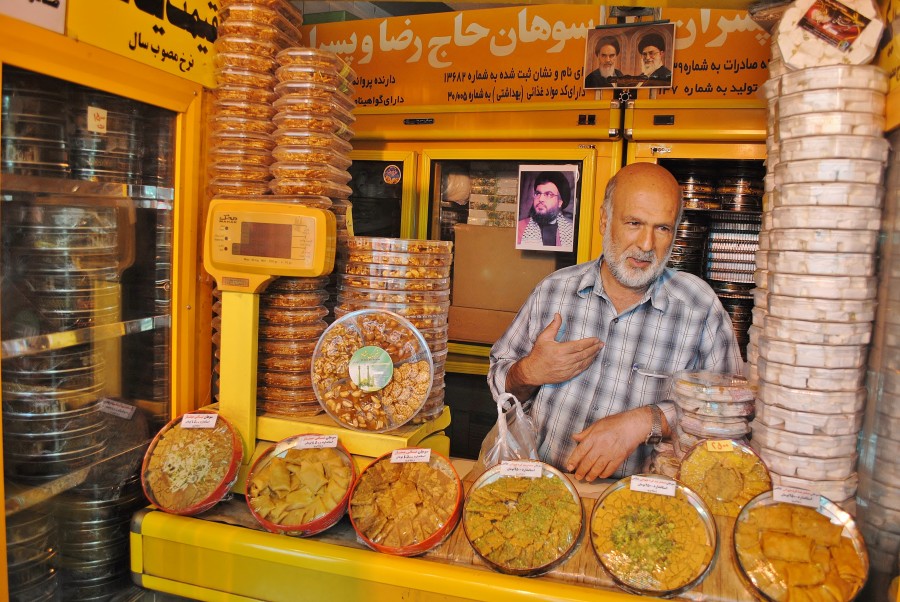
Persian sweets seller in Qom, Iran.
- Looking at some Arab countries I see “zombies” that will kill in the name of Islam. In Iran, I talked with many young people who smoked cigarettes before the mosque and openly said “fuck Islam” and “fuck Khomeini.” Many Iranians do not want Islam, they want to dance and they want to drink beer.
- In Iran there is no problem with transportation because every car is a potential taxi.
- The most popular car in Iran is the French Peugeot 405, which, due to its long years, does not always have a Peugeot engine. Still, the bodysuit makes an impression on the ladies.
- Iranians like to talk to tourists even if they speak only in Persian. At Kerman they all wanted me to say “hello”.
- From what I have seen, the Iranians regard the Arabs as subhumans. Well, I was in France, the Netherlands and Scandinavia so I understand them perfectly. Naming a Persian Arab is a great offense.
- I have the impression that hatred of America is a part of pop culture, while Israel makes everyone sick, and the Iranians do not even like to talk about it. However, everyone likes Hitler because of his approach to the Jews.
- An absolute hit in the liberated version of Persian Islam is “temporary marriage.” The couple is getting married for a fixed time, doing well, and talking for hours at a fixed time.
- The Muslim darkness of all the Arabs, Pakistan and other extreme countries burns the churches and persecutes Christians. In Iran, however, Christians are good and several churches with their beautiful frescoes belong to the riches of world culture of UNESCO.
- Censorship in Iran is so horrible that many websites do not work, including mine. Fortunately, the Iranians are censoring.
- Persian food is very tasty, but the Iranians are firing their feet to promote American-style burgers.
- In Iran the price of a White man is the same in all museums and tourist centers.

Fruit stall in Iran.
- Although in the Islamic Republic of Iran, the first violin is played by Shi’ite Islam, the ancient religion / philosophy of ancient Persia, known as Zoroastrianism, is very interesting and requires deeper knowledge. I recommend the temple in the city of Yazd and in the Chak Chak mountains, although I also saw a very impressive one in Baku in Azerbaijan.
- Especially in Tehran, I have seen many women with patches on their noses. Well, Iran is a popular country of plastic surgery and specializes in noses. When these operations are performed in Europe, women hide from it, while in Iran they wear bandaged noses as if they boasted that they could afford surgery.
- By the way, I would also like to mention the naive fairy tale for children told by America called the “axis of evil”, and the alleged threat to the world posed by Iran. Well, I looked at the map of US military bases in the Middle East and it turned out that America has more than 40 such bases around Iran. In addition, the US also has a navy in the Persian Gulf that carries nuclear warheads, there is also a military base Israel and Saudi Arabia fighting for domination in the region, which would like Iran to be destroyed. Meanwhile, irrespective of Iran’s dubious allies and false propaganda, Iran ranks 14th in the world’s firepower in 2022, according to Global Fire Power website. So Iran has no way to threaten the West and the launch of nuclear weapons automatically launches the same weapons on the other hand, which would be suicide for Iran. So, taking into account all these facts, let’s think who is the real threat to whom? Let us also consider why Pakistan was not prevented from reaching nuclear power? Because Pakistan is not a problem for Israel … but it might be someday.
The eyes of an Iranian traveler are a great adventure, but being interested in a deeper country is embroiled in a regime that will come many times in my relationship with the expedition. Iran is a rich experience, but dreams are not often fulfilled, and freedom is like socialism in which poverty is divided equally. In Iran so everyone is “equal”. I also do not want anyone to think that the regime is only in Iran because in my opinion there is no single free country in the world. I am more interested in the extreme left-wing, ultra-liberal regime of the European Union, and the one in Iran is Iranian.
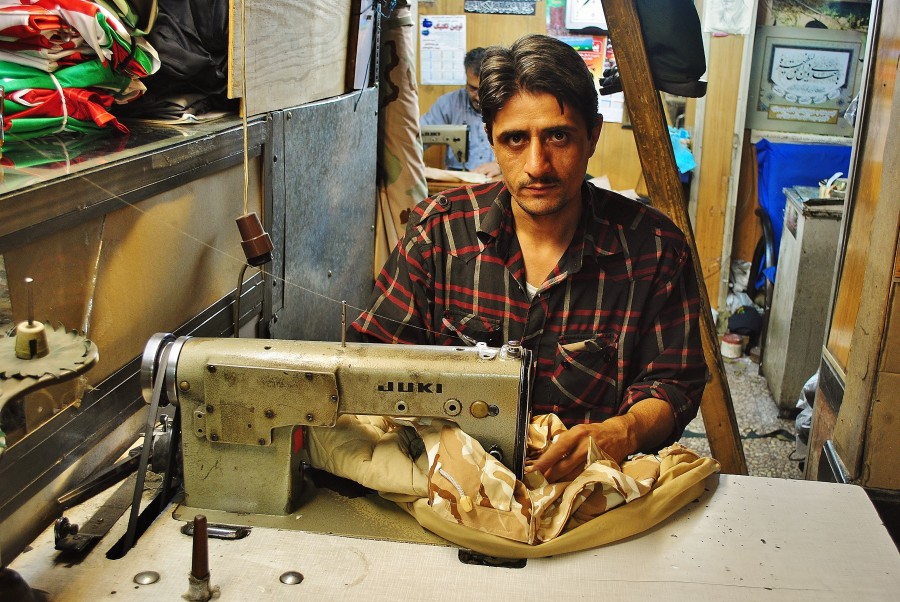
Iranian tailor.
Norduz
(My impressions of this particular border)
From the Armenian border I walked about a kilometer through the area “decorated” with barbed wire and guard towers. While every other border in the Caucasus and elsewhere in Asia looked peaceful, the Iranian border seemed prepared for war. There were armed soldiers who checked my passport several times during my dear life, but probably only with curiosity. The others gave me a piercing look that made me feel like a CIA agent in disguise. The Armenian-Iranian border also offers beautiful mountain views, which provides good protection against land attacks, but on the other hand also provides effective protection for helicopter pilots. There is a shallow river on which there is a bridge. After about half an hour of lovely views, with lungs of pure air I reached the concrete slab where I saw posters of such gentlemen as Khomeini and Khameni. There was a border crossing where the gentleman in the window smiled at me in a professional, learned manner, carefully examined my passport and then began to ask questions. First of all, why did I decide to come to Iran, what I want to see here, and whether I was in Israel. Then my passport looked at three more people and after a 20 minute interview and after overtaking my backpack I heard “Welcome to Iran”.
After all I sat down and talked with the taxi driver about the transport.
Too bad you can not send a postcard from Norduz. Something in the style of “Norduz – mountainous border where Khomeini developed barbed wire in the name of Allah.”
Transportation from Norduz to Jolfa
The Norduz border has no buses so a taxi or donkey is the only option. As for the transport it was 40km I did not see any cars. Jolfa is on the way to the border with the Azerbaijani Naxcivan enclave, so at the end of the trip I saw a couple of trucks. By the way, Naxcivan is able to survive the small border with Turkey and Iran.
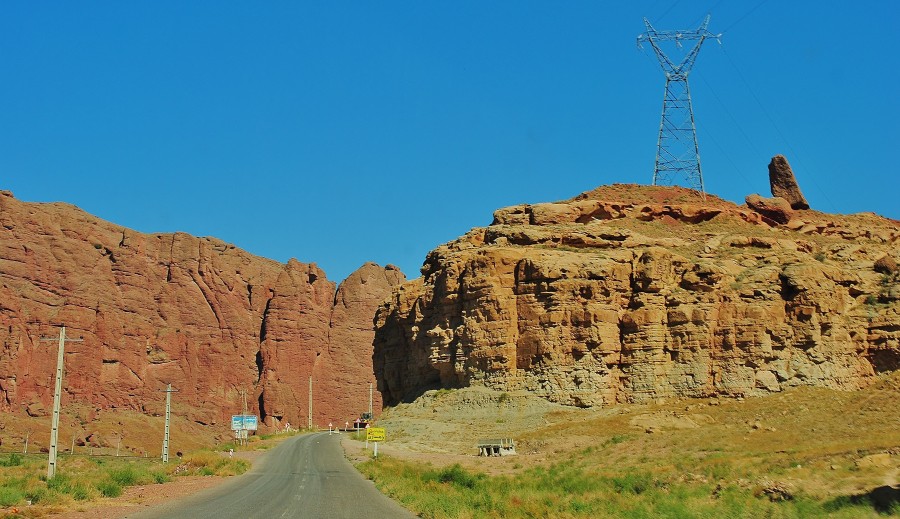
Iran mountain landscape.
The journey took about 40 minutes and the fee for the entire taxi cost $ 12. Fortunately, there was another passenger with whom I shared the cost.
Jolfa
Jolfa is a small town in the north of Iran lying near the Naxivan Azerbaijani enclave. I was not going to come here but the border crossed late and that was why I had to spend the night here. I quickly found a cheap, cheap hotel where I paid a double bed in a double room 150,000 rial. Jolfa was my first impression of Iran despite not having anything interesting to see. Still, for me it turned out to be a very interesting place, even exciting because I was in a new country. People asked where I was and besides, I shook a few hands and went to shish kebab which in Iran is a lot. In Jolfie there are several fruit shops on display with bored sellers who probably spent their lives in the store. There is also a green roundabout with a fountain and a couple of bazaars.
Being here for the first time I got acquainted with the opinion of the Iranians about their new president.Although President Rouhani held office for only three months, he was considered a good leader by the time he disliked Ahmadinejad. They could not understand that the evaluation of the new president was still at the time.
I will always remember Jolfa.
Transport from Jolfa to Tabriz via the Aras Valley and Stephanos Cathedral
The transportation itself from the bus station is cheap but I wanted to see what else in the region and given that I had a taxi passenger from Japan I could share the cost. Traveling through the picturesque valley and the river Aras, the hour before the cathedral and then transport to Tabriz Peugeot 405 cost us $ 25 half and took 1.5h.
Monastery of St. Stefanos is an Armenian monastery that was built in the 9th century and is located 15km from the town of Jolfa. Although the construction began in the 9th century, the monastery was destroyed by an earthquake and was built until the 12th century, mixing styles, including Roman and Greek. In addition to the sacred object of great historical value, it should be added that the monastery is surrounded by defensive walls and is also surrounded by mountains, which for centuries gave it safety. The whole building is built on a rectangular square with two thick corners. The church has elements specific to the Armenian monastry. The narrow corridor leads to the entrance, but the churches themselves are also impressive from the outside because of the carved reliefs of Mary and Jesus and numerous designs.Monastera Stephanos lies on the Azerbaijani border and is a wonderful example of our Christian art. This place is also a UNESCO World Heritage Site and as a proud Catholic I admit that the presence of this church in distant Iran has given me a lot of pleasure. While here I advise you to go around the monastery and climb the mountains to have a better view.
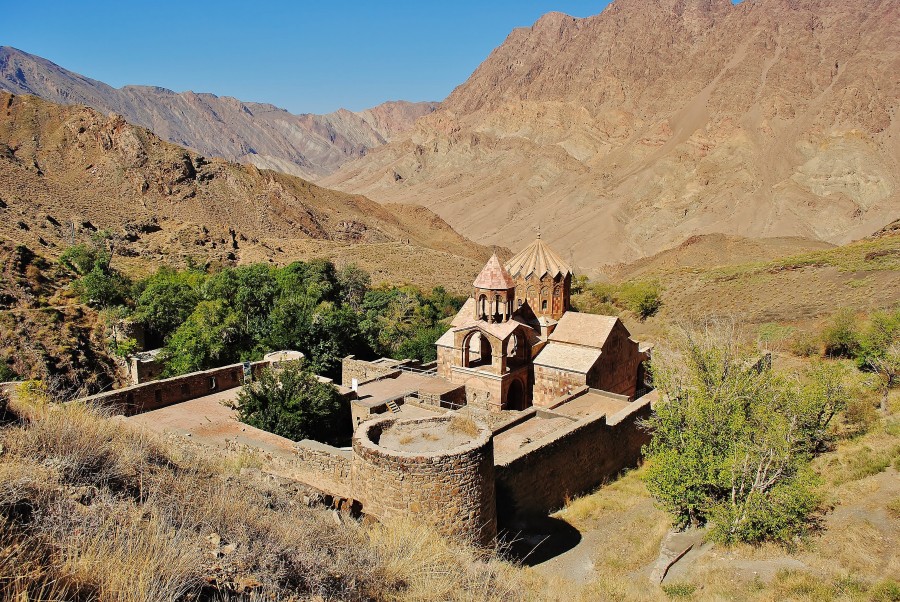
Iran – Stephanos monastery.
Tabriz
Tabriz is the fifth most populous city in Iran and the historical capital of Azerbaijan and the current capital of the East Province of Azerbaijan. Interestingly, the first language in Tabriz is not Persian but Azerbaijani because most Azerbaijani do not live in Azerbaijan but in the east of Iran. According to official sources, the Azerbaians of Tabriz are well integrated with Iran, with its politics, culture and literature, although in my opinion the city is not exactly Iran. Definitely there are many typical Persian objects as well as some churches but these are the Azeris with Turkish roots pretending Persians. No matter what, Tabriz is an interesting introduction to Iran and has a very good traditional bazaar which was included in the UNESCO list in 2010. Tabriz is also very important for Iran’s economy and education as it has a car factory and parts there, an important foreign investment city, a second Iranian university, an important industrial center, and, oddly enough, Iran’s healthiest city.
Tabriz usually acts as the first impression of Iran because it is here that buses come from Turkey. The driver dropped me off at the center and after a short walk I reached the Bargh hotel, which was very far to the luxurious and overpayed because it cost me 250,000 Rial per night. Recalling all the Asian holes I’ve been through I wonder sometimes whether there is a possibility of classifying hotels from zero stars down, because if it’s I’m sure I was there. In Tabriz I spent a lot of time at the old bazaar and watching people and strolling women wrapped in black sheets like a sore finger. Some of them, young girls smiled at me, but these were usually dressed more in Europe and they had scarves to half their heads and sleeves to half their elbows. This is a clear signal that many women in Iran are dressed up to satisfy Muslim law while denying it completely. In Tabriz I spent two days and at the beginning I was only in town.
I was at a vegetable market, a military store, a street shoemaker and of course a pub where shish kebabs were served with rice. People were always very good at me, those who were able to speak English were always willing to talk and I admit that Iran immediately fell in love with me. The only exception was the fact that for a walk around the city I went in shorts and some people turned my attention and pinned my fingers and others laughed at me. I realized that wearing shorts was an unfamiliar habit in Iran but I wanted to also check the reaction.
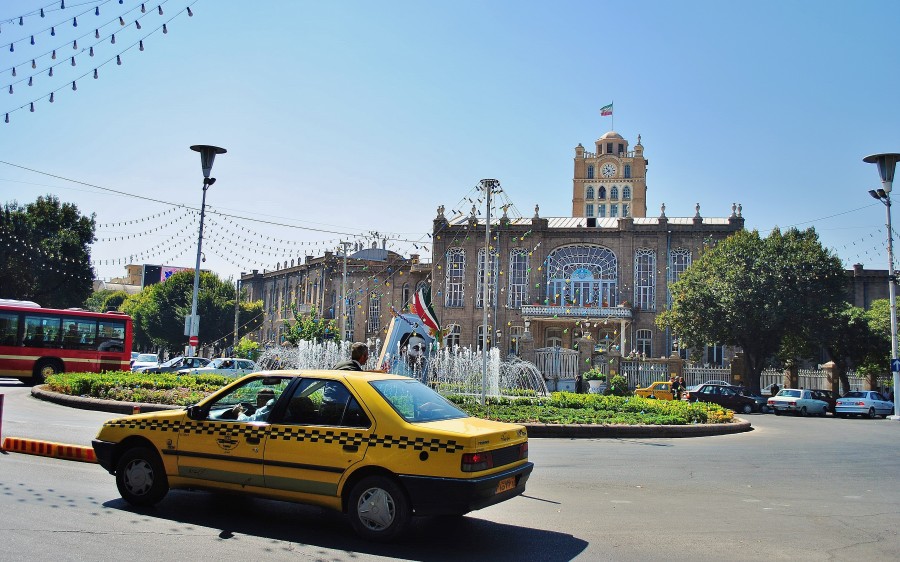
Tabriz, Iran.
Of the many places I saw, moving through stalls full of dates, exotic fruits and spices was very interesting was the Museum of Azerbaijan . On the first floor were coins, bas-reliefs, everyday utensils, utensils, jewelery and a copper helmet, which was 3000 years old. The impression was made on me also stone reliefs in the shape of women’s purses and jewelery boxes. In the basement there is an exhibition which belongs to my favorites. This is a collection of huge sculptures representing the imagination of people in the 20th century. In this part of the museum I spent most of my time and made the most of my photographs. These sculptures are impressive because they reach the depths of human feelings. The Azerbaijan Museum is a historical-archaeological museum and it is a large collection of Azerbaijani culture.
I was also in the Blue Mosque built in 1465 but also completely destroyed by earthquakes. Since then, this mosque was completed and it took the architects 25 years to cover the entire huge building with blue tiles.Today, this property consists of a large mosque with its two domes and huge stone gates, although there are only traces of blue tiles. The brick structure was rebuilt in 1951 and it is in desert color, although the “blue” name of the mosque was. In the same place there is a park, a square where young people play football and a corridor on one side covered with stylish arches. Young couples meet here for a long time away from the religious police. From inside this mosque is also glamorous and has a lot of blue and many decorations and carpets on the floor. Being outdoors and looking at the setting sun I met students who spoke English and complained to me about Islam. They said they had a pretty Muslim regime and I did not believe in the propaganda of hatred against Iran.
Another object was Arg-e Tabriz, a huge concrete arch in the Muslim style, whose foundations date back to the fourteenth century. At one point it was used for execution, and nowadays, there is a newly built Moselle Mosque , another great facility that could, for example, be a hospital or a school instead of another mosque. Among the many sights, old streets and three churches, the bazaar is the most interesting. This traditional bazaar, which dates back to the 15th century, is a labyrinth of many colors, tastes, spices and, of course, carpets. It occupies an area of 7km², has 24 separate caravanserai and 22 enormous decorated domes. Entering the bazaar is more of an adventure than a museum because its architecture and bazaar culture itself have been deeply rooted in Persian culture for thousands of years.
Every tourist discovers the labyrinths of the bazaar on their own and from the vegetable part, through the spice to the huge section of the carpet we feel we are in another world. The traditional Persian bazaar is, among other things, what remains of Antique Persia and it is a breath of freshness compared to the Islamic republic. Every corner of the bazaar has its own story and everyone is a work of art. In one of the 22 chalets you can drink Persian tea while sitting on a Persian carpet and watching the intricate mosaic on walls running to the top of the decorated dome. In addition, you can buy jewelry, shoes, copper pots, natural medicines and medicinal tea. So we can say that the traditional Persian bazaar is a separate town in the city. I will add that there is a tourist office near the main entrance where a well-informed and English speaking man is working.
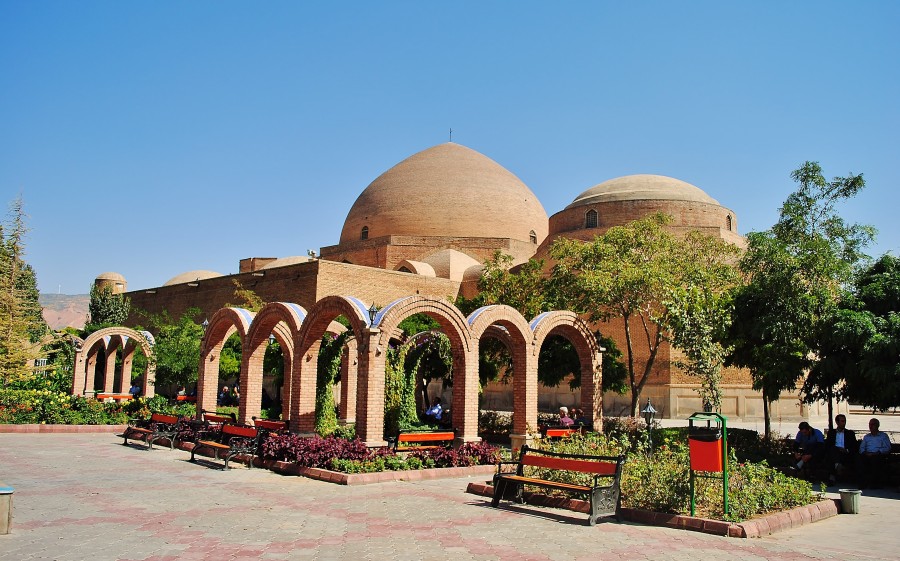
Tabriz Blue Mosque (Masjed-e kabud). Iran.
In Tabriz there are also many other museums and facilities that you can see and some are less and some more interesting. Places that I have been happy to miss are the Koran Museum, the Mausoleum of the Poets and the University of Islamic Arts, although for the purpose of strengthening my Christian spirit I recommend churches. Near the bazaar there is the church of Sts. Maria of the twelfth century about which Marco Polo himself wrote. If anyone has the time and I would like to recommend also a 8km excursion for Tabriz to Elgol Park , which with its pond and Qajar palace is a popular place for rest.
Returning to the hotel in the evening, I still had the pleasure of talking with a cop who asked me a lot of questions about what I thought about Iran and reminded me that walking in shorts is not the habit.
Tabriz is a very interesting city of the first impression of Iran, which I most recommend.
Kandovan
Trip to Kandovan is one that should not be missed while in Tabriz. Kandovan is a village in the rocky remnants of ice cream wafers and boasts a traditional life of the people. You can see people dressed in traditional costumes, such as squads, souvenirs made on the spot such as clay pots or carpets from camel hair. This town is the equivalent of Turkish Cappadocia or Aristocratic Goris because in all these cities are the same pointedly completed rocks converted into rooms. The natural architecture of Kandovan is located on several floors and leads to narrow stairs leading to each. In some rocks there are flats and other shops, although the prices in this tourist town are not pleasant.
From the top of Kandovan you can see the steep roofs, climbing tourists and locals, the river below, numerous tea rooms and Mt Sahand (3707m asl).In addition to the donkeys and memorabilia, one can also find paintings of Khomeini and Chamenia on one of the walls. People were business and friendly. I bought a used camel hair carpet for a small amount of money, probably because the juice that the seller drank was heavily fermented.
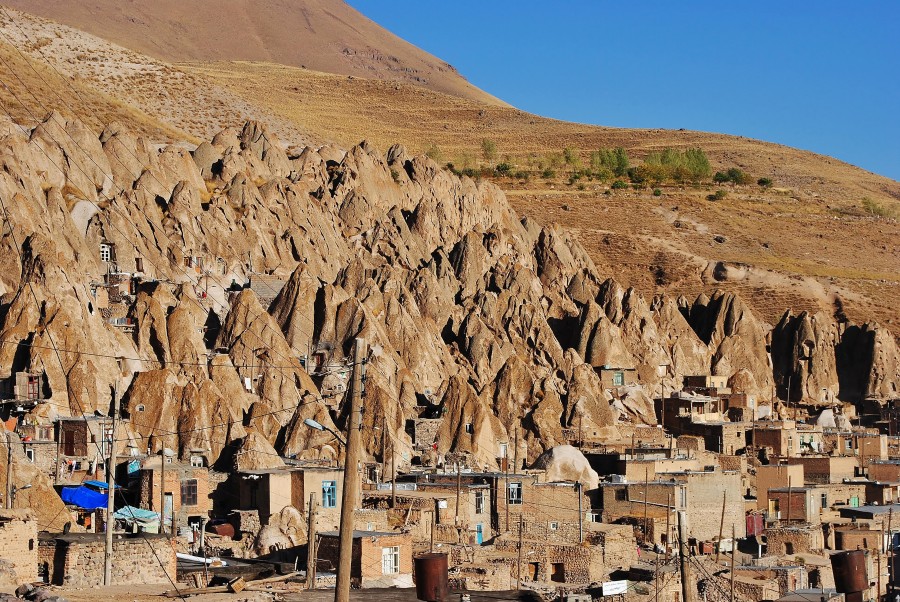
Kandovan and its houses carved into the rocks. A very glamorous place, similar to Cappadocia in Turkey.
I saw Kandovan in four hours even though one or two would be enough. With Tabriz I took a taxi back and forth for what I paid 500,000 Rial which means I was very overpaid because the same night I wanted to get to Tabriz bus station to get a night bus to a new place. Usually the shared taxi from Tabriz costs about 100-125,000 per person but I was alone because I bought all the places. The cheapest way is to take the minibus from the center of Tabriz for about 3000 Rial (1h) to the Oks and the next 25km to Kandovan ride the shared taxi for about 40-50,000 Rial plus about 15-20.000 per hour of waiting. The prices I gave from Oksu are in both directions but unfortunately the last transport from Oksu to Tabriz is around 6 pm. There is still a hitch.
If anyone wants to stay overnight in Kandovan to see the nature around and cultural enrichment you should either ask about cheap accommodation in one of the shops or tea rooms or spread the tent behind the town which I highly recommend.
Transport from Tabriz to Rasht
About 10 pm I got into the night bus to Rasht for 150,000 Rial, at the end of my tour also going through the Iranian coast of the Caspian Sea (Bandar-e Azali). Unfortunately my last impressions were so tiresome that I fell asleep on the bus and woke up only 45km behind Rasht. So I went on the road and tried to stop the hitch, the more so since it was my only option to find any transport. I realized that the sight of the White Tourist on the Iranian speedway was comparable to the two-headed unicorn view, so those who did not want to stop at least slowed down to look at me. Finally someone stopped and took me to the suburbs behind Rasht and then also to Shohaday Gomnam Square from where very heavily used buses to Fuman .Unfortunately, after arriving I nearly beat up the driver for the money until about 20 Iranians ran. In the end I paid 150tys rial and parted in the room.
Rasht
(My adventure in the city in which I was not supposed to be)
The city of Rasht is not breathless and it is not a tourist destination. Rasht is the capital of the province of Gilan and in my opinion it is a big, noisy and uninteresting city. I went here to get to the village of Masuleh, which is a famous tourist destination from Iran and now also from Poland. When I got to Rasht, I realized that I was losing money so before I went further I first had to do the necessary thing. I went through the streets of Rasht looking for Milli’s bank, but when I finally found it, they did not exchange money there because it was not the main branch. The bank chief was nice enough to order me a taxi and paid a R $ 20,000 driver to take me to the center of Rasht to the main Milli branch. However, I remembered that the bank rate was very unprofitable because on that day the rate was less by about Rs 6000 per dollar so at the exchange of $ 100 it was the amount that would put me in a bad mood. Fortunately, I had a map on which were all the private bureaux offering higher rates.
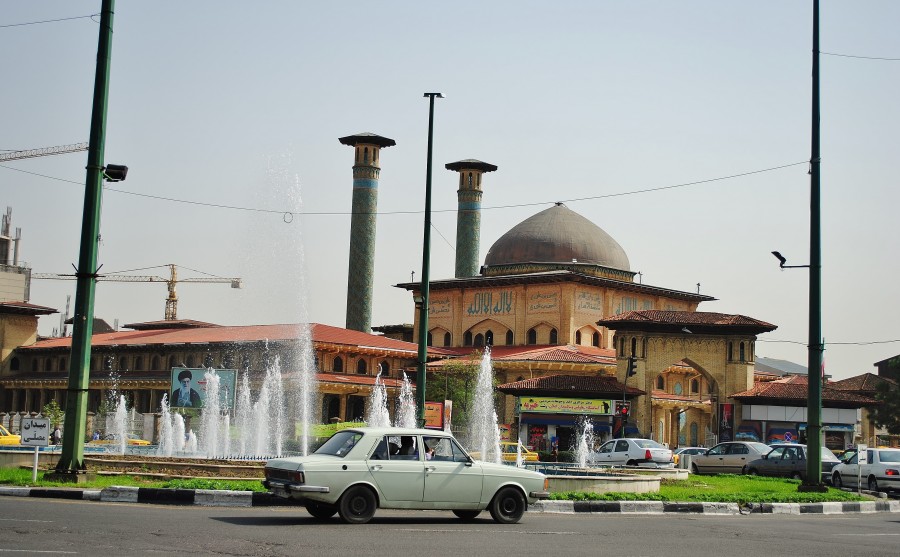
Traffic in Rasht. Iran.
I was lucky because 10 minutes walk from the bank there was a money exchange with a course that put me in good humor. I do not remember his name, but I remember that the girl was working in a cash register, but unfortunately with a head wrapped around like a victim of a car accident. Then I settled down to one of the many shared yellow cabs and the circular road, feeling like in the movie “Lost in translation” I reached the intersection I have never seen. Fortunately, the next taxi took me directly to Shohadad Gomnam Station and I admit that I never expected that sight of this nasty, dirty hole will give me such a great pleasure. In the last category for people and the first for rats I ate shish-kebab and drank tea and then got into the rusty bus going to Fuman.
So everything worked out fine, but it would have been better if I did not sleep first and then if I had the money.
Transport from Rasht to Masuleh
Firstly from Shohadad Gomnam station I went to the small town of Fuman (40 minutes, 40.000 rial) and then joined me an Iranian family with whom I went to a bus stop about 1km. From Fuman I got a bus to Masuleh (0.5h, 15.000 rial).
Masuleh
Masuleh is a very popular mountain village with at least 1000 years of experience. Masuleh is a tourist town in the mountains where clay houses are built one on top of each other and are squeezed in such a way that the roof of one house provides a passage to another or a viewing terrace. There are plenty of small souvenir shops, with local sweets, tea rooms and small restaurants. The streets are so narrow that the crowds of tourists can barely move and the prices are very high. Many times I went upstairs and then went downstairs and every time I devoted my attention to something else, just as the people in Masuleh were paying attention to me. Many also wanted to talk to me about Europe and their relationship with America, but quality no one wanted to talk about Israel because it was the Iranian word for it.
Noteworthy are two museums in Masuleh and a very old mosque with two small minarets. Although the town itself can be seen in one or two hours I stayed here for a better night to get to Masuleh. Firstly I wanted to find a place in the hotel but one was very expensive and the other was already full what the season often happens. The same Iranians with whom I came helped me find a place, but it was certain that I would spend the night in a tent.In addition to the interesting architecture and the very original character of Masuleh, this beautiful village is surrounded by hiking trails and tea fields, and for many Iranians, this is the place where they escape from the city. I spent the night in a tent in the mountains and in the morning I washed in the river.
Before leaving I also had a nice meeting with two Poles who studied iranistics and did not first travel to Iran. They poured my tea and they were nice.
I think Masuleh is a place to go to, even if it is not easy to get there.
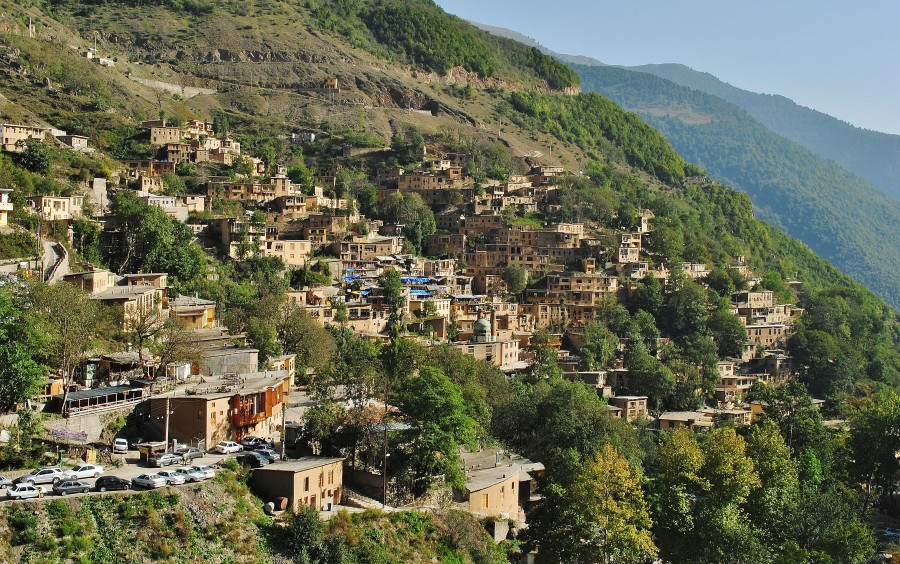
View of Masuleh. Iran.
Transportation from Masuleh to Qazvin
After a morning tea and a small bath in the river I rolled up my tent, picked up my backpack, and luckily I saw a shared taxi on the bus stop. Missed one passenger to departure so I gladly paid 25,000 Rial and after about 20 minutes I was in the center of Fuman . Then the passenger of the shared taxi made me polite because he took me a few kilometers to the tragic bus station. We all waited with hope that we will leave Fuman and I was lucky because in 2h arrived a bus going to Tehran. There were only 7 vacancies in it but the lady with head covered was so nice that she sold one of Europe’s tourist tickets. I paid 150,000 Rial and the ticket price was included a small snack. I admit that the bus was also very good.
I also noticed that wherever I was in Iran people looked at me with astonishment, as if they wanted to ask me why I came to Iran, to a country that suffers from Zionist propaganda of hatred. One lady who did not know English wanted to make contact so she gave me an apple. After a two hour drive the driver blew me off on a road near Qazvin from where I took the bus to the city, to the Buali Hotel.
Qazvin
(Great passport mistake and police case, complete chaos of the Iranian administration and about how the police took me as a spy.)
Qazvin is not a tourist center although it still has some monuments that are able to fill one whole day. For most travelers, including me, this was the base for Killers Castles and Alamut Valley . At first I was going to spend only one night here and the next day to take a trip but fate complicated my life. First of all because of a stupid hotel receptionist and then because of a cop who also made a mistake.
Upon arriving at the cheapest hotel called Buali for 150,000 Rial per night the receptionist stated that my visa is no longer valid although I was sure it was the opposite. The Iranian Consulate issued a visa where everything was written in Persian and I could not prove that I was right. First the receptionist drove me from the hotel because I was in Iran “illegally” and then let me spend one night. In hotels in Iran it is customary to leave a passport at reception so in this case I was not sure if the police would knock me in the night.That evening I had enough sensation, so I went for a delicious Persian dinner.
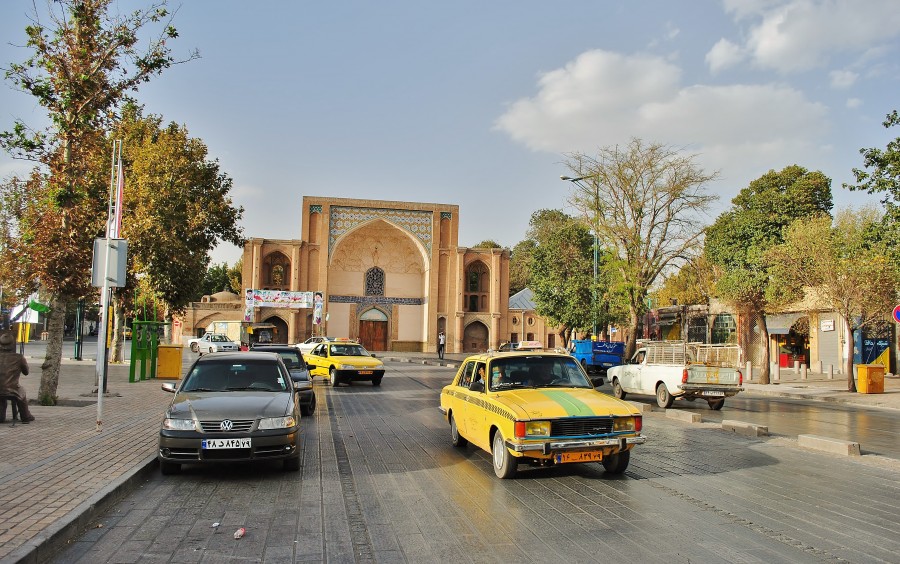
Traffic in Qazvin. Iran.
I was served rice with butter, shish-kebab, and lots of vegetables and tea. I do not know if I paid only Rial 70,000 or about $ 2 for the whole thing. Persian food in this non-touristic casual place was great and very cheap. After a little shopping in the neighboring shop, I went to my cheap but nice Buali Hotel. The receptionist gave me a cold look because I was in Iran “illegally” but on the other hand I didn’t want to explain something to him that he couldn’t understand anyway. I just wanted to relax and go to sleep. The next day I was told at the reception that my passport had been taken by the police, but fortunately the policeman left a note in Farsi that it could be picked up after the matter was cleared at the police station. So the policeman checked my visa and also stated that it was invalid because the receptionist told him so. This was the time when the real problems had just begun, not because of the passport, but because no one in the police administration spoke English.
I thought that there is no point in going to the police without an interpreter because it would be a pointless conversation. So I came up with the idea to go to the tourist office first, against the receptionist’s recommendations, because someone who spoke English had to be there. Besides, I quickly became famous in the area because after leaving the hotel the shopkeepers already knew me and showed me the way to the police. One even wanted to give me a ride there for free. So it was clear to me that there are no secrets in Iran and every shopkeeper, taxi driver and hotel receptionist is a free spy, without even realizing it. The environmental interview in Iran is a dream come true for every policeman. When I got to the tourist office, which is located near the historic Rah Kushk gate, I realized that unfortunately the English of the women working there was very limited. So I had to wait for a man who spoke English and he promised to help me. First we went to ask for advice from the Ministry of Foreign Affairs but it was a waste of time and the clerk was a fag and unfortunately this plague is spreading all over the world.
So we took a taxi to the police and there it turned out that they had my passport but that the visa was invalid, they could extend it anyway because in Iran it looks like this. We went to the bank, I paid around 300,000 rial for a new visa, then we went to the photographer for 60,000 rial because I ran out of photos and finally back to the police station. However, there was a lunch break, so we had to wait half an hour. When they finally opened the great iron gate, they brought in the suspects in handcuffs, then the refugees from Afghanistan, who were also illegally, entered, with me and my interpreter in between. When the policeman dealing with my case received the confirmation of payment, he looked at my passport again and stated that I am in Iran legally because my visa was valid for another three weeks. My case was such a shame for the police that first they called the hotel to tell the receptionist that he was stupid and then one by one I shook the hand of the most senior policemen who looked at me in the eye, then at the passport and said that as soon as I paid, they would give me a new visa for another 1.5 months.

A tomato vendor in Qazvin. Iran.
Just in case, I asked an interpreter to look at what the cop had written in my passport and it turned out to be wrong, because he had extended my visa for only a week. The policeman curled up again, caught his head, and added another extension of his visa for another month. Then I even checked with my translator my passport because neither the hotel nor the police could count on it. Upon returning to the hotel with a prolonged visa, the receptionist apologized to me on the doorstep, but for me it was all because my whole day and the previous evening were nervous … after all I was right even though I could not read the farsi language.
I realized at the time that in Iran, none of the officials knew what he was doing and did not focus on his work, and the receptionist was an idiot. I have no idea how Iran works, but if America ever wants to conquer Iran, then I think they can do it not through military war but through official war.
After I was sure that I was in Iran legally, I decided to spend another day in Qazvin. From now on, I wanted to see the city and try local cuisine. Coming back from the bazaar is always a good way to observe people. I was walking with a map in hand to find an object called Chechel Sotun. So I asked for two young women who helped me find the place I was looking for but ran away when they saw the police. All they needed was a glance, and the girls did not even say goodbye. The Muslim regime treats very suspicious Iranians walking in the company of White men because they may be either their potential lovers or spies. They led me to a small park in the center of Qazvin where there was a small palace built in 1510 called Chechel Sotun.
In Chechel Sotun there is a very interesting (to my surprise) the Calligraphy Museum , where mosaic-colored stained-glass windows contain frescoes and murals and showcases with ancient Persian calligraphy. The name Chechel Sotun means “40 columns” because it refers to 20 wooden columns reflected in the water mirror which doubles their number. The calligraphers were interesting to me even though I did not know Persian. Chechel Sotun Palace and the park are also recommended in the evening when it is lit.

Fruit stalls in Iran are a common sight. The fruit are always fresh and cheap.
Shortly afterwards I went to the Qazvin Museum where I saw an exhibition of modern art and ceramics from the valley of Alamut. As in all cities in Iran there are nowhere to miss mosques, which in my opinion is also a place for social gatherings. One of them is the Jameh Mosque , which is built on a square square, has huge stone gates and domes and mosques with blue mosaics. In addition there are around the chambers whose entrances are decorated in traditional Iranian architectural art. This is a huge, monumental place and the evening when I came here was an absolute void. On the way from the mosque I stopped in the streets and it was clear that people were looking for contact with me. Before the mosque is also a pleasant square with benches.
The second mosque is Al-Nabi , which is built in the same style but with the difference that the entrance leads down the long street. In the middle there is a long fountain, which unfortunately is mostly dry as chips. Another small Muslim complex called Imamzadeh-e Hossein , whose front was built in the 16th century in the Qajar period, has a large blue dome, decorated pillars and mirrored tiles. As usual, this object is visited by women in black sheets and people who are embroiled in Muslim nonsense.
Although the Qazvin monuments, which belong to medium-sized objects, are enough to fill one day, however, I admit that the best way is to observe the city, observe people and feel the character of the city. I also happened that at a police demonstration in the streets of Qazvin I took pictures of them and although some police officers even proudly posed for me, but when they saw their commander immediately round me, then I had to get into the police truck and delete my pictures. As for the city, I had mixed feelings. On the one hand I happened to have a passport affair, on the other I had problems with the police because of the women and then again the problem with the police because of the photos. But there was a pub near my cheap hotel where they served excellent Persian food.
Whilst in Qazvin I also went to use internet, where I learned that many sites including mine are blocked for political reasons. The Iranians are trying to live somehow because they have no choice but to remember that life under Islam is a psychological torture. If anyone has time to see Qazvin but for the most part it is still the only starting point for Killer Castles and Alamut Valley . I will not return to Qazvin because the local police, too nervous, know me too well.

Qazvin. Iran. Please pay attention to the mosaic on the walls.
Trip to the Castle of Assassins and the Alamut Valley
Due to its isolated beauty, magnificent scenery and old castles, Alamut Valley is the most popular tour of Qazvin. Alamut Valley is an area between Qazvin and the Caspian Sea in the middle of the Alborz Mountains. In the eleventh century, Ismaili leader Hassan Sabbah converted the local population into his Islamic version and set up a vengeful and blood-stained Hashshashin tribe. Together with his people he has built several castles that are impressive because of their location in higher, inaccessible parts of the mountains. At that time, of course, it was of strategic importance, but today they are objects that the Iranian government is trying to repair.
Thanks to the huge contribution of construction forces in hard-to-reach places, the Hashshashin group responded to many attacks, but in the end, the Mongols under Hulagu Khana commanded the castles in 1256. Today, unfortunately, little remains of the castles but in any case it is a beautiful place offering tourists wonderful landscapes, a feeling of seclusion from the whole world, interesting mountain formations, lakes, rice fields, palm trees and serpentine roads. In the Alamut Valley there are also some small villages with very independent people because living in isolated Alamut is not easy.
The valley of Alamut can be seen in one day and from what I know is an option that most travelers choose.Those who want to spend a long time here can spend 3 days in the mountains, eating their meals and sleeping in tents. I’m sure it would be a fascinating experience, but difficult transport is also a challenge.Travelers who choose a few days will have to be patient. From what I know are irregular, free buses to the village of Hir by Razmiyan (65km from Qazvin) and also to Mo-Allem Kalayeh (about 90km from Qazvin) but the timetable is unfriendly to tourists. Unfortunately I did not hear that there was a bus to the most interesting castle near Gazor Khan so this option is dependent on hitchhiking or greedy taxi drivers at Mo’Allem Kalayeh. A few days is a cheap, free version and on the way hitch is also necessary, but on the other hand I think this option gives more joy and independence. The buses themselves are museums, which is also an adventure.
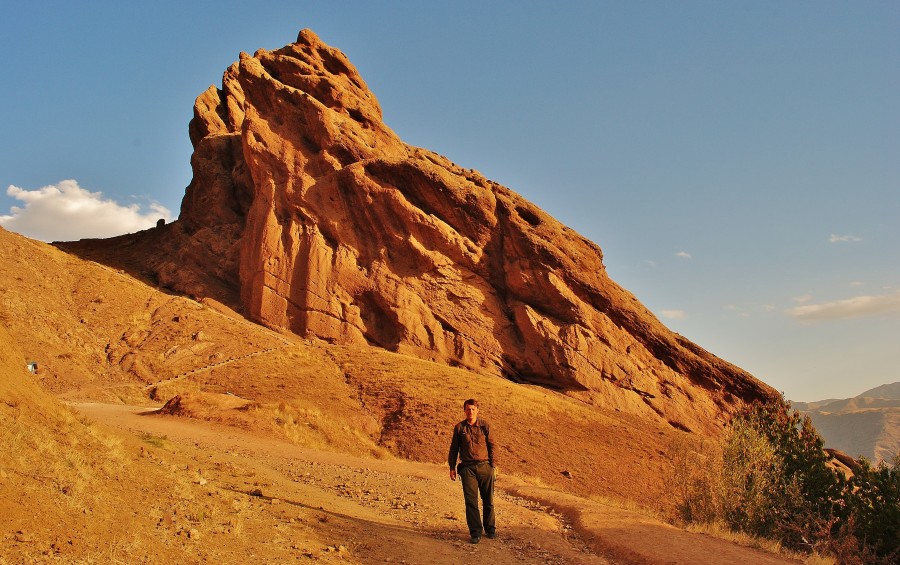
During my trip to the Castle of Assassins in the Alamut Valley. Iran.
If anyone wants to see the Valley of Alamut and all the ruins of the castle one day it is irreplaceable taxi (commonly called ” savari “). The Yellow Puegeoty 405, usually with a Peugeot engine, though not necessarily, departs from Qaribqosh Square in Qazvin, 2 km east of Valiasr Square. Unfortunately, white skin is a symbol of money and for an average Iranian even though a Pole is financially worse than a German or Swiss it is still rich. If I had a company of about 4 people this trip would be super cheap but I paid myself a magic sum of 600,000 Rial (about $ 15). I had to bargain, of course, but it is very important to explain to the taxi driver step by step what places are important to you and where to wait, because the taxi driver is going for his money and it does not matter for him whether he is carrying people or a bag of potatoes. I made the exact plan of my trip so that he could always look at him and at the bottom was also written price. This was very nice, I saw everything I wanted and on the way we took still local people.
My first part of the journey led from Qazvin, through rice paddies and the Shahrud Valley to Razmiyan.Razmiyan is a small village where there is nothing interesting, unless we are looking for a taxi for the next part of the trip. In addition, Razmiyan is in close proximity to the ruins of the first castle named Lamiasar .The driver dropped me off on a winding mountain road at Lamiasar’s plate, and then went through a dry, hot trail towards the ruins. At last I felt freedom and loneliness in the good sense of the word. I walked around the hills about 20 minutes to Hir until I reached some of the walls that once were the castle. I did not count on the great construction but the views and the adventure itself were worth the effort.
It is also important that there is no way to stray because the trail is well-marked. From the main route you must cross the riverbed and cross the river. After about an hour I got into the yellow taxi to stand for a while in Razmiyan and then went to Mo’alle Kelayer , also called Alamut . Mo’allem is certainly not a metropolis. It is a small desert hole with one street where there is a bus stop, a pub and a sculpture of an eagle and graffiti. For me it was the place where I came across the surrounding mountains taking pictures of the panorama of Alamut but those who have more time to recommend two short trips.

Alamut Valley. Iran.
One is Lake Evan and the other three red canyons on the road to Andean . As far as I know in Mo’alle Kelayer there are taxis (savaris) and free and occasional buses to Andean. My route ran differently. I droveto the village of Ghazor Khan to get to the ruins of Alamut Castle , which is located on an attractive cliff and is definitely the most spectacular point of this valley tour. The uphill climb is approximately 700m from the village and the path leading to the cliff is more than obvious. From the village to the top of the cliff I walked for about half an hour without hurrying and taking pictures. Up to now there is maintenance work, although I admit that the condition of the ruins is in some places so good that you can see separate rooms.Other than that, it is a flat space from which they are magnificent, picturesque views of the mountains and during the admirable walk are original rock formations. This part of my trip was the most interesting and gave me the best idea of what were the fortified Killer Locks and how hard it was to get them. At Gazor Khan you can sleep at your local host and have a meal, and in the morning get a Qazvin sandwich or a bus to Mo’allem Kelayer.
If I were to take the same trip again, I think I would have decided to take a three day trip even though my friend was also very curious. More time to unveil the new Alamut Valley and let you get away from an ever-hawking taxi driver, even if one day is enough to see the most interesting objects. I would definitely recommend this valley.
Transport from Qazvin to Tehran
This transport would be cheap and fast. I pay only 40,000 Rial and after 2h I was on the spot.

Alamut Valley. Iran.
Tehran
(stay 1)
Description of Tehran centre
There are many different opinions about the Iranian capital. The most common is that Tehran is loud, crowded, chaotic, and overflowing with traffic that causes headaches. Some tourists do not come to Tehran at all and others come for one day and come again because they can not stand it. In a city that is home to 15 million people a lot is going on and it is fortunate that Tehran has a very well developed subway network without which transport in Tehran would be impossible. In my opinion, discouraging stories about Teheran need to be treated with distraction, because during my travel career many times I have found out that it is best to convince yourself.
Tehran is also the political and social cradle of Iran, has a huge traditional bazaar and objects related to the history and culture of the country and has many very interesting museums.Within the limits of the last metro stops is the newly built temple complex, which is the resting place of Khomeini and the cemetery of Iraqi Iraqi warriors, and to the north are the Alborz mountains with spectacular paths. The political transformations and revolutions usually founded by bazaars always start in Tehran. This city is very interesting to me, and the street traffic does not bother me so much because I am from Warsaw and I live in London. In Tehran I stayed a week and returned many times as some of the places are unique.

Azadi Tower. Tehran, Iran.
The bus blew me off at the western terminal of Terminal-e Azadi , which is located near Azadi Square and the famous Iranian political transmission tower of Azadi . This property is only a 10 minute walk from the train station and therefore I immediately went there. 50 meters The Azadi Tower is located on a green square cut by a pavement and was built in 1971 to celebrate the 2500th anniversary of the Persian Empire.This inverted Y-shaped tower and sophisticated modern patterns combined with traditional Persian culture also features a gallery in the basement and a lift that can take us to the last floor. The Iranian media very much like to show this West object during the revolution and the political message. When the Iranian people are unhappy and wants to smash the city, Azadi Square is always full. Then with my backpack I squeezed through the cars and the crowd in the streets for the second time and went to the subway station decorated with Ajatollach posters. How holy they are – I thought. It is surprising that they didn’t fly to heaven.
Being at the metro station, I saw that the place by the tracks was divided. One part was allowed for everyone to stand and the other part was reserved only for women, which I think might be a good idea. My last stop was the Imam Khomeini station where there are some of the cheapest hotels in Tehran, the Golestan Palace, the old bazaar, the Ebrat Museum, the National Museum and a couple of embassies and a shopping district. After going out on the street, I saw Tehran for the first time. I stood for a moment and then, walking slowly, I watched the people, their little shops and the fountain in the middle of the street.
I think that due to its proximity, the area near the Imam Khomeini station is of strategic importance for travelers and that is why I advise you to stop here. After a short time I got to the Mashhad hostel (from the name of the city) on Amir Kabir street and here I paid 150,000 Rial per night for a bed in a dormitory room. After that, I always came back here and also stored my luggage.
After a short rest, I went to a traditional bazaar , which I returned many times before. This chaotic, crowded bazaar is a city in the city, which also attracts those who are not interested in shopping. The bazaars are an important part of Persian culture and are not only commercial centers but also places of social, political, cultural and religious life. Decorated shops with silk, carpets, traditional sweets and spices attract the attention of the traveler, although there are also street bureaux, cleansers, tailors and manufacturers of cigarettes, copper pots, knives and even saddles. Apart from that, there are also tea rooms where I have contacted many Persians and I have answered many questions, because in Iran everyone is very curious why a traveler from Poland wanted to visit their country. With tea, near a small fountain, just behind the living room with hand-made carpets and a pack of dates in your hand can be very nice to spend time. In general, every city in Iran has its own bazaar but I recommend the best in Esfahan, Tehran, Tabriz, Shiraz, Yazd and Kashan. The Tehran Basin is 10 km in diameter and was named “city within the city”.
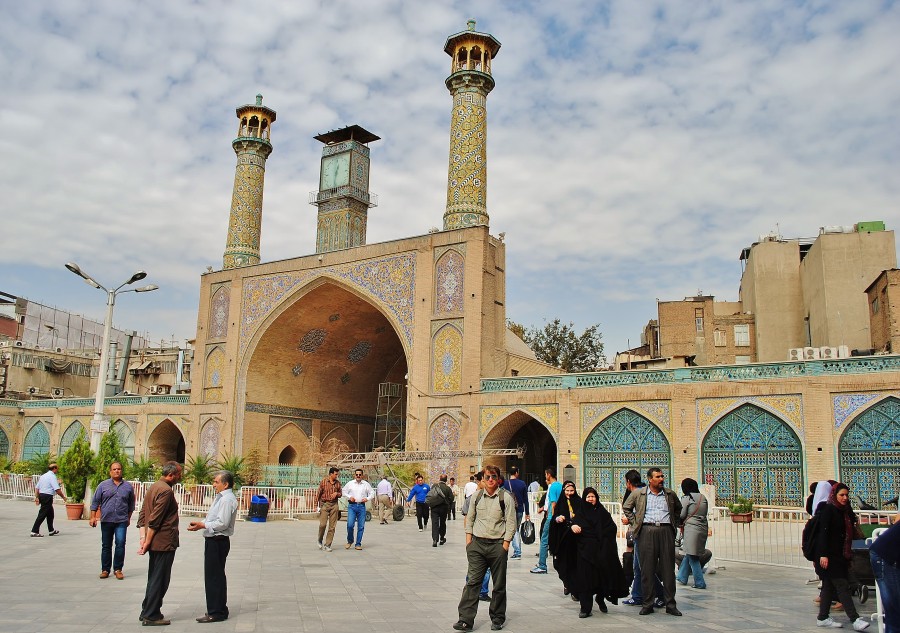
In the vicinity of the traditional Persian bazaar in Tehran. Iran.
Historically, despite the fact that the bazaar culture in Iran dates back thousands of years, the walls of the bazaar in Tehran are about 200. The maidens come here to find a husband, but also to make contact with a nice tourist from Poland, the faithful come to the Khomeini mosque to which he leads a lot of labyrinth goods. And those who do not have the money come here to take a loan with the sellers for a lower rate than in the bank. This is not a joke, however, because, especially in the past, it was the “bazaars” who gave loans to flats, cars and also for weddings. The bazaars have also grown for political purposes and are a symbol of Persian culture. Before the revolution some bazaars financed the Islamic revolution and being the center of social and financial life, the discontent of the nation from the government always first felt at the bazaar. On the bazaars I saw many interesting shops and sellers of things I did not know that I could sell, drink tea, eat kebab and a man named Jafar (name like Aladdin’s black character) helped me to bargain the price for the carpet. I assure every traveler that in Iran it is not the museums that are the places to go to but the bazaars.
As for the Khomeini mosque of the 18th century, it is in the middle of the bazaar and is one of the few to visit for our Iranian experience. It is a traditional sacral building with minarets, a water center in the center and walls decorated with mosaics, but what I am most interested in is the Muslims in prayer action. Due to their location within the bazaar, families come here for shopping, to eat lunch and for social purposes and then go to the mosque. One of the many entrances to the bazaar can also be seen horse-drawn carriages, flag shops and door-to-door salesmen of pretzels, donuts, toys and socks. There are also “Persian kittens” with curled sleeves and half-covered heads, who chuckled and laughed at the Polish traveler and were photographed. At the bazaar I was late so that day I ended up visiting Tehran. Besides, I did not want to hurry. In the evening I went to dinner, bought fruit and to my cheap hotel.
The next morning I sat down for a moment near the street vendor of tea and after passing the avenue of shops I reached Golestan Palace . Golestan Palace is a complex of several decorated buildings and carefully trimmed lawns, which are remnants of the unreasonable and even superfluous distribution of national wealth by the Qajar dynasty. While Persia struggled with many problems and construction was not even the top priority, the ruling class did not regret it. Pro-American Iranian Shah Reza Pahlavi has removed several buildings, but from a tourism standpoint, Golestan is another pleasant, secluded complex to see with low cost entry. It is worth adding that the monarch, who ordered the building of the palace ensemble, Golestan traveled Europe and was so enamored with our art that he decided to move the European style to Persia, linking it with the culture of Iran. The final effect is impressive because every building, every hall, furniture, entrances, sculptures, paintings and even every wall are works of art.
At the entrance you should also consider which object we want to enter because first you have to pay for the same entrance and then at the cash register for each building. Some of them are less interesting and I would personally advise against the art and European ceramics we have in abundance in European museums. The Monarch of the Qajar dynasty brought many exhibits from Europe and nothing bothered to see them but I was more interested in those buildings where I could feel like in Persia, not in France, for example. The building, which I recommend is the opposite of the kas near the long fountain called Ivan-e Takht-e Marmar . The entrance itself is an open bow decorated with glass mosaic and an impressive throne in the middle.
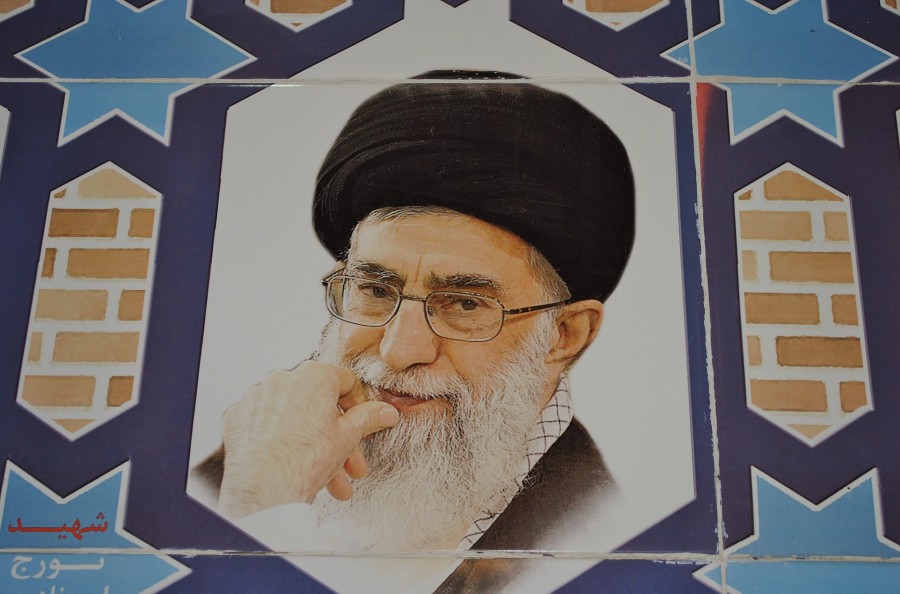
Spiritual leader of Iran Ali Khamenei.
The throne was built in the early 18th century and is supported by human figures and was built of 65 pieces of alabaster from the mine near Yazd. On the other hand, there are paintings of interest to the one with the snake. Another attraction I would recommend is the Negar Khane art gallery where you can see a collection of art from the Qajar era. Among them are paintings with monarchs wearing royal jewels. Other objects are an interesting combination of Persian and European architecture and gifts given to the Persian monarch by the rulers of Europe. However, the glass-mosaic Emarat-e Badgir and the cellar Aks Khanehwere also interesting with their pictures showing corpses in different phases of decomposition.
The entire area of the Golestan Palace is very busy and this property is also very interesting from the outside due to its architecture and decor. Even high ceilings, carpets, drapes, elaborate chandeliers, decorated ceilings, and fine furnishings are indispensable. Of course tourists can see all parts of Golestan but I do not recommend for example Talar-e Alams where there are 200 year old French plates.
I think it is quite amusing, that the desperate national treasures of the rulers of Persia wanted to have the shadow of Europe in their country only for the enjoyment of European tourists 200 years later.
After visiting this property I went to the bazaar for a small tea and then went straight to Park-e Shahr , a peaceful green area with a small pond and decorative pigeons in cages. Park-e Shahr is a true salvation for southern Tehran because it is a quiet place where I then went to work and to sit by the water. Around there are several small pubs with Persian food and in the park there are numerous activities for children. When leaving the park, it is important to pay attention to the great painting on the building depicting the partisan with the rifle. I think this is a good message for American tourists.
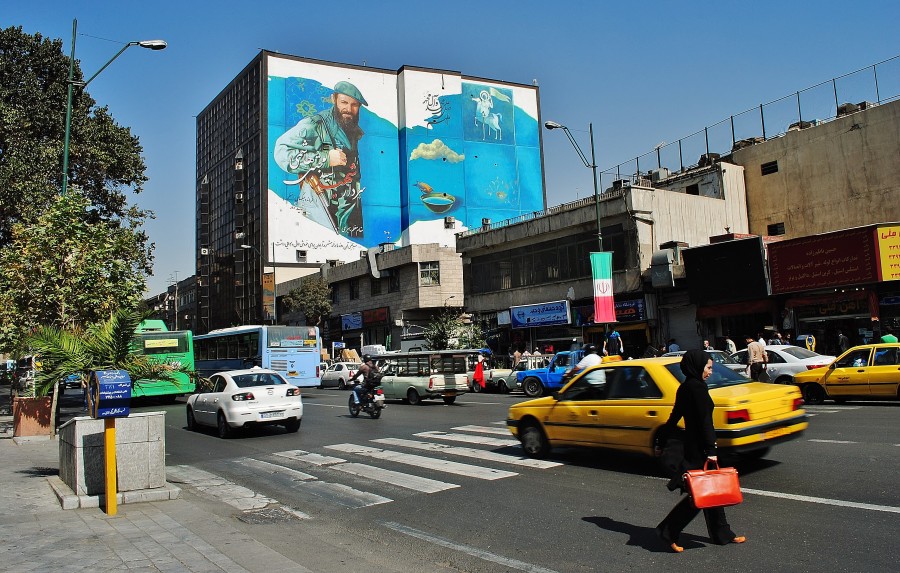
Street in Tehran. Iran.
Then I walked along the streets of Tehran and immediately after the metro station Imam Khomeini I even came across an interesting Museum of Post . Definitely not a nail in the program, but if the fate wanted me to stand in front of the main gate and the entrance was almost free – I walked in. This museum is located on two floors and I admit that I did not expect it to be so interesting. There were thousands of postage stamps from many countries, pictures of postmen from different years and telecommunication devices from the centuries that were brought from Europe. Interesting ways of mail delivery. First, they were horse carts and then rickshaws. When I left the museum, I met a bicycle seller of old banknotes from which I bought old Iranian banknotes with Reza Pahlavi and the Iraqi currency with Saddam Hussain. I did not check their authenticity but I liked it. Walking down the street I noticed that at the gate there were rumors quoted from the Koran that I think Iran is culturally strong.
After a short walk I reached the National Museum of Iran where there are archeological finds and well-presented history of Iran. The building itself, which was designed by a French architect, is quite original and I think I would best describe it as “a huge arch filled with excess of bricks.” In the middle there are quite a few attractions, but before I go into the description of the exhibits I mention that here and there are big posters depicting the old and present leader of spiritual Iran. There is no such thing as a cult of the individual. In the center are mainly expositions from Persepolis and Shush finds in the form of statues, pillars, ceramics and many sculptures. In memory of the survivors of Persepolis soldiers as well as sculptures of a bull and a sitting dog. This museum is an interesting experience for one hour, especially since descriptions in English are limited.
Then I went back to Imam Khomeini because it was only 5 minutes walk from this place that I found the most interesting museum in Tehran. It is the Ebrat Museum , which is housed in the former jail for the political enemies of Reza Pahlavi and which in a very realistic way represents the tortures that the Shah’s regime carried out. After passing through the iron gate, I followed the iron corridor to the old cars where the entrance was. On this day I was the only visitor, so after the museum guided me, a guide who was also a former prisoner. We went through all the torture chambers where tortured and tortured prisoners were modeled, and where torture was presented. Piercing, pooling in the middle of the prison and tethering and reprisal over the prisoners were “delicate” tortures. The prison was built in the form of a wheel, which meant that during the “rush hours” prisoners were set up to hear their mutual suffering.

In front of the former American embassy in Tehran. Iran.
In separate “interrogation rooms” there were revelatory models that played such scenes as: driving large pins under the nails or scooping the body. I also noticed that those who mistreated the Iranians looked more American and had cruel expressions. The wrinkled eyebrows, the artificial blood, and the tools of torture in the hands of the perpetrators and in the bodies of the victims make this museum speak to the basic human impulses. There is also pro-revolutionary propaganda around, photos of Reza Pahlavi and his wife so that we can not forget who is behind the torture and small targets in which the wax figures of particular people are located. One of them is, for example, the current leader of Iran Ali Khamenei. At the end of the guide / former prisoner suggested we make a commemorative photo and then brought me to a prison shop where mainly the pro-revolutionary materials Ajatollach. In terms of my personal feelings and taking into account the history of Iran, I think that Muslims were the most true, and I believe that all these tortures took place, while on the other hand Muslim Ebrat is also a propaganda function of the Islamic revolution. I think that in order for justice to be fulfilled, there should also be a museum of torture and persecution of the Islamic regime. Shah Reza Pahlavi was terrible to the Iranian people and was a pro-American traitor, but the Ayatollahs also have a lot of conscience, which makes the Ebrat Museum show only one side of the coin.
In addition, the Ebrat Museum would compare with the Tuol Sleng Museum (S-21) in Cambodia , that is, the old school that Pol Pot and his companions converted to an extermination camp .
That day I had a mind full of impressions because I saw many new interesting places and I was still excited about Tehran. But I’m not talking about museums, but about street scenes that will always remain in my memory. Shops and stalls in the streets were open late and it was always a good way to observe people.My favorite places were, however, stalls on which street vendors were spreading their goods on a dagger or thick cardboard. Next to it was always the street tea pouring from the thermos and the colorful fruit stalls. I also paid attention to the films of Iranian production . On my bus trips I saw a couple of them and I admit that it is a nice family movie showing Iranian culture and self-confident women who are not at all male. Every evening I went to my ultra-cheap hotel with a small bag of grapes and after a short conversation and planning the next day I took a horizontal position and went into a mental state of weightlessness.

At the Ebrat Museum in Tehran. Iran.
The next day I got up to the subway at Imam Khomeini and drove to the former US embassy with which the new Iranian history was connected and where the fundamentalism of the whole region was born. It was here that Reza Pahlavi Shah received orders from the Americans, which led to the fact that the Iranians were heartily fed up. The chess divergence reached such nonsense that he even said that “an American caught on the offense against the Iranian will not be punished”, which was the fury of the Iranians because in Khomeini’s official statement it was said that “even for the passage of the dog had to answer but for passing the Iranian no longer “. America (and England) has had a strong influence over Iran for many years, and the shah allowed to rob the nation.
The Americans even opened brothels in Tehran with the Vietnamese, and since the Iranian society was very conservative, the citizens of the “most democratic country in the world” got exactly what they deserved. On November 4, 1979, pro-revolutionary students stormed the grounds of the American embassy, took control of it, and held 52 hostages for 444 days, that is, until January 20, 1981. America itself put the stick in the anthill and, as usual, created the Islamic revolution, Muslim fundamentalism, and unintentionally, through its audacious actions, paved the way for Khomeini to rule over Iran. President Jimmy Carter called it an “act of terrorism and anarchy,” which I think is imperial nonsense. When I left the metro station on the wall surrounding the former embassy, the inscription “Down witht the USA” but at the sight of me someone shouted “That’s bullshit” from the crowd, so I think that the Iranian society does not necessarily agree with it. In addition, there are graffiti on the walls that should be perceived as strong anti-American rhetoric. These include the Statue of Liberty disguised as a skull and barbed wire in Iran.
There is of course Ayatollah Khomeini against the Iranian flag as the one who defended Iran against “the Great Satan and his little dog Israel.” There is also an American flag on a tall building near the former embassy, with skulls on a blue background instead of stars and red stripes created by falling bombs. The coat of arms of the United States is also engraved on the wall of the former embassy, but it is very damaged. Being here, I tried to convince the employees to let me into the embassy, but they agreed. I also admit that I was very persistent and they were very patient. In the square, however, I managed to see the American flag and the flag of Israel, that is, “Great Satan and his dog” and a couple of model airplanes in front of the main building. As a curiosity, I will say that in order to save his stool, President Carter organized a rescue operation of the American hostages, but it was a total failure that only helped Reagan.
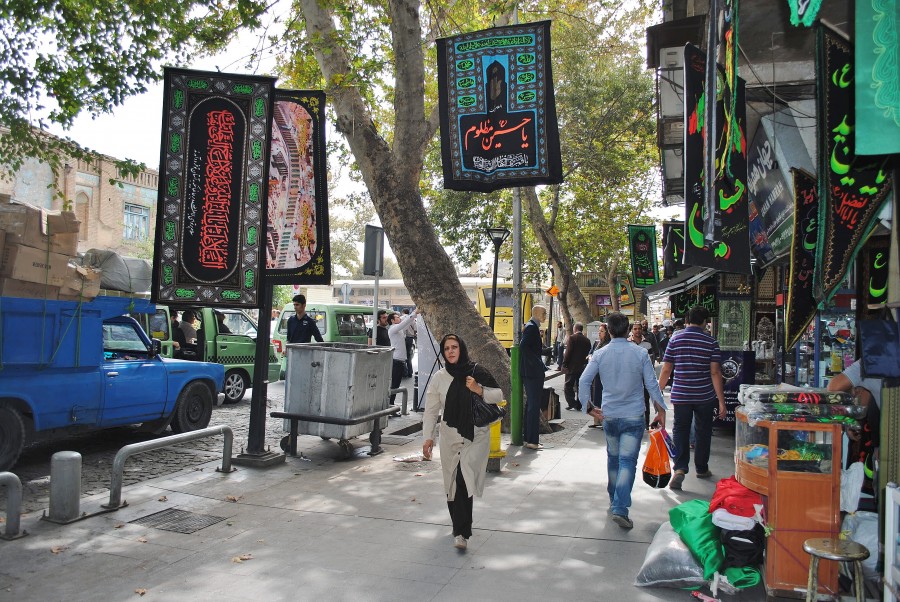
Street in Tehran. Iran.
If anyone is interested in the Islamic Revolution and Iraqi-Iranian War and would like to see photos from that time then I recommend the nearby Shohada Museum .
Then I got on the next subway and got off the Park-e Laleh . It is a nice green area outside of Tehran’s center, which is a saving escape from noise and traffic. People come here to play volleyball and work out and young couples are also encouraged to go out in the dark, away from the religious police. On the outskirts of the park there are also souvenir shops, pubs with food and zoos, which makes it a pleasant and relaxing place. There is also a Museum of Contemporary Art and a very interesting Iranian Carpet Museum.
The Museum of Contemporary Art was built in the shape of a circle, so that the next floors should be walked around the entire building. This museum is not always referring to the present, but the works that are there also represent a show of modern Iranian and European art. The value of the whole piece is about $ 4 billion or even more and some of the authors are: Picasso, Warhol, Matisse, Dali, Monet and many others. When the Iranian president was Ahmaninejad many of these works were hidden in the basement as “symbolizing Western liberalism, which did not coincide with the ruling class of Iran.” Personally, I think that extreme liberalism as a political view is a mistake, a mental illness, and a proliferation of Western society, but on the other hand, I think that Ahmadinejad never quite looked at these images. At the reception desk was a nice Persian cat.
There is another building in the Iranian Carpet Museum . Carpet production in Iran has a cultural base and is also a disproportionate income of Iranian GDP. In this museum you can see all kinds of carpets, not only their different designs but also different styles because every part of Iran has its own style and produces characteristic carpets for its region. Among the many interesting works are carpets of geometric figures and flowers of different layouts, scenes from the life of ancient Persian architecture, genealogical trees, hunting with dogs, portraits, raised carpets with animals and plants, and scenes from rural life of various seasons of the year.
Among the many were carpets with portraits of American presidents, the Last Supper and carpets with Mecca and Medina. Most of them are made of silk or with a combination of wool and silk and all were made by hand. They are also different in size and shape. As for the previously described museum, I do not think it is necessary, but the museum of Persian carpets is an absolute duty for every traveler and I advise to also hire a guide who has many interesting and wise things to say.
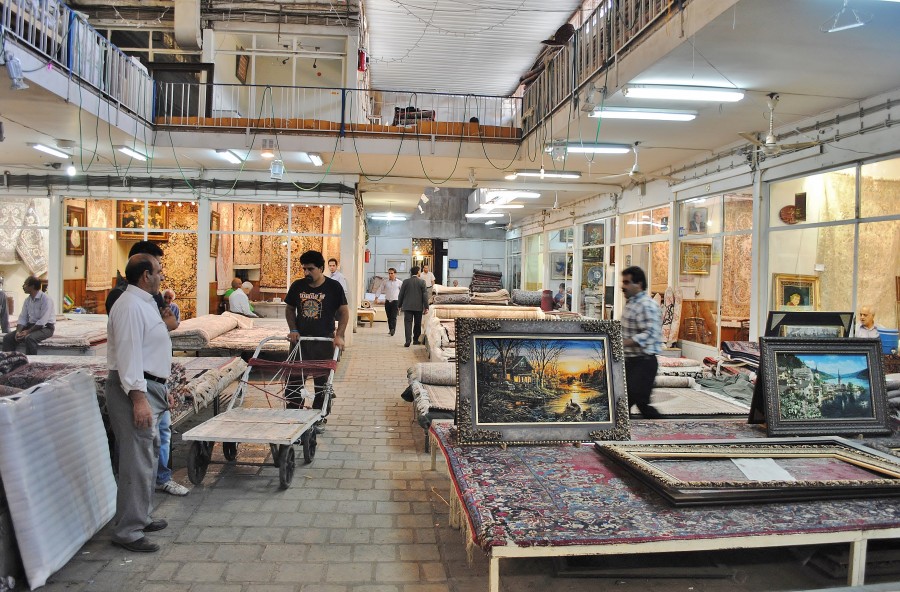
Part of the Persian bazaar where paintings were sold. Tehran, Iran.
After all, I strolled through Laleh Park, looked at fountains and people, and then watched Tehran at night.Soon I got up to the subway and drove to Imam Khomeini. As usual, in the evening, after a portion of grapes and tea on the street I wanted to go to my hostel for the poor but this evening the artists and craftsmen had their pottery stalls here, decorated with diaries, dates, Persian tea and copper pots.
There was also a camera department where I wanted to sell my old “tired” Nikon D3000, but the Iranians wanted me to give him a penny. (Finally it came out that after I returned to London I sold him to Pakieu twice as much as the Persians offered me in Tehran). When I returned to the hostel I remembered my new impressions, watched the game and then took the position of fallen tree, closed my eyes and went towards the light in the tunnel.
South of Tehran
My next day in Tehran I went much further from the city center. This time I went to the Mausoleum of Ayatollah Khomeini , which I admit was over my wildest expectations as this object was huge. In 2013 this huge temple complex was still unfinished and looking at its plans for a long time it will not be seen yet.Construction started in 1989 and when it was finished the whole area would cover 20km². There will be mosques, a Muslim university, 20,000 car parking, a shopping center and many other things that will create an Iranian imagination. The government of Iran assumes that Khomeini Mausoleum will become a popular pilgrimage center for Muslims and also a tourist center for tourists from other parts of the world. Today, the government has offered $ 2bn and the grandson of the famous ajatollacha Hassan Khomeini watches over the project.
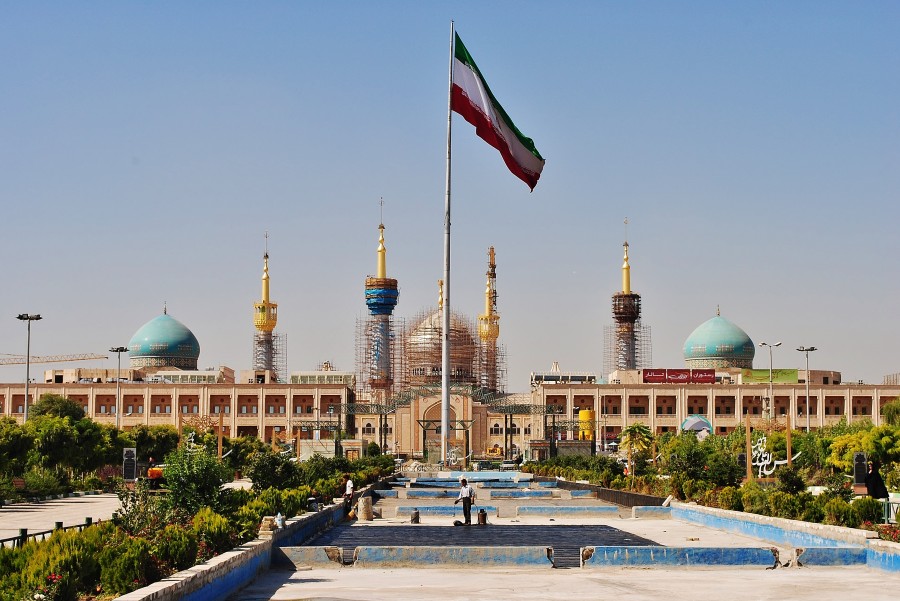
Mausoleum of Ayatollah Khomeini. Tehran, Iran. $2 billion was spent on this Muslim facility. Couldn’t that money be spent on education and healthcare?
The main mausoleum is decorated with a golden dome and has four 91 meter minarets to symbolize the age that Khomeini lived. The central gold dome is decorated with 72 tulips, which symbolize the 72 martyrs killed in battle alongside Imam Hossein in Karbala. Although the building is still under construction, paintings on the walls, carpets on the floors and restaurants with little gourmet food are already in the works. Khomeini wanted this complex to be a place where people would spend whole days and be in good spirits, wanted to eat here and drink with their families and to look at his numerous images. I think it is very possible that this was what he wanted, but I also think that Khomeini had a great mania of his own size, and who knows, he may even have believed that he was holy and that he should be worshiped.
For the mausoleum, men and women enter separate entrances and then go to the main section where zarih is , the metal cage in which the body of Khomeini and his wife and son are located. Interested parties look in through the green fast and show their respect by throwing the banknotes. The interior of the mausoleum is a monument of money made of white marble, though over the years many precious jewels can be expected, including the magnificent Persian carpets.
So far it is too early to say whether the amount of money will be repaid but anyway I wonder if the Iranian government would have come out much better if it invested the money in the educational system, health system or infrastuktura of the country. I realize Iran is competing with Saudi Arabia, but I think Persia already has enough mosques. Some of them, such as the Haram temple complex in Mashhad, never cease to grow, making such places urban cities and Khomeini Mausoleum exactly on the same road. From the metro station, you can not miss the mausoleum as the great dome and minarets beat the eyes. In 2013, I was still walking along the narrow and dry fountains, but I guess that over time, the whole area will be green, full of fountains, and it may also become a shopping center for door-to-door salesmen. For European travelers this facility is also very interesting and will be more and more popular during the festivals in one place will see the newcomers from all over the Muslim world.
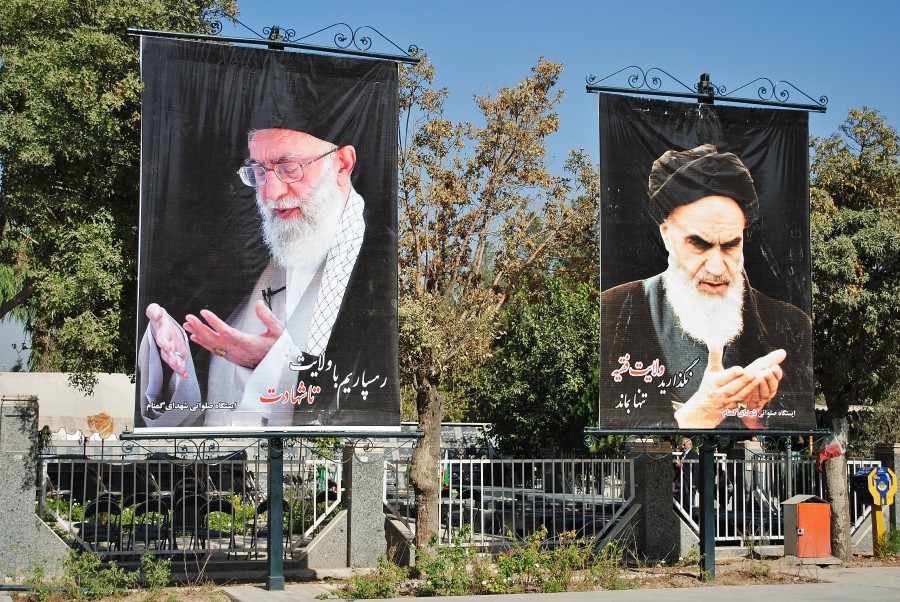
In Iran there are many posters depicting spiritual leaders. Here we can see Ali Khamenei and Ruhollah Khomeini.
To the Mausoleum of Khomeini I got a red line and while traveling south I got off at the penultimate Haram-e Motahar station . This is also the only way to get there, which I recommend. We will also take the bus south to the city of Qom. Although the Khomeini Mausoleum is located behind Tehran, I decided to place this object in the description of Tehran as it reaches the city’s metro.
A trip to the Khomeini Mausoleum is usually combined with the cemetery of the Iraqi-Iranian War (1980-88) called Behesht-e Zahra . This cemetery is different from most of these types of places, because here in addition to the traditional graves are also glass boxes with photographs of fallen sons and fathers, and also their private things such as knives, watches and letters to the house written with their character writings.This makes the Behesht-e Zahra cemetery more personal and more evocative of the memories of family members coming here. I also stayed here longer than planned because the cemetery is a very interesting and emotional place. Besides, it is also a meeting place for the families of the fallen and the place of promotion of Islam and as the only Christian at one of these meetings I was offered tea.
North of Tehran
Then I took the Haram-e Motahar metro station and drove all through Tehran north, and got off at the last Tajrish station. Back in the 70’s, Tajrish was a group of small villages outside Tehran, but with the construction of a new highway and the Tajrish metro, it was dragged into the capital’s territory. Tajrish has always been recognized by the upper class of Tehran and has served as a summer and winter destination for years. Due to the much lower air pollution and the close vicinity of the Alborz mountains, Tajrish is still a place where you can break away from the noise of Tehran. Over the years, a very interesting bazaar was built here, built according to the traditional architectural patterns of Persia, there was also a very impressive Emam Zadeh Saleh mosque, also serving as a mausoleum, and many restaurants with higher prices than elsewhere in Tehran.
In addition, nearby there are palaces and museums that are the remains of the Reza Pahlavi Shah and the Darband mountain trail. Tajrish is therefore a very good place for shopping, for a good meal, to meet history and nature. Being here, I bought fruit at the vegetable market and looked at the characteristic arches of the Persian bazaar, ate fancy shih-kebabs in a minor pub and was in a carpet store.
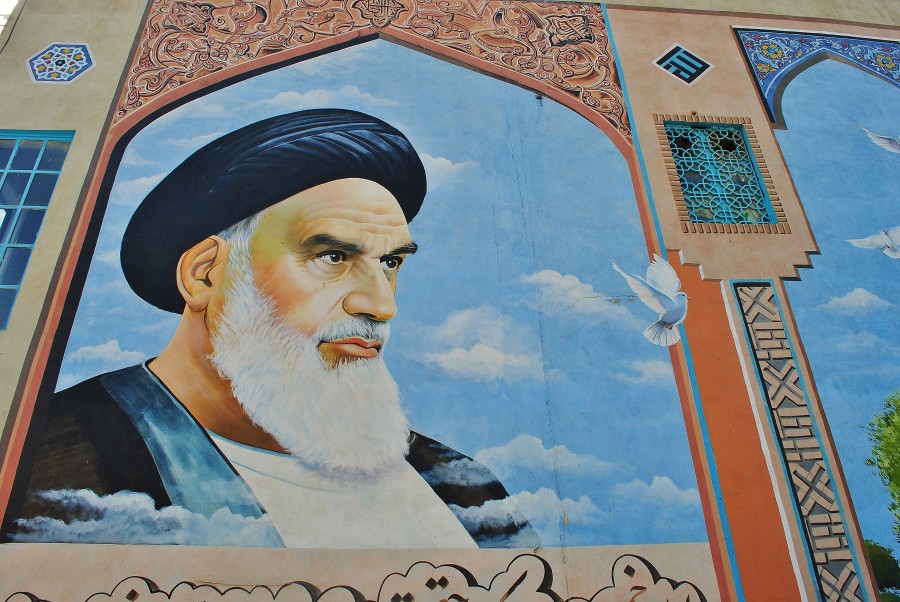
Founder of the Islamic Republic of Iran Ayatollah Khomeini. In Iran, there are many posters and frescoes on the walls commemorating this leader.
I also spent some time in the great square in the mosque Emam Zadeh Saleh watching his great gate decorated with mosaics, stylish arches and two minarets. I also saw old fat oily women wrapped in black sheets and eating rice with sauce, though they were young, shapely and agile like drowning female mice at the mating age. I saw my vision a little frightened but still they did not fail to give me a small smile with a fierce grimace here and there. The entire sacral object, because it speaks beautifully lit after dark and the huge dome covered with blue mosaic resembles the shape of a female breast. I liked this mosque.
From there I went up the hill and after about 15 minutes I got to the surrounded by trees and armed soldiers of the Museum Complex Sa’d Abad . There are 104 hectares of attractive gardens and 18 buildings, most of which are museums. The entire facility was the summer residence of the Shahlavi Shah and his family, and today there are souvenirs in the museums. At the entrance you should remember that tickets to specific objects are purchased separately, you also need to immediately decide on specific objects.
First I went through a well-kept garden to the White Palace , which was built in the 1930s and is the largest of all.At 5000m² in 54 rooms, you will find luxury furniture, paintings and huge carpets. There is also a wealthy dining room and a billiard room and its beautiful, rich equipment. The White Palace is a symbol of the wealth of the ruling class and also a symbol of what the average Iranians never had. In the basement of the White Palace there is also the National Museum of Art but unfortunately it was closed when I was here.When I left the house I was walking around the garden until I met a group of young, persian cats “skorych to jokes. They were around the age of about 20 years and gladly reacted at the sight of the Polish arranger.We took pictures together and talked, but unfortunately we saw the caretaker who raised the scream and girls scared and ran away. I showed him the middle finger and I did not understand English, and so he did not understand and the girls laughed and sent me a kiss for good. At another facility I also posed one.
Then I got to the Green Palace , which was smaller and more interesting to me since it was built at the end of the Qajar era. Shah Pahlavi lived here for a year and built this house over the darkest corners of his imagination.It seems that he had to be bored with it because he decorated the entire mirror with mosaics, including the mirrored icicles in the bedroom. The green palace is also attractive from the outside as it has many fine details and at the back there is an attractive terrace.
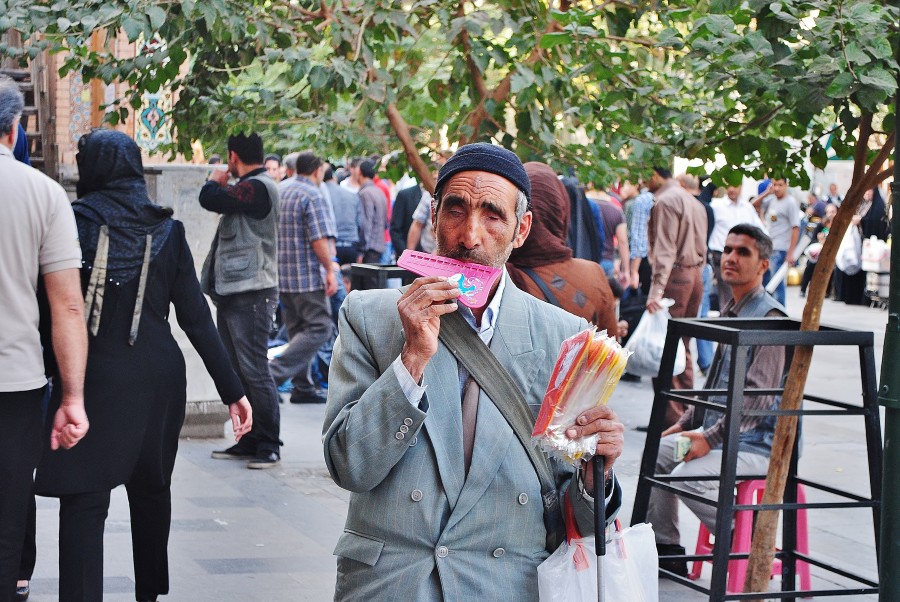
Street vendor in Tehran. Iran is an extremely valuable tourist destination, but poverty is also there.
In Sa’d Abad there are also many other cottages where you can see small sculptures and figures made of wax but Green and White Palace are the most recommended. Near the exit is also a very interesting Museum of Art , which I admit that for me was an unexpected nail of the program. On several floors there are works by Iranian and European artists, one of them being Salvador Dali. Next to it is the Military Museum and the old helicopter, although there are many museums in Iran. (Which I recommend is the Kerman War Museum, as described below).
The entire Saad Abad Museum Complex should be treated as a retreat in time to Reza Pahlavi’s reign in order to admire the luxury of life, admire its French dishes, admire its salons, furniture, paintings, sculptures and even Cadillac and Rolls Royce. All in all, it is set in a pretty garden which means that in nice weather it is an interesting and enjoyable way to spend 3 or 4 hours. I would definitely recommend this place. (6km from Sa`d Abad) There is another residence called Niyavaran , which was also one of the residences of the Chahlavi Shah and his family, which also today is in the form of museums.
When I left the gardens, I walked down the street towards the center of Tajrish and so happily found that on the way I met a “little flock of Persian kittens” , passing me by looking at me and making contact. I barely took a breath to say them tenderly when one of them threw in my face the confession that he hated Islam and had enough bans. They were more liberated, pretty tempting females, which I call gumis. They had half-closed heads and rolled up sleeves and I saw them approach me more when they saw a group of Iranian men to feel safer. One took a picture with me and wanted to give me my phone number, so in this example and a few others I find finding a friend in Tehran is not the biggest problem. Iranian girls are nice, warm, open in conversation and witty, but on the other hand they are also sad, unsettled and very snuffy, which makes them must be kept short but always gently. Traveling to Iran, I saw many nice and shapely women and I think they are probably the most beautiful in their region.
So what is the question if someone from Europe wants to take Irwan for wife, because this option is also possible here. For racial cleanliness, this is not the best, but on the other hand, carefully selected Iranian women in terms of race could give white men Mediterranean or Romanian children with green eyes and light olive skin. In Iran, Aryans have settled in the past, so that some people still see good blood and nice facial features. Iranian spiritual leader Ali Khamenei is so white so many Iranian women also meet our racial standards. Iranians are also generally inclined to accept Christianity as their great asset. However, remember that these sweet kittens are nice at first and very wet then why for the good of the relationship they must know their place.
I refer to the topic of the breed many times in my political articles, which can be found in the “Policy of Truth” section and I believe that this is a very important topic to be addressed.
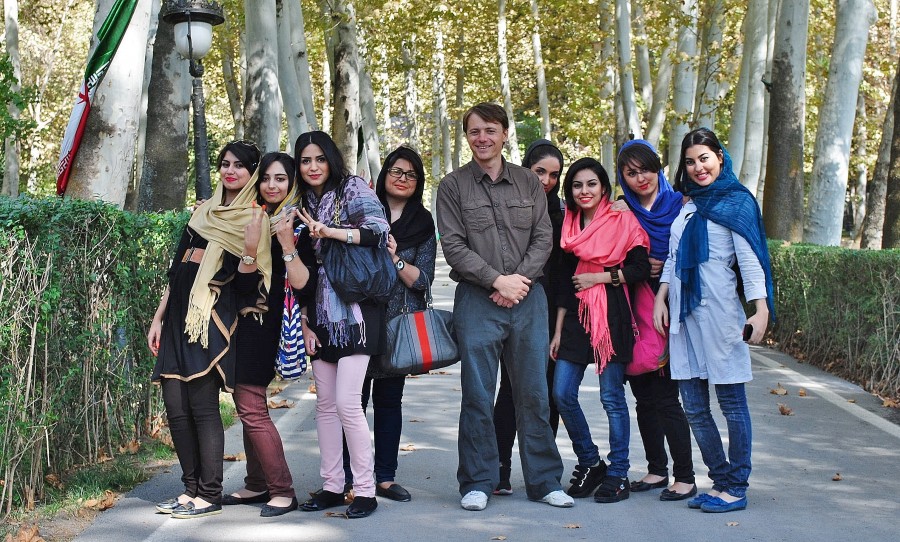
Iranian women are beautiful and nice to talk to. I am sending you my best wishes.
After returning to downtown Tajrish, I got into a shared taxi for only 10,000 Rial and drove 2.5km to the foot of the Darakeh and Darband mountain trail. At the foot of the Alborz Mountains there are sophisticated restaurants, hotels and mountain trails that lead to the mountains along the stream. On the way, I passed men grilling mutton meat, a few tea makers and restaurateurs cheating on me, I passed a donkey with luggage and fought a hard duel with a goat. Donkeys on the sidelines are here at work as they deliver the goods to the restaurant. In the meantime, I also sat down for tea on a chaikhana and drank near the rocks and the waterfall. I also bought dried fruit and continued up until the trail ended and I was climbing the Alborz mountains. Here I not only tried not to break my leg, but also looked at Tehran in the distance and met a shepherd with a flock of sheep.
Some parts of my mountain expedition were difficult because I was riding on my butt from these parts of the mountains. On the other hand, Darband was a way to get away from the exhaust and noise of Tehran and to get close to nature. Islam is also more relaxed here and women smile more willingly because the Seat of Islamic Fanatics is located in the south, i.e. completely on the other side. For Americans visiting this place I will add that when coming here they do not have to lose valuable kilograms because there is a chairlift in Darband. Darakeh and Darband and all of Tajrish are the places that I remember most pleasantly.
On the way back at the metro station, my mother and girlfriend turned to me and asked me to take a picture of them.
As mentioned above, Tehran was my base for some time. I came back here many times and each time it was a pleasant experience and a place where I repacked and hit the road again. After some time I felt at home here, although I will not send women wrapped in black sheets to a beauty contest. I must also admit that the crew of the cheapest Mashhad hostel was very professional, relaxed and I recommend them with a clear conscience.
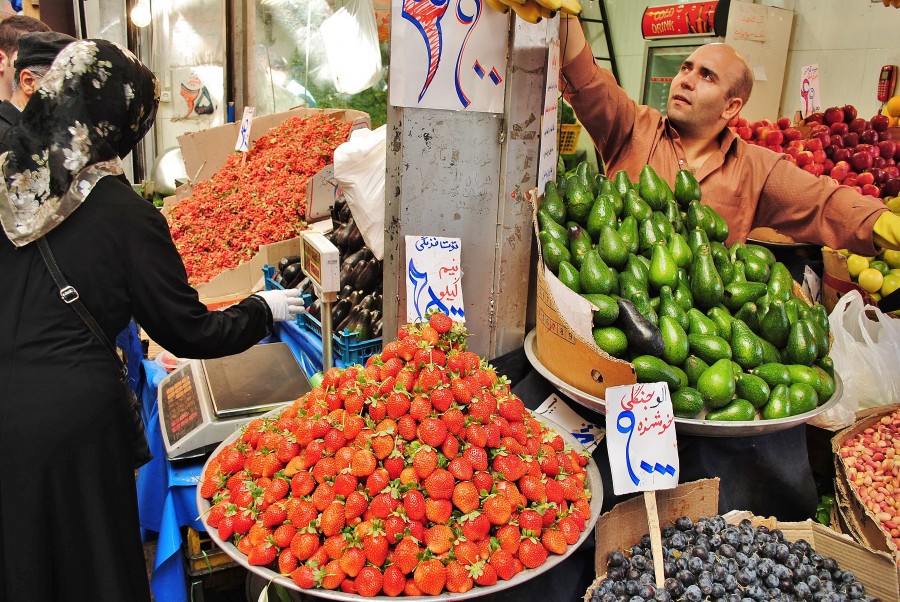
Fruit stall in Tehran. Iran.
Trip to Reyneh and Damavand (5671m)
I left for Rayneh from the eastern station (Terminal-e Shargh) because it is the station that serves departures towards the Caspian Sea. I bought a ticket to Babol for 70,000 Rial but got off earlier, taking the turn to Reyneh. Unfortunately, at the station, I cursed the ticket seller because he wanted to cheat me. He took the money for the ticket and then pretended not to, so I had to act very badly to get me a ticket. This was the first time it had happened to me. Anyway, the journey lasted about 1.5 hours and it was pleasant and I also got a small snack on board the coach. Especially the last part of the ride was picturesque as I was driving inside a deep canyon with the river below and interesting rock formations all around. This lovely route stretched for many kilometers, which meant that even those who did not want to climb towards Damavand could pitch their tent below and cast a fishing rod.
During the bus ride, young Iranians advertised Islam, so I advertised Christianity. When I got off at the turn to Reyneh (next to the restaurant on the left side of the road), I had a 6km climb up a winding road. Fortunately, after one kilometer I hitchhiked to the highlands where Reyneh was located; a small mountain station for visitors to Damavand and more. Reyneh is also a base for other picturesque mountain trails where you can see waterfalls, lakes, you can take a bath in hot springs and be in the mountains for their beauty, not necessarily having a specific purpose.
I will also add that Damavand is a potential volcano, the highest peak in Iran and the entire Middle East, and is also the highest volcano in Asia. (By the way, if someone likes to climb volcanoes, he will find the most happiness in South America).
When I came to Rayneh, I was greeted by a mountain guide and activist at a local mountaineering club.With a big smile on his lips and a strong handshake he quickly gave me the impression that he was a man of great financial need. He spoke very limited English, but knew the people who could lead me to Damavand, and he could rent me the equipment I did not have. But quickly realized that I did not have money to issue and so I offered to go alone using the map I got on the way back I will stay with him for 150,000 Rial night with breakfast. I admit I needed equipment if I was to get to the top but I did not plan it. I just wanted to get to the third base at an altitude of 4,200m asl and spend time in an interesting, adventurous way. I ate dinner, left my luggage, borrowed my backpack and went on my lonely trip. I could not afford to pay $ 200 a day so the option of a lonely trip was the only one I took into consideration.Besides, the map that I used was more clear than the spring water in Iceland a few years ago.
When I left the center of Reyneh (2020m) I went asphalt road about one kilometer but soon hitchhiked me to the beginning of the trail. I was in the company of Iranian workers who were excited to see a tourist from Europe. Not only that they brought me to the beginning of the trail (Bifurcate Maadan 2450m) for free they wanted to take a photo with me later. Anyway, I helped a lot because the Rayneh trail to the bend (Bifurcate Maadan) is a distance of about 6km on the asphalt.
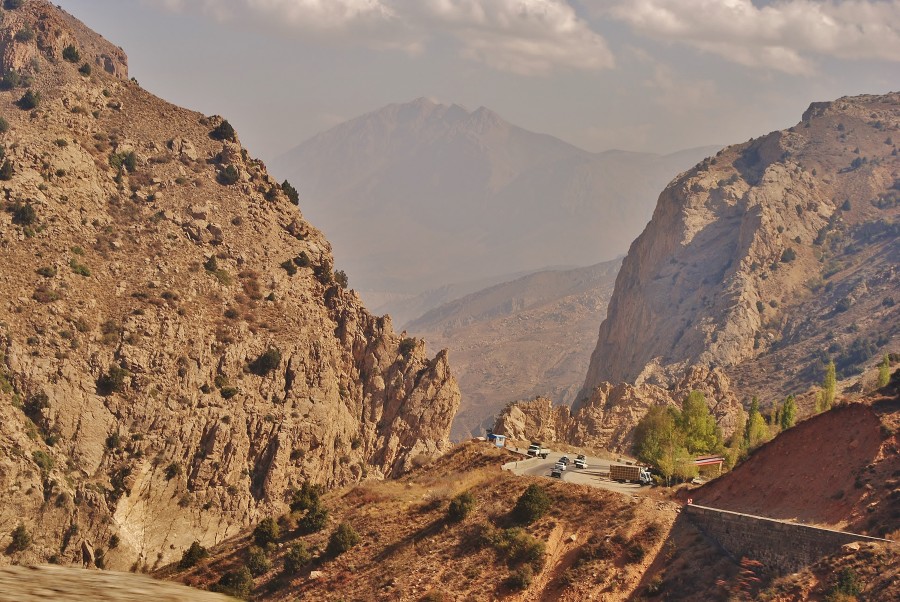
The mountainous panorama of Iran.
It is true that the views along the way were attractive, but not necessary compared to the later ones. After they left, I put on my backpack and went on my way again. This time I was overcoming a gently rising, winding serpentine in the distance, seeing only the top of Damavand. I didn’t see any trees on the way, but there were hives in the lower parts and a herd of wild horses. I walked slowly because I wanted to enjoy the views, silence and solitude, and after about 2 hours, when it got dark, I got to the Saheb al Zaman mosque (3020m above sea level), which serves as the second base. The mosque itself was closed, but next to it there is a concrete house where you can spend the night on the floor for only Rial 100,000. I did so and I fell asleep quickly because there was nothing to do. In the summer months, you can put up a tent in this place or any other place and it would be very nice, but I climbed in October, which means that at this height, especially at night, it was already cold and the waterfalls closer to the summit were also already frozen. I think that in the months from May to August it is much nicer because the whole approach is covered with green meadows with red poppies, there are also grazing animals and clear blue sky.
The next morning my real climb began because what I did the day before was just a warm-up consisting of a gentle 500m climb. This day was extremely hard for me and I must admit that I had a great start. I actually ran up the hill with my backpack, but in the drunken excitement of the Damavand summit, I only had enough strength for about 100m. Then I had to rest, so I entered slower from time to time, taking breaks, leaning on large boulders. The climb was not difficult as I was walking along a well-descended trail, with larger and smaller stones on both sides. Sometimes I also had to leave the trail and avoid larger boulders and sometimes I also went down to then overcome another hill. I had a lot of fun despite the fact that especially in the last parts of my climb I was tired, it was colder and the wind was moderately gusty. While overcoming the low vegetation and other obstacles, I also came across donkey transport, which in my opinion is a very good way to deliver the necessary goods to mountain bases. I have encountered this many times before, in countries such as Tajikistan and Kyrgyzstan. Usually the climb from second to third base takes about 2-3 hours, but it took me 5 hours. I was tired but I wasn’t in a hurry either because the views were beautiful and the base itself was not going to be interesting. Even though it was hard and after a few hours I was fed up, on the other hand I felt very comfortable in the silence and solitude.
When I got to the third base called Bargah (4200m above sea level), I felt relieved, but also glad that my fight with my own weaknesses was over. However, I realized that I would not climb higher because I did not have the appropriate equipment to win with 40 degrees frost. As for the height, I felt quite well, although I felt dizzy, so I think that those who do not live at similar altitudes need at least one day to acclimatize on a daily basis. So I only ate soup, talked to other climbers and had to go downstairs because the third base is only for those who climb to the top. In addition, the climbing fee from this place is $ 50 and I can assure you that the Afghan man who runs this base is not a philanthropist.
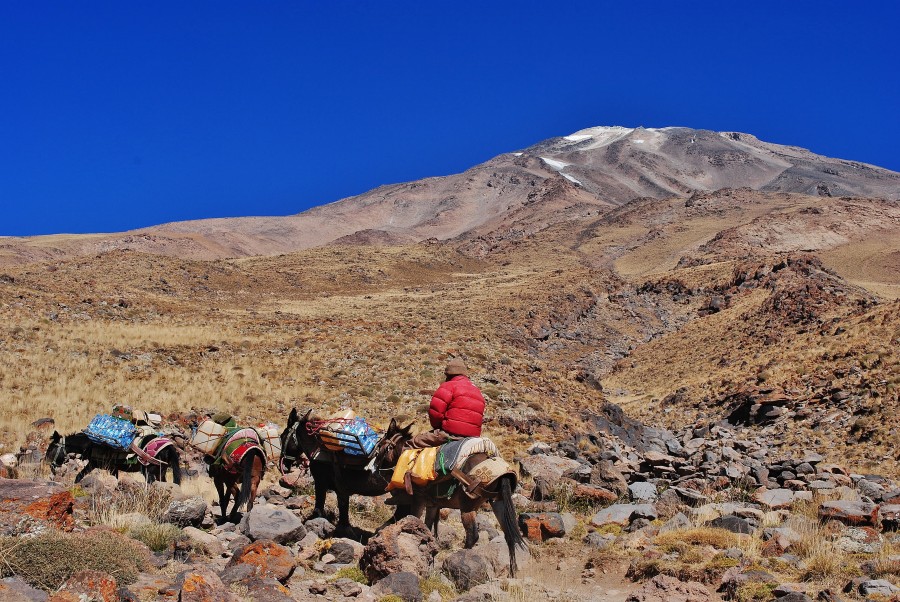
Road to Damavand. Iran.
The road down was obviously easier, and although I kept thinking of myself at the top of Damavand, I knew I was not prepared and I was just enjoying the trip. Using the light of day, I quickly passed other pits and stones and in about an hour I reached the mosque at the height of 3020m. Hence, the trail was very easy and even because it was a bus route, but I had to walk alone in the dark. I often turned around because the moon was well lit. And soon I was at the foot of civilization. I went down to the asphalt road and tried to stop any transport on an empty, dark road. I
n the end, my truck stopped, and she drove me to Reyneh. Here I stayed overnight at the same host as before and after my mind also returned from the mountains, ate a modest dinner, took a salutary shower and went to sleep peacefully. I was finished! The next morning I hitchhiked back from Reyneh to the main route and soon I was able to stop the bus that drove me to Tehran. If one thing that must necessarily be experienced in Iran is to go to the mountains of Alborz near Damavand. I think it is very important to know the natural beauty of a country.
Tehran
(Stay 2)
When I returned to East Station I got up to the subway station and drove to Imam Khomeini where I returned to the cheap hostel Mashhad. This day was only a day of rest, because in Tehran and its surroundings I saw everything I wanted. I went to dinner at a traditional bazaar and then to Shahr Park to practice. In the evening I packed up the next day because I had another trip planned.
Transportation from Tehran to Hamadan
I left the Western Terminal-e Azadi Station. For a ticket I paid 150,000 Rial and the trip lasted 5h.
Hamadan
(My pleasant experience with an Iranian family)

Street in Hamadan, Iran.
Hamadan was not on my list of obligatory places to see in Iran, especially since the antique ruins in the center of the city are fenced off by a net with no tourist facilities. I mean, of course you can spend a day here, but considering the more interesting places closer, Hamadan loses in tourism. I think Hamadan needs a big financial injection because it is one of the oldest cities in Iran and one of the oldest in the world and still has a lot to discover. Hamadan is a mid-sized town with a population of over half a million, which on the tourist map exists because it is a base for a water cave in Ali Sadr village.
When I got off the bus it was already dark, so I knew I would have to spend the night here. I wanted to look for a hotel but one woman asked me where I was and whether I had a place to spend the night. I said I would find a hotel but she invited me to myself for the night and for dinner. I thought, “Would the maids in Iran be more liberated than Europeans?” Certainly yes but she tried to be just nice. From the train station she was picked up by her brother and they both drove me home. I met the whole family, sat down at the table and spent a very nice, cultural evening. Then I talked to her father with an interpreter in his family and then I lay down on the blanket on the floor in a small room and went to bed. The next morning the girl woke me up and together with my brother they took me to a small train station where there were antique busies going to Ali Sadr.
Due to the very unexpected and pleasant experience with the Iranian family I have been very happy to spend my time there.
Transportation from Hamadan to Ali Sadr
The transportation was very pleasant, the museum bus took about 1.5ha for the ticket I paid 10,000 Rial.The ride was pleasant due to the desert views and the crossing of the border of Ali Sadr was for me a destination for a forgotten corner of the world in a deserted desert. There are many places in Iran.
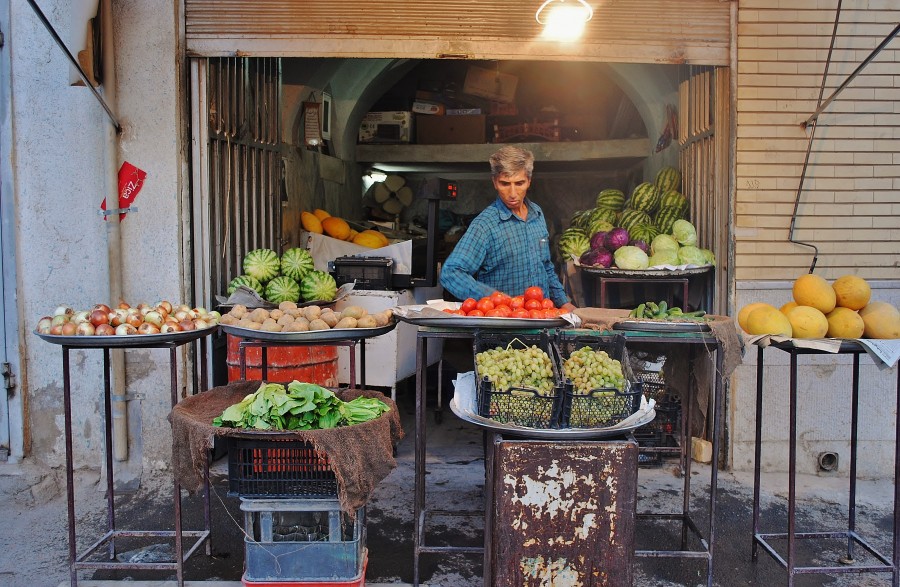
Fruit stall in Hamadan, Iran.
Ali Sadr
The cave in Ali Sadr is one of the greatest attractions of Western Iran and despite different opinions I did not regret coming here. It is a very commercial place and compared to the caves that I have seen in Borneo, there is really no comparison, but I highly recommend visiting Ali Sadr. The deep cave reaches 40m at the highest point, and besides, it has many interesting, well-lit and spectacular rock formations. The most important thing, however, is that Ali Sadr is a water cave with the deepest bottom reaching up to 14m. Transport inside the cave is also very nice because I was moving here pedaling on a water bike and dragging a boat full of Iranian tourists.
During the cruise in the cool cave, which lasted about 20 minutes, we moved through its wider and narrower parts, while observing interesting formations embedded in the ceiling and emerging from the water. After getting off the pedal boat, I walked over the plastic bridge laid on the water and took pictures in low light. In front of the entrance to the cave, there is also a large souvenir market and a chaikhana.
The town of Ali Sadr itself is shabby. It has shabby walls, inscriptions on houses left by “pseudo-artists” and a few junk in the street, many of which will not reach the next corner. In a few short streets surrounded by desert on all sides there is a gray place where prosperity and smile flew away with the wind. However, there is a cave and a bazaar and several small carousels for children, which offer the inhabitants of Ali Sadr a modest income and contact with the outside world.
When it comes to my private feeling, this is a place in my style, which is especially charming in its own way at dusk. I have already been to Singapore, Hong Kong and Shanghai, but it is the holes such as the Iranian Ali Sadr or, for example, the Mongolian habitat of the Dalanzadgad people that make my trips take on original memories.
Transport from Ali Sadr to Teheran
When I decided to leave Ali Sadr the bus had already departed and was not expected to arrive next. So I went through the desert and counted on the hitch. Soon I got into the car as a fourth passenger and for only 20,000 Rial driver threw me on the road overlooking the bus station in Hamadan. Here I washed in the local toilet and then got on the bus for 150,000 Rial and after 5 hours I got off in Tehran.
Return to Tehran
(Stay 3)
My next organizational and hygienic stay in a cheap hostel as usual went well. I washed myself up, deserted, I changed, and I slept. Next day I was ready to leave Tehran for another great adventure. This time I was supposed to return here after 3 weeks.
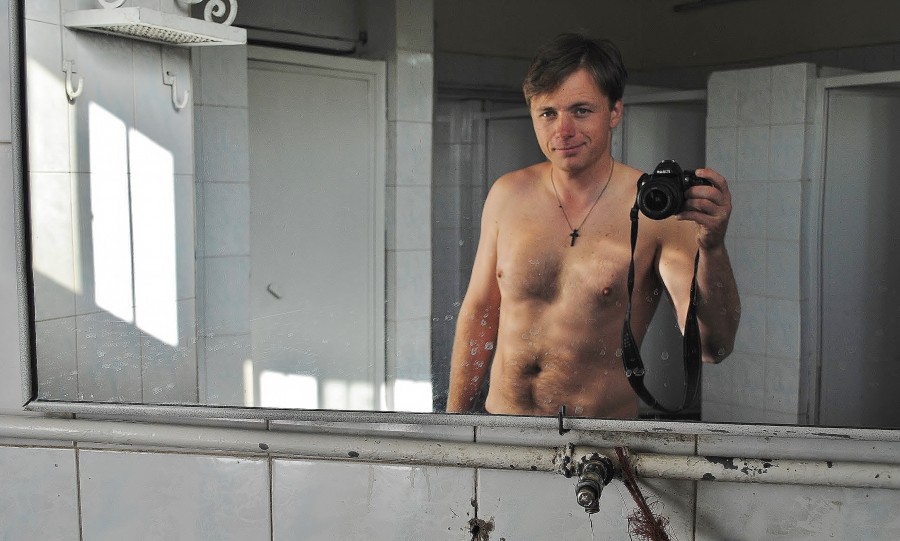
Greetings from the toilet from Martin Malik. (Photo from a lovely and fragrant toilet in Iran.)
Transport to Qom
To Qom I went from the south station; Terminal-e Jonub. At first I thought I would not get there as Qom was about 500 people, which was good to see after the bus to the bus. The queue was really long, but the organization of this direction was also very good luck. Qom is a popular place for Muslim pilgrimages, so every 10 minutes, empty buses and human cargo take over. So I waited so long and I was probably the only Christian aboard a Muslim tour. Along the way, on the right, I saw the Mausoleum of Khomeini (described above).
The ticket cost Rs 60,000 and the ride lasted 2h.
Qom (Ghom)
Qom is the second most sacred city after Mashhad, where Islamic clerics in Iran are based. It is one of the most conservative cities in Iran and the goal of many Muslim pilgrimages to the temple complex Hazrat-e Masumeh. Women are only dressed in black sheets (chador) and Muslims from many parts of Iran and Arab countries come to schools of Shiite Islam. It was here that the Muslim clerics began their revolution against the Shah and he also lived in Ayatollah Khomeini before being expelled to France.
From the point of view of a traveler who is not a Muslim, seeing this kind of place is a very interesting experience that I recommend especially to those who do not go to Mashhad. However, in Qom you will see only the complex Hazrat-e Masumeh and the bazaar all around, and besides, it is crowded and at first sight an uninteresting city. Due to its proximity to Tehran, this can easily be accomplished as a day trip. I did it from Tehran to Kashan, getting off the road.
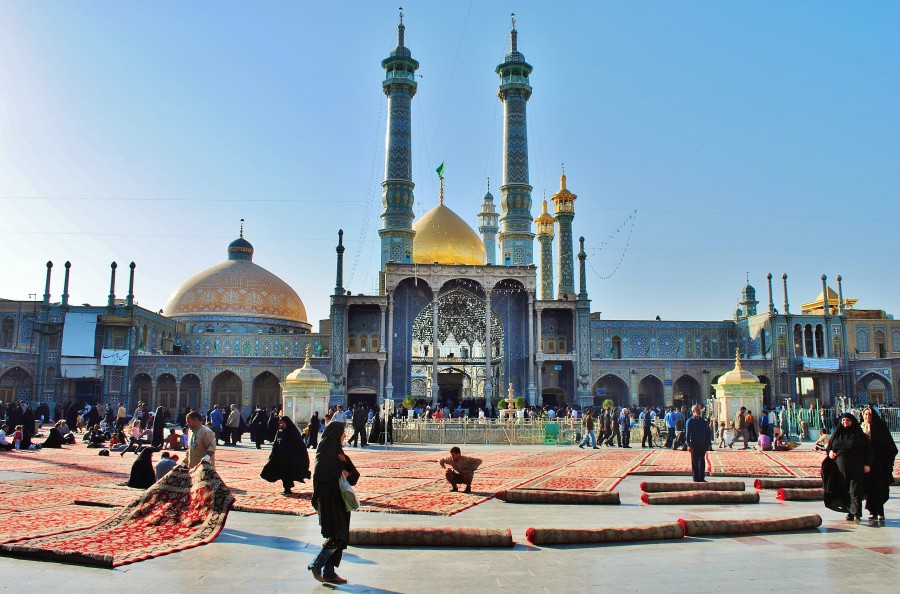
Qom is the second most sacred city after Mashhad, where Islamic clerics in Iran are based. It is one of the most conservative cities in Iran and the goal of many Muslim pilgrimages to the temple complex Hazrat-e Masumeh.
The Hazrat-e Masumeh temple complex is an enormous structure consisting of many ornate mosques, squares and tall minarets; and I have a feeling that as with Haram in Mashhad, also the complex in Qom will continue to grow. Despite the fact that Iran is an interesting experience for a traveler, let’s not forget that it is an Islamic country which is associated with a great lack of sense of humor and social constipation. While in Christian countries facilities are often built for amusing reasons, in Muslim countries they are mausoleums, tombs and other shrines of “holy” Muslims, which no one has ever seen but the nation needs them for propaganda reasons. How much truth is in all of this, I don’t know, but Hazrat-e Masumeh in Qom, for example, was built in honor of Imam Reza’s sister Fatima, who reportedly lived here in the 9th century.
Huge gates are decorated with colorful mosaics, tall minarets soar before the eyes and golden domes gleam from afar; and I think if at least some of this wealth was invested in the development of the city, in the local economy and non-Muslim education, it would be very useful. I admit, however, that the building itself impressed me because it was built with great panache and carefully made details. Hazrat-e Masumeh is also very interesting when it comes to people watching and the lively bazaar is full of original people and unforgettable faces. On the one hand, how nice that they do not live next to me in Poland, but on the other hand, watching them at home is fantastic and sometimes also comical. For me, the most spectacular was the observation of people sitting on carpets in large courtyards in front of mosaic mosques as if from Persian fairy tales.
Overall, I really enjoyed coming here and I highly recommend it. Most of this object was built during the reign of King Abbas I and other Safavid dynasty, and its subsequent elements were created during the Qajar era. Christians may enter the site, but women must of course be covered. I left all my worthless possessions in the cloakroom in front of the facility.
Transport from Qom to Kashan
From the street opposite the Hazrat-e Masumeh complex, I climbed into a taxi, which drove me around the station, where a taxi was shared on a large roundabout. For one of the places I paid Rs 60,000 and after about an hour I was already in Kashan. The driver blew me in the center.
Kashan
Travellers who don’t have much time because they rush to work 9 to 5 and pay taxes tend to avoid Kashan. In my opinion, however, this is a big mistake because Kashan is one of the oldest cities in Iran with a rich history and many interesting facilities. Despite the fights fought here over the centuries by such devils as the Turks and Arabs, and despite the earthquake in 1779, many wonderful objects have survived to this day. In addition to a large traditional bazaar and several mosques, the showcase of Kashan are the so-called merchant houses, which are the great architectural art of ancient Persia.
Kashan can also boast of traditional baths and caravanserai, one of which is converted into a hotel and at the entrance to the city there is also a traditional Persian garden – Fin. The old part of Kashan looks like it was made of the desert and it is the part that can still be called beautiful Persia without hesitation, not the Islamic Republic. Kashan is also associated with a good legend about the birth of Jesus and a bad legend about the Arab invasion. In addition, it is a city of many green squares and fountains where most of the monuments are located close to each other. Kashan is a small city with a population of about 300,000 people, which makes it easy to get to grips with.
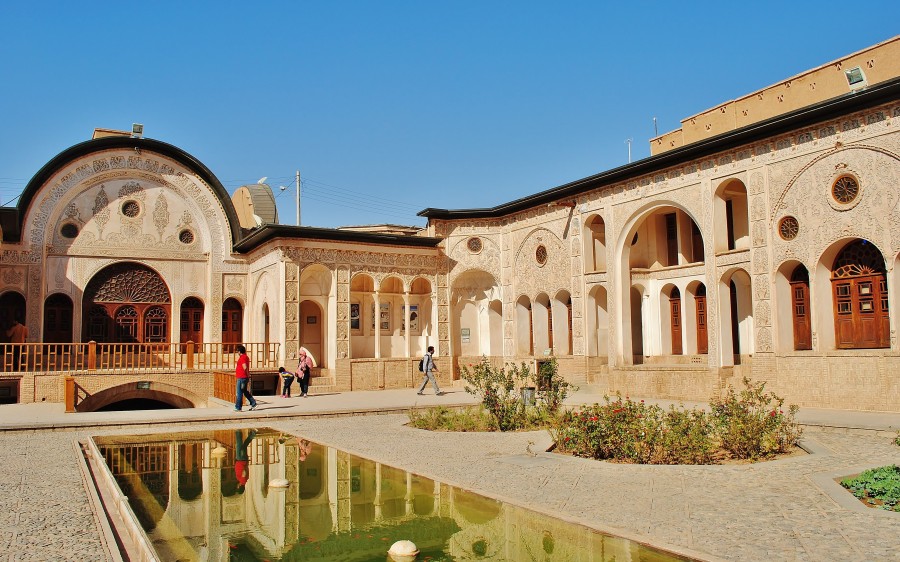
Merchant House in Kashan. Iran.
When I arrived in Kashan it was already evening and I had a problem finding the hotel. The cheapest one was unfortunately full, so I stood on the street and met with great interest of people passing by. A young boy walking with his family knew English, so he recommended me some places. I thanked him and, reading the map, walked along the dark streets of Kashan.
In the vicinity of the Agha Bozorg mosque there is a traditionally built hotel called Khan-e Ehsan and it is hidden in a very small street, which makes it very easy to miss it without the inscription. There is a corridor leading to the hotel, the walls of which are built of clay and sawdust in the style of the ancient style, which makes the entrance to the hotel itself a transfer in time. The main part of the hotel looks like old caravanserai that I have seen before in Azerbaijan and Uzbekistan. In the middle of the rectangular square there is a large, shallow pool with a fountain, surrounded by chaikhans and pretty vegetation, and around it is a one-story hotel built on the lines of a rectangular square. The hotel is built of stones and has arches typical of Persian architecture, while each room is also a continuation of the large rectangle and is hidden in the background of the corridor. (I realize that this is confusing also let’s imagine a rectangle where each wall is divided into rooms and in front of them is a long corridor and arches overlooking the water body.
A night in this hotel cost Rial 300,000 for a place in a dormitory room, but these were also gone. There were only more expensive rooms, so the receptionist talked about my case with the boss and they let me sleep for only Rial 100,000 per night in a basement room where there were beds and various equipment. This room was not yet prepared for snobs or tourists with wallets as thick as the perimeter of a full anaconda, but for a traveler with a tent and a backpack it was just right. Usually, I never describe hotels, but this one was special because here I felt like in ancient Persia. (Then I was also in this kind of hotel in the city of Yazd).
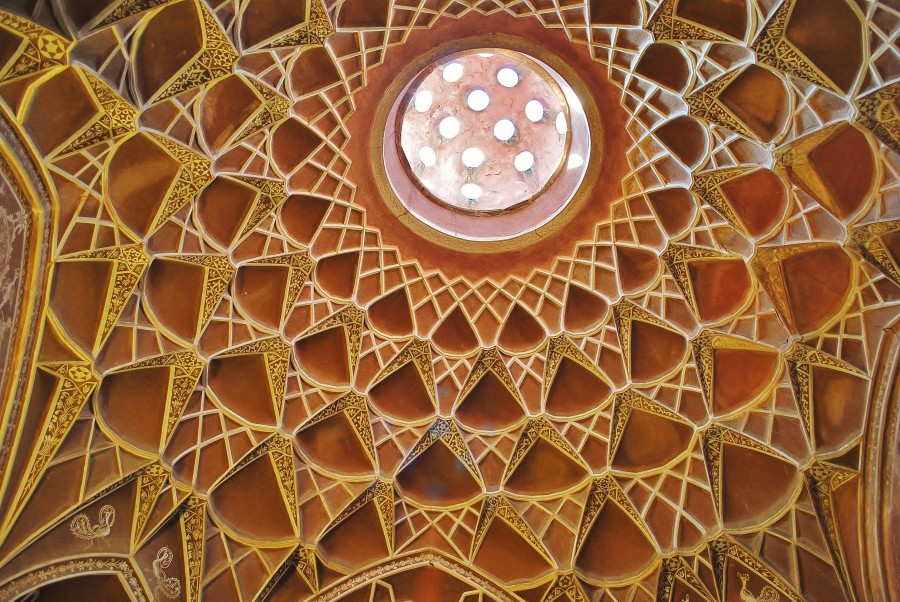
An interestingly crafted ceiling in Kashan. Iran.
The next day, due to the proximity of this facility I went to see the interesting mosque Agha Bozorg and Madresah (Muslim school). It is one of the most spectacular mosques in Kashan, built in desert color, with traditional arches and a dome built in the mid-nineteenth century. This mosque is characterized by two minarets decorated with colorful mosaic, direction indicating Mecca and beautiful wooden door. In addition to its traditional style and the color of the desert, which I like more than an exaggerated mosaic, the characteristic part of this mosque is the square in the middle located below the street level and the foundations of the mosque itself. Natomist bricks for its construction were made of clay which explains the color of the desert. This mosque is a very quiet and interesting place, though on the other hand it is praised by God that it is located in Iran and not in Warsaw. Then I came here a few more times to look at the details and have some tea at a street party before the mosque.
Then I walked along the streets of Kashan and sat on green squares with fountains until I reached the traditional bazaar. The traditional bazaar in Kashan is not as huge as it is in Tehran, and it is not so chaotic, which makes it possible to observe the archways and domes of the Persian architecture, the various goods and the life of the bazaars and customers. It is worth mentioning that a tourist from Poland also does not remain unnoticed and is also subjected to observation of women wrapped in black sheets and tappers of copper pots.
However, it must be remembered that in the opinion of Europeans, the bazaar is only a place of trade, whereas in Persia the bazaar is a work of art connected with Persian culture. The most impressive parts of the bazaar were the huge chambers that paved the way to the high ceiling with traditional arches and elaborate paintings on carved pillars. For this reason, the bazaar in Persia is not only a place of trade, but also a museum and a place where the whole nation, regardless of social class, meets. The bazaar in Iran is a social, cultural, economic, political and religious center. Also interesting is the roof of the Kashan bazaar, because it consists of many domes and small towers in the color of the desert. Fortunately, it is possible to climb up to see the dome and the wool drying in the Persian sun. (A good place to observe the roof of the bazaar is the tall dome called Timche-ye Amin al Dowleh) . Being on the bazaar I also remind you that haste is a very bad adviser. Here you have to have time to sit with the Persians near a glass of traditional tea and get lost in what is left of ancient Persia.
Being on the bazaar I recommend to visit the Soltaniyeh mosque of the XIX century, whose present shape was built in 1808. At present there is also madresa open for women. This mosque consists of a huge, carved gate decorated with a blue mosaic and behind it is a large desert dome. The entrance to the mosque is a rectangular area of water and trees on both sides. But there is a bazaar.
Another place that is part of the bazaar is a tea house converted from a traditional bath. Hammam-e Khan has cymbals, caged birds, Persian folk singing traditional songs and also gives good green tea, dates and biscuits.

Inside the merchants’ house in Kashan, Iran.
I spent the first day on a free tour of Kashan and in the evening I spent a pleasant time in a traditional hotel built on the Persian caravanserai. I also went to drink tea before the mosque and then went to sleep in the basement of the hotel. The next morning I started to explore what is characteristic of Kashan. I saw the merchant’s houses, the baths and the old city walls. In Kashan there are also many mosques and chapels but I was not interested in such a degree because there is no way to see everyone and then all remember.In addition, I think that the visited objects should be carefully selected so that they do not become boring and similar to each other. The same is true with temples and Buddhist stupas in Thailand or Birmie and with churches in Armenia.
The Kashan Merchant Houses
The Merchant Houses, which were built in the eighteenth and nineteenth centuries, are noteworthy and although many of them have been destroyed or even turned into desert landscapes, several have been meticulously rebuilt. This idea turned out to be brilliant because the Merchants’ Houses attract many tourists and advertise well in Kashan. The houses are built in the same way as the previously described hotel where I lived, ie in the middle is built courtyard with a water body and greenery, and the elaborately built house with rooms, balconies and corridors around. Since this architecture comes from the Qajar era, the whole is decorated with arches, intricately carved mosaics, and often also with clay and straw walls, giving an environmentally-friendly color to the desert. Each of these houses also has gates and ornaments typical of Persian mosque gates, and although these houses are not mosques, there are huge similarities in style. Depending on the house these objects have a number of floors and labyrinth passes, but it is important in my opinion not to treat these magnificent buildings only as houses but as open-air museums of great architectural-historical value. On the other hand, these houses are also a symbol of the splendor and wealth of those and those times, as the families of the richest merchants lived here, while ordinary shepherds and merchants lived in simple houses, clay houses or tents.
The first one I visited was Khan-e Ameriha built in the late 18th century and which is one of the most exquisite. He belonged to one of the richest people in Persia, Agha Ameri, who decided to build a millionaire house and in the finite version had 900m² of art, wealth and glamor. When the house collapsed in 1999, restaurant operations took place and after millions of dollars spent on its rebuilding, the first courtyards finally looked like millions of dollars.There are also two hammams in the Ameri House, including one built specifically for pregnant women.Another House of Merchants I went to was Khan-e Tabatabei , built by a famous Persian carpet manufacturer in 1880. In addition to the water body and traditional architectural elements, this luxurious mansion features a large masterpiece in stone and a glass mosaic by Persian patron masters. Tabatebei has 4 courtyards and 40 rooms and covers an area of 4730m².
The next house was Khan-e Borujerdi , which is similar to earlier houses and which also has elaborately carved walls, wooden door to the rooms behind the characteristic arches and a fountain in the middle of the courtyard. The characteristic features are stone-shaped stalactites rising from the ceilings and one of the main courtyard courtyards carved in the ceiling of a Persian carpet. An important point of the whole building is the roof with a courtyard with towers and six-storey domes. I add that this one element became the symbol of Kashan.
Another home is Khan-e Abbasian , which consists of six buildings built on several floors and has several small courtyards.Six courtyards were built for six families and the whole was built in such a way as to show the space as you climb up to the top of the open courtyard at the top. The walls of the mansion are decorated with sculptures and the rooms have glass mosaics and a game of lights made using glass ornaments. The Abbasian House also has numerous passages from one courtyard to another.
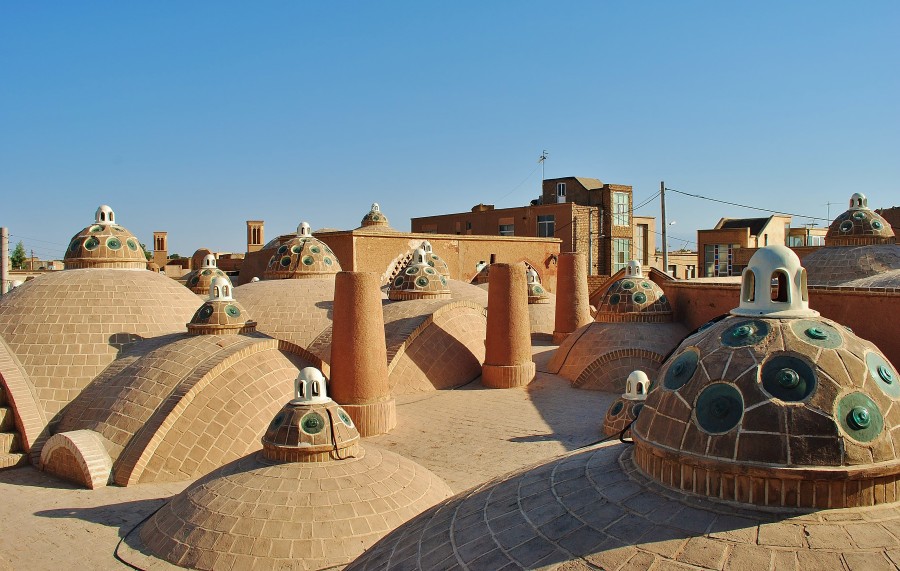
Roofs of the baths in Kashan, the historic city of Iran.
Other constructions that I recommend in the area of the ancient city are, for example, the thick walls of the Old City built of clay and sawdust, in the color of the desert. On one of its sides is a round, conical building reminiscent of a traditional ice-house. Travelers who want to see Kashan from a higher perspective can climb the wall. Despite the fact that in Iran I have seen many traditional baths I think that the good choice is the Hammam-e Sultan Mir Ahmad , which is an excellent example of a Persian bath built in the mid-15th century. I have read that for the restaurant work were used: milk, eggs, soya flour and lemon as supposedly stronger than cement. This bath is right next to the house of Khan-e Borujerdi and to see the characteristic of the Persian bathhouse roof I advise to climb the wall, which I of course did.
The next day I checked out of my wonderful historic hotel and took a taxi to Garden Fin , which is located 9 kilometers behind the center of Kashan. Fin Garden is a classic Persian garden and antique vision of paradise. It was built at the turn of the 16th and 17th centuries by the ruler of Persia Abbas I and over the centuries was perfected. It covers an area of 2.3 hectares and is surrounded by a thick beige wall with observation towers on its sides. In the middle are cut lawns and tall trees, although the characteristic feature is the water channels running through the center of the garden, around the green with the fountain as a climax. In addition to streams and pools in the Finnish garden, there is also a decorated, classic Qajar pavilion with paintings on the walls and on the ceiling. It is named Shotorgaluye Safavi. In view of the story, the bathhouse in which he was imprisoned and later murdered by the Persian nationalist and hero Amir Kabir deserve special attention. Although he revolutionized Persia for good in many important matters, the Shah’s mother had had enough of him and managed to persuade his son to get rid of him.
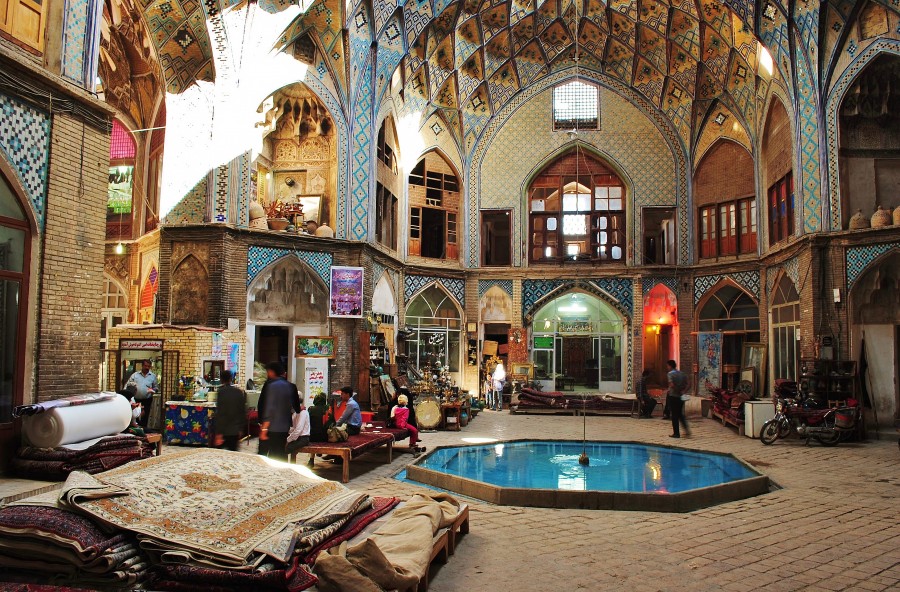
A traditional ancient bazaar in Kashan. Iran.
The Fin garden is a combination of nature and the use of water streams as a very important element of the whole structure with traditional architecture and Persian history. The outside of the garden is where you can drink tea and eat Persian dish and there are also cabs. It is all in the company of the lovely Lady both the garden and its surroundings can be a very romantic way to spend the day.
Then I got into a shared taxi and drove to Kashan Bus Station.
Kashan was a beautiful and very valuable stop on my Persian journey. Although the city is not listed in the top tourist attractions of Iran, I think it is as valuable as the historic Yazd or Shiraz, although it is smaller. In addition, Kashan is on the way to Esfahan, which visits all because stopping here is not a problem.
Transport from Kashan to Abyaneh
I took the bus towards Esfahan about 1.5 and got off at the fork of roads at Abyaneh. The ticket cost me 40,000 Rial. At the fork of the road I waited about half an hour for hitchhiking but I was not happy. I found myself in a large, deserted space. The wind was blowing in my eyes and there were only passing cars and my lucky little store in the distance, because I ran out of water. At last I lost patience and walked through the desert.
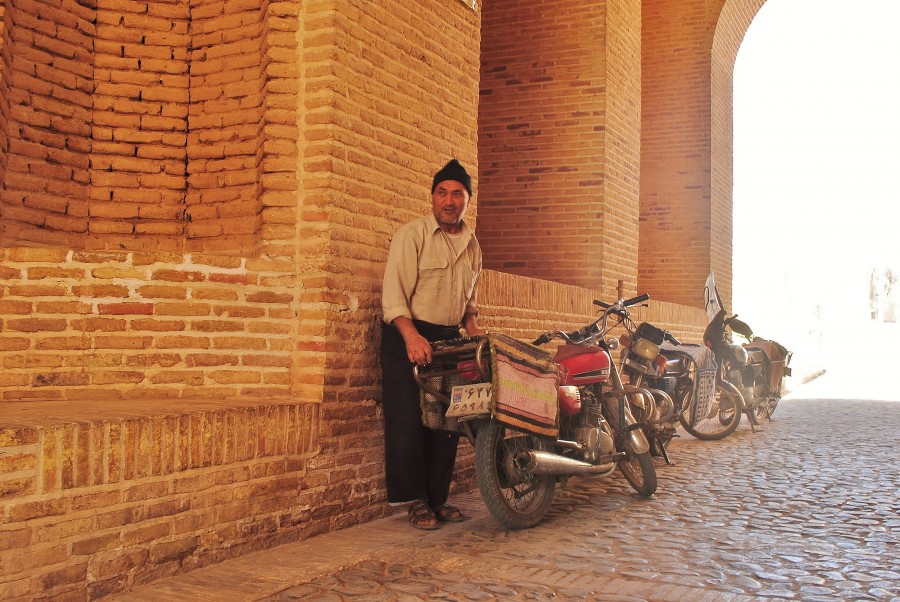
Photo from Kashan Street in Iran.
Luckily, there was an old man who was riding two men and a young woman. Everyone was excited to see me, because seeing White on an empty road in Iran, somewhere in the desert, it would be a forgotten way to see a bird dodo knocking at the door of the Museum of Natural History. My path led through the desert, though it was interesting because of the mountains and hills in the area interwoven with poor vegetation, and as long as I was not mistaken I also saw the ruin of a fortress on one of the sandy hills.
The owners blew me out just before Abyaneh so that I could take pictures and I could imagine that the Iranian president would welcome me personally in Abyaneh. Unfortunately ………… was without ovation, but at least I got there.
Abyaneh
Abyaneh is one of the oldest villages in Iran (I wrote above about the villages of Masuleh and Kandovan) because it is about 1500 years old. It lies at the foot of Mt Karkas (3899m above sea level) and was built of bricks made of red mud and towards the east, so that it receives more sun in summer and less frosty, gusty winds in winter. This village is very characteristic and sometimes called a red village and its narrow streets lead through two-story red houses, sometimes with wooden balconies. Due to its age and delicate structure, Abyaneh has been included among the cultural riches of Iran.
I think it is best to just walk around this particular village and observe its original beauty without looking for specific goals, and I assure you that wherever we go we will see a lot of red transporting us through time. Walking around Abyaneh, however, I came across a small Jameh mosque from the 11th century with numerous carvings and a reservoir in the middle. I also advise you to go inside to see red windows, huge logs, trees under the ceiling and the special atmosphere of the place reminiscent of Tibet.
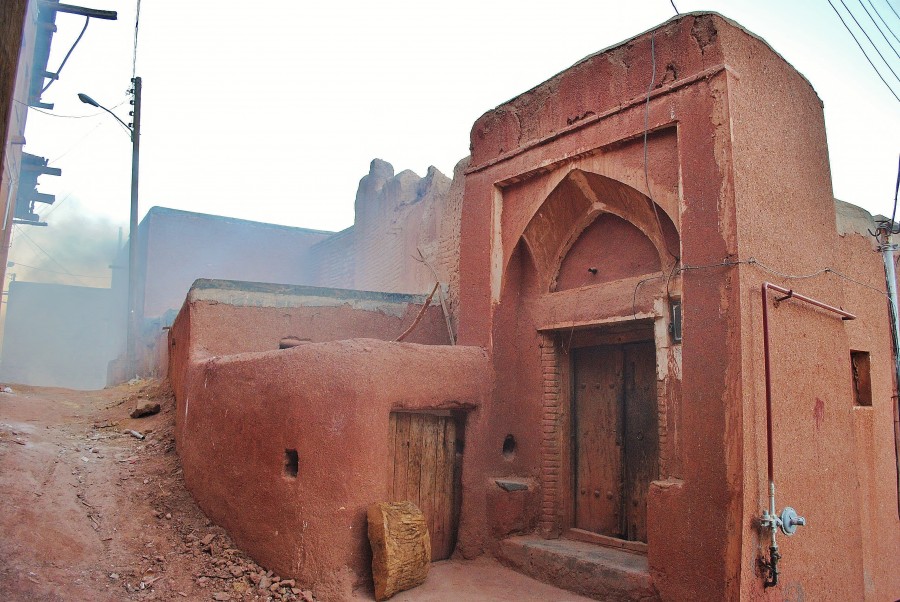
Abyaneh – a red sandstone village. Iran.
I also recommend not to notice the red background Imamzadeh-ye Yahya from the fourteenth century decorated with blue mosaic and Zeyaratgah chapel. All these objects are next to each other. But I liked the fact that I was in Abyaneh, walking around its narrow red streets, and also interacting with his very shy locals and bold tourists who wanted to take pictures of me. According to the census of 2006, the Abyaneh population is only 305 people, or 160 families. Apart from that, the inhabitants of Abyaneh are so special that they speak the old-fashioned dialect and wear distinctive clothes.
In Abyaneh there is a hotel called Abyaneh where I was able to spend the night for only 200,000 Rial with breakfast, although the price was much higher. I also recommend the restaurant on the main road where they serve excellent Persian food and where I had a conversation with the son of the owner. He said that many young people want to emigrate because there is no future in Iran and there are continuous bans, but he had a restaurant, a pretty wife and wanted to stay in Iran. They just got out of Abyaneh as the cold months were approaching.
Travelers can also cross the river and climb up to the ruins of the castle, even though the entire Abyaneh can be seen in an hour. I also recommend a local restaurant and spread the tent over the river. Let’s remember that adventure is there and always waiting for us and even a place as popular as Abyaneh can be discovered in many different ways. Abyaneh was well worth the trip.
Transport from Abyaneh to Esfahan
When I got out of Abyaneh, an old dinghy came up straight to the main road and then stopped the truck driving towards Esfahan. The driver blew me off in the suburbs of Natanz where there is a famous uranium enrichment center nearby . (By the way, I thought it would be funny if a Jewish American knocked at the Natanz police station and asked if they were selling tickets to this facility). I saw, however, that the truck driver did not want to go further, even though he was traveling to Esfahan. From the time we left for the main road, we were looking for buses or busses for one at Natanz. Before we got to Natanz he was in good spirits but they were closer to this place behaved more and more nervous.
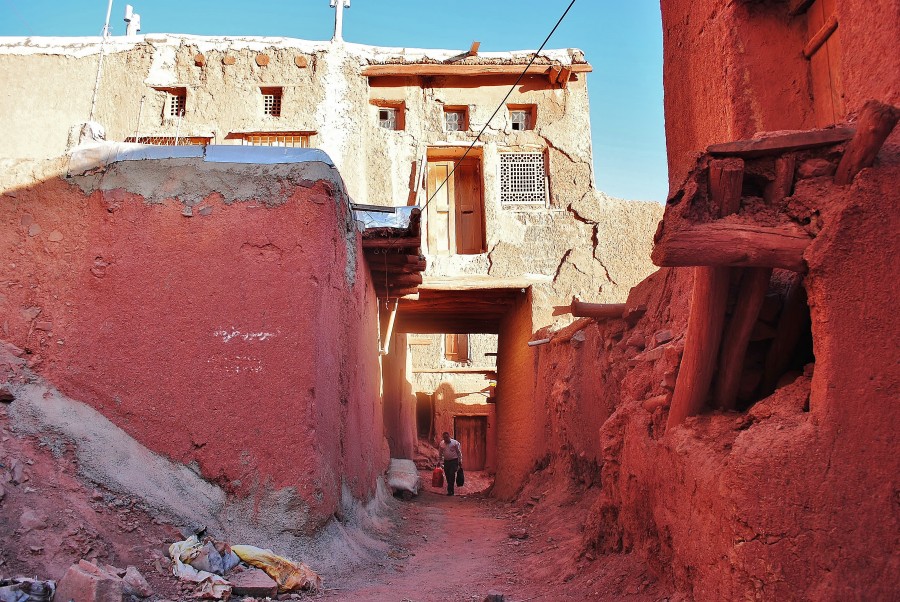
Abyaneh – a red sandstone village. Iran.
In Natanz, I became an unnecessary ballast, which was supposed to rid of.
From Natanz to Esfahan I paid 60,000 Rial and the bus driver ran out as he was sunburned, he loaded my backpack into the trunk and then quickly got me to the bus. He in Natanz simply did not want to be.
Esfahan
The old town of Esfahan is an architectural diamond of the Muslim world and a Persia jewel. Esfahan has a great traditional bazaar full of interesting art, shops with hand-woven Persian rugs, antique gardens and bridges, fountains and blue domes of great mosques. Old Esfahan is a great way to travel back in time to ancient Persia and therefore I advise travelers to set aside enough time for this special place. The traveler must have time to wander the old bazaars, to drink tea under the painted ceilings and to be invited for another tea in the traditional carpet lounge. The traveler will feel comfortable in Esfahan walking around the Persian gardens or to sit by the fountain in Khomeini Square, among greenery, horse-drawn carts and sellers of carpets, paintings and paintings on animal bones, having “great offer only today and only for you”.
Also, do not overlook the historic bridges and churches in the Armenian Quarter, as well as Persian restaurants. What ancient Rome, the Vatican or Athens is for an educated European, Esfahan is for a Persian; and Yazd and Shiraz. After the Mongols robbed and ruined this beauty of the city, at the end of the 16th century, Shah Abbas I, also known as the Great, transformed Esfahan into a thriving center of trade, culture and art. Esfahan became a city on the forefront of trade routes and the ruler’s dynasty built works of architecture and attracted outstanding craftsmen and wealthy merchants.
However, it should be remembered that all of Esfahan is not beautiful, but only the ancient part of it. Esfahan is today Iran’s third largest city with a population of over 1.5 million plus traffic jams and heavy poison air industry. In addition, in the vicinity of Esfahan there is also a nuclear power plant where uranium is enriched, which is one of the main problems of the Zionist regime.
When I arrived at the train station in Esfahan, I was accosted by many taxi drivers who wanted to give me a lift to the cheapest hotel in the city for Rial 100,000, but in the end one picked me up for Rial 20,000 because that is the price for one person. I got off at the Amir Kabir Hotel, which is the cheapest of the cheapest in all of Esfahan and where I paid only Rial 200,000 for the floor mat with breakfast. The Amir Kabir Hotel is very close to most tourist attractions and has friendly service.
Old Esfahan around the Jameh Mosque
On the same day I went to see Esfahan and first got to Imam Ali Square, which has it’s own that is above all huge. It was built on 32 acres near the historic part of Esfahan and according to historians it has about 800 years and has recently been rebuilt keeping its traditional Persian style. These two things came to mind when I saw this great concrete block surrounded by traditional arches with a dry fountain in the middle.
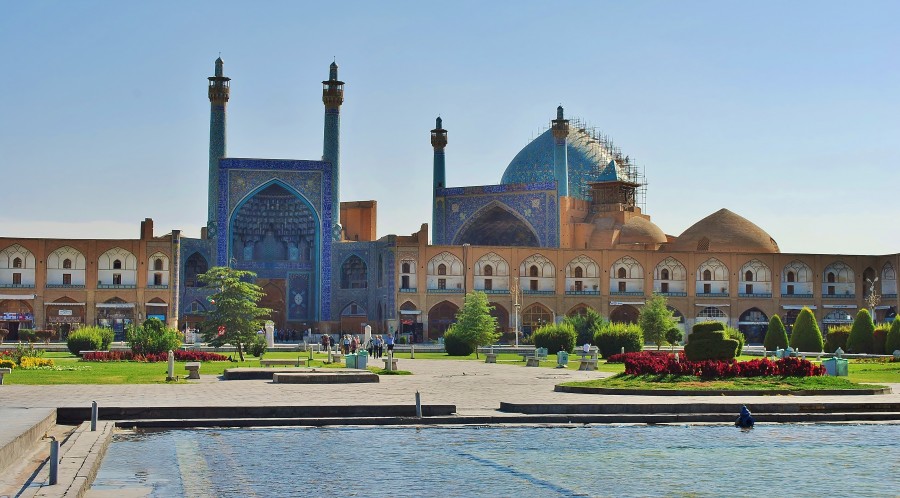
Old Esfahan and Imam Ali square. Here is the history and culture of Persia, and the most interesting objects for tourists.
After a long analysis of this square, I was informed that the square of Imam Ali was built so that according to the plans and opinions of the Muslim clerics it reflected the Islamic Revolution, because people wanted to protect the Islamic Revolution and thereby revive the Esfahan identity. Could it be ??? As far as I know Esfahan was born hundreds of years before the Islamic Revolution and its monuments were not built for the revolution of old, fanciful clowns but for art, culture and commerce. I am writing to highlight the fact that the regime in Iran will use every act for its own political purposes, just as the liberal-leftist regime of the European Union uses black, Muslim and homosexuals for its political purposes.
In any case, Imam Ali Square is close to Bazaar-e Bozorg and the historical Jameh Mosque and marks the beginning of the road to Imam Chomeini Square, full of monuments and shops with art and souvenirs.
In front of Imam Ali Square I also stopped for a small snack and tea at a local pub. This place is located right next to a shop with pots on the street and is a good point of view for women in black sheets bargaining for home items.
Then I left Imam Ali Square and went to an antient bazaar called Bazar-e Bozorg . Transitions under Persian arches, based on small domes, are a place of social conversation and fierce trade. The bazaar is composed of many covered and crowded passages plundered with goods and large decorated rooms devoted solely to Persian carpets and, of course, tea drinking among bows, domes and mosaic terracotta and frescoes. Bazar-e Bozorg is a team of passages, corridors, arcades and chambers of former servants as masters and caravanserai, today serving as one big bazaar, the heart of Persian culture. Especially near the Jameh Mosque, this part of Bazar-e Bozorg is about a thousand years old but most come from the early 17th century, a time of turbulent expansion under the rule of Abbas I.
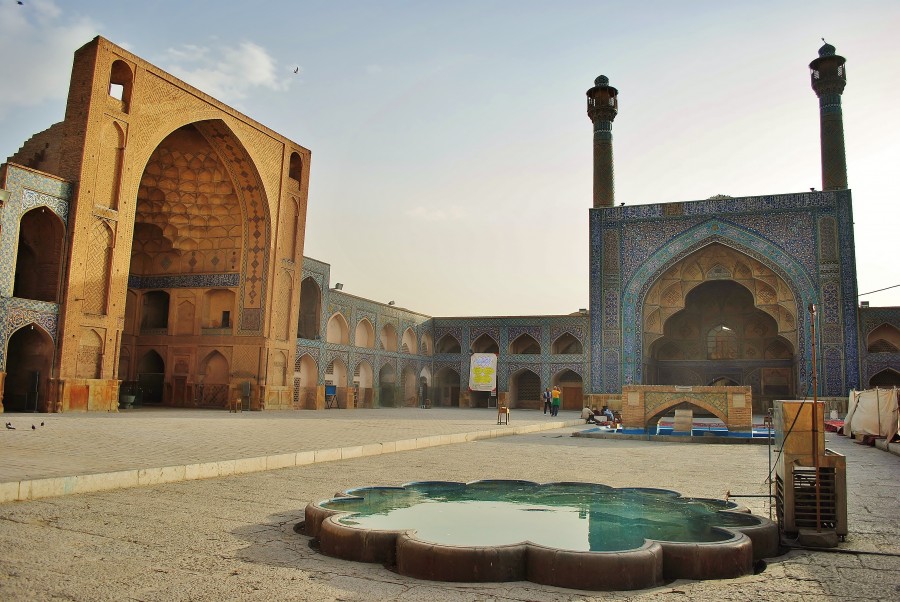
Jameh Mosque in Bazar-e Bozorg. Esfahan; Iran.
In the area of Bazar-e Bozorg there is the Jameh mosque and although it seems that there is nothing special in another mosque, this one is worth seeing due to its age and design. Although the area served as a place of prayers, the construction of the Jameh mosque had already begun in the 11th century, and then over the centuries various dynasties ruling over Iran built subsequent elements of it according to their own style and discretion. The Jameh Mosque, which is the largest mosque in Iran as it covers over 20,000m², takes us on an architectural and historical journey through the times of the Seljuk, Mongols and Safavids.
Given the enormity of the main rectangular courtyard, prayer rooms, the wealth of arches, pillars, mosaics and ornaments, the Jameh Mosque has great historical value. On the south and north side there are two huge gates covered with a blue mosaic, and in the middle of the square there is a fountain imitating the one in Mecka. In addition, there are also rooms built in the 13th and 14th centuries decorated with Koranic inscriptions and flower patterns. Over the centuries, the Jameh mosque was also destroyed by earthquakes, but its perfect geometric structure survived. Much recognition is also given to two domes named Nezam al-Molk and Taj al-Molk, which are considered mathematically the most perfect dome in 900 years and which has survived all earthquakes thanks to this. These domes are among the oldest parts of this mosque.
When I left the Jameh mosque it was late afternoon so I didn’t want to visit any longer. First, I sat around the Jameh mosque eating ice cream and looking at the goods. Even though it was getting late, I walked through the covered tunnel of empty shops to Imam Khomeini Square. I was at the fountain and looked around a bit, but on the other hand I didn’t want it to be my main day of visiting this place. Soon, after dark, I returned to the Amir Kabir Hotel and sipped my tea watching pictures of Esfahan and Abyaneh.

Ali Qapu Palace in Esfahan, Iran.
Old Esfahan around the square of Imam Khomeini
The next day I went straight to Khomeini Square which is in the Esfahan Historical Center and which is a UNESCO World Cultural Heritage. It was constructed at the turn of the 16th and 17th centuries and on an area of 89,600m² there are many monuments from the Safavid period. The square is surrounded by the traditional Grand Bazaar, where you can buy the splendors of Persian art, rugs in very atmospheric salons, tableware, crystals and simple postcards while walking under a covered, arched open tunnel. I was invited here to a beautiful salon with hand-made carpets where the seller offered me tea and others spread out silk beauties with wonderful patterns in front of me.
The oldest parts of the bazaar are about 1000 years old and this facility is one of the oldest and largest in the Middle East. At Chomeini Square, 512 meters long and 163 meters wide, there is a large body of water with fountains, carefully trimmed lawns and well-kept trees. There are also horse-drawn carriages here, and despite the large territory, everyone can find a quiet place for themselves. The bazaar itself, built on the edges of the great square, is a rich museum of beautiful objects and interesting architecture. Initially, Khomeini Square was called Naqsh-e Jehan which means “model of the world” and let us be glad that the Muslim pattern did not dominate the whole world. When Shah Abbas the Great began to build this square, it was to be the center of the new capital and the pearl of the Safavid dynasty, and therefore his plan was to build facilities on its territory that would become a timeless classic of Muslim art. The Shah was so absorbed in the construction that he brought the best artists also from outside Persia. He brought the Chinese to teach the Persians to make porcelain, as well as Indians and European artists and craftsmen.
Under the Shah Abbas, Esfahan was a conglomerate of many civilizations and cultures while respecting their own, and it is therefore extremely important to say that the Shah invited those people who could enrich Esfahan economically, culturally and socially as well. (So it was not a Marxist-infested utopian vision of multi-culti where the liberal ruler collects rubbish from all corners of the world for his political ends). Three objects that will surely catch everyone’s eye are the Ali Qapu Palace on the west side, the Sheikh Loft Allah Mosque on the east side, and the Shah Mosque on the south side.
It is also worth mentioning that Imam Khomeini Square appears on the Riyal 20,000 banknote and is the second largest square in the world after Tienanmen Square in Beijing.
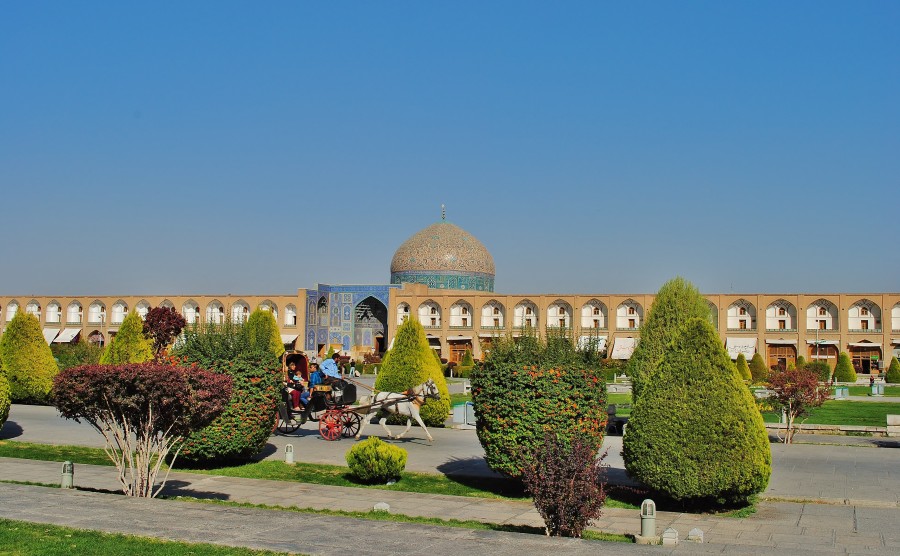
Old Esfahan and Imam Ali square. Here is the history and culture of Persia, and the most interesting objects for tourists.
The Shah Mosque (Masjid-e Shah) is the culmination point of the Safavid architecture and the cultural gem of ancient civilization. This mosque has a traditional gateway with two minarets decorated in mosaics and mosaic patterns and the largest dome in Esfahan. Inside there are traditional elements such as a courtyard with a water body and two more gates adorned with advanced calligraphy and Muslim motifs by the finest artists of the time. The property also features two madrasa (Muslim schools) and modular dome rooms reflecting the stylish dome.
It is also worth mentioning that although the main entrance is directly facing the fountain in Khomeini Square, it is the same Shah Mosque and the square in front of it is directed towards Mecca. The geometric symmetry of this mosque and the white marble at its base, transformed into a turquoise, decorated mosaic, make it one of the best in the Muslim world. Construction began in 1611 and ended in 1629, which means that the beautification of this place of worship took up to 18 years. This mosque serves tourists and prayers to Muslims.
Sheikh Loft Allah . This mosque is smaller than the one I described earlier and does not have minarets or courtyards. However, according to experts, the calligraphy on blue mosaics, both at the main gate, on the big dome and ceiling, exceeds the performance of the previous mosque. The fact is that the Shah Mosque was a mosque for all while the Sheikh Loft Allah Mosque was only used by the Shah, his entourage and his family and numerous harems. For years he could not get anybody but Esfahan people could admire him from the outside. This mosque also needs to be seen during the day and then again during sunset to see how the colors change on different parts of the mosaic covering the huge dome and to which illusion leads the game of lights inside. It stands in front of the Ali Qapu Palace and was built between 1602-1619, before the Masjid-e Shah.
Ali Qapu Palace is not actually a palace. It is a 6 storey, decorated with arches, pillars and interior paintings pavilion, whose main task was to fulfill the role of a majestic gate. This 48m tall rectangular building was also designed to impress guests and make the most of it. Ali Qapu has many rooms where paintings on the walls and ceilings are considered one of the best while the narrow stairs lead us to the terrace. The terrace is backed by 18 pillars and is decorated with paintings. From this place is the best view of Imam Chomeini Square, the bazaar and two mosques from a higher perspective. When I was here was unfortunately repaired and had to jump from one plank to the other to reveal the better view of the cellophane. In the Safavid era, when they were born, they were sitting on the terrace of Ali Qapu, where they watched the Esfahan jewel and entertained foreign ambassadors and watched the polo and horse racing events that once took place here.
Ali Qapu Gate was built in the late 16th century.

The Chechel Sotun pavilion and the beautiful park that surrounds it are on the list of world cultural heritage under the name of the Persian Garden. Esfahan, Iran.
After leaving Ali Qapu I turned right and then again right and across the street of carpets and souvenirs I got to Sepah street where there are exchange bureaus . Next to this street there is, among others, the Museum of Art, the Museum of Natural History with dinosaurs in front of the entrance and the chapel of Chechel Sotun , which I will describe now. Chechel Sotun Pavilion and the beautiful park that surrounds it are on the list of world cultural heritage under the name Perski Garden. It was built in the first half of the 17th century under the rule of the Abbas II Shah, and its purpose was to show the beauty of Persian gardens and pleasant walks amidst greenery and exquisite art during which the Shah entertained foreign guests. At the entrance, a long pool with fountains surrounded by a pedestrian street, sculptures and beautiful plants appeared. I admit that I did not go straight away because it took me the richness of the colors of the garden, its calmness and versatility.
Chechel Sotun means “20 columns” referring to 20 narrow wooden columns that are the pillar of a two-story pavilion behind the pool and reflecting in the water. This or rather the Throne Hall is built with the architecture of the Safavid dynasty, although I liked the frescoes on the walls of the Persian-Uzbek period, as well as between the Persians and the Ottoman Empire. There are also merry frescoes like those when Shah Abbas II greets a foreign guest with musicians and dancers.Chef Sotun also has a coffee shop, a bookshop, and many soothing green areas and exotic plants that are a pleasure to take in. To me, for example, was an old, cut tree behind the Throne Hall.
Although according to historical records Chechel Sotun was completed in 1647, what we see today comes from 1706 as the object was rebuilt after the fire. Then in the 18th century Chechel Sotun was invaded by Afghans who blurred the frescoes with white paint because they considered them too extravagant (read: they had a complex of inferior Persian art).
Escaping from Esfahan, you must visit the Chechel Sotun gardens.
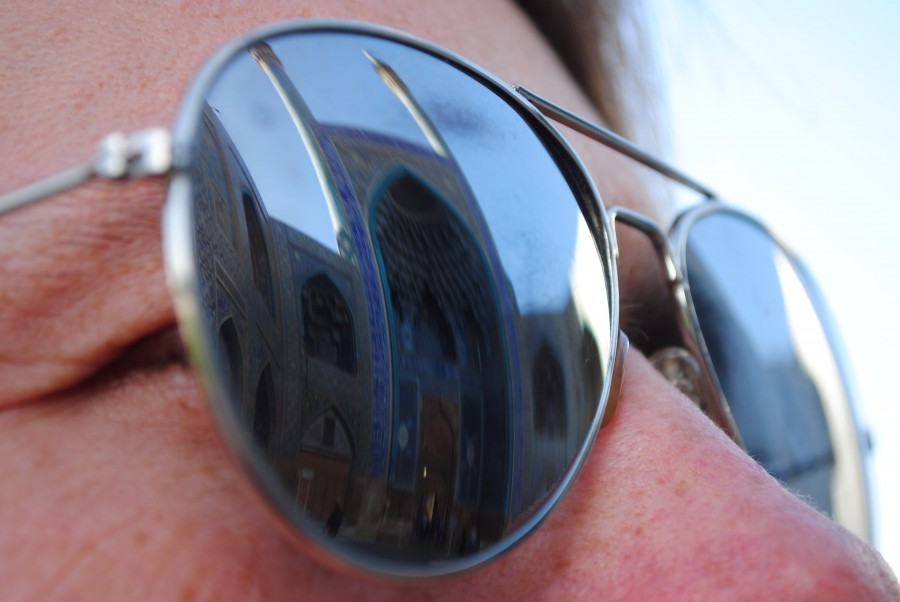
The mosaic mosque of Esfahan seen in my glasses. Iran.
A few minutes walk from Chechel Sotun there is a park , which is another quiet place where you can relax on the benches among the trees. Noteworthy here is the Hasht Behesht Palace, meaning “seven heavens”, which was built in the 1660s. When I was here the entrance was fenced but it is a construction similar to the pavilion in the palace of Chechel Sotun. Also here the construction is supported on wooden pillars and the interior is decorated with mosaics and ceilings cut into various shapes. Behind the wall is another object. It is Madresah-Ye Chanar Bagi (Muslim school) built between 1704-1714 but unfortunately its entrance is closed for most of the year. It is also worth mentioning that from the park in the opposite direction to Chomeini Square on the main street there are entrances to another two antique bazaars . The entrance leads through a large wooden door and the center looks like a tunnel decorated with mosaics and jewelery shops.
Marriage offer with an Iranian woman
Sitting in the park, I had an interesting meeting. Well, an older man approached me and asked me if I was looking for a wife because he knew a pretty girl who was looking for a husband. He said that “God is happy when two people love each other.” I have no doubts that it is so, and even though I wasn’t looking for a wife, I thought it might be an interesting meeting, so I didn’t finish this conversation. The man wanted me to marry her and necessarily take her to Europe, but I replied that first I would have to meet her, invite her for tea and talk so that we could get to know each other. In the end, none of it came out, but it occurred to me that there are matchmakers in Iran who are looking for European husbands for Iranian women so that they can go to Europe with them.
Despite the fact that in Iran there is total media control and even a blockade of the part of the Internet that is unfavorable for the regime, young Iranians are nevertheless fed on how “wonderful” life is in Europe and how much freedom there is. It is, in my opinion, selling dreams that many young Iranians want to believe because they are tired of Islam and the constant bans. As in many other countries where I have been before, the white man is “a gateway to prosperity, freedom and probably has wealth at home”, although in Iran this image is not as unreal as, for example, in India or Cambodia. I also told him that I am a Catholic and that is why it is very important to me that my wife is also. He replied that it was time for it, although I think he would be able to tell me everything I want to hear, so that I would just buy her a ticket and take her to the “European Eldorado”.
Zayandeh River (ecological catastrophe) and antient bridges
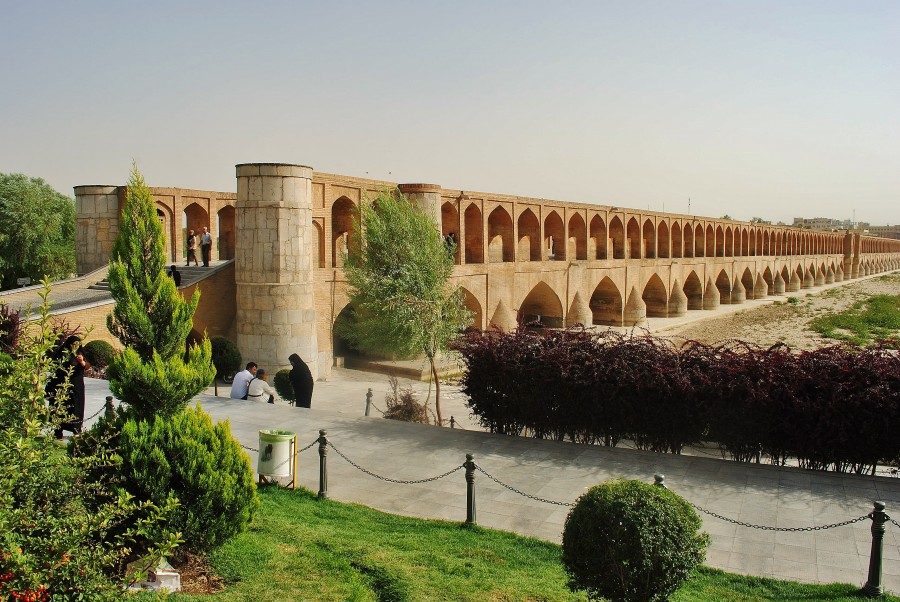
Given the desert climate, Iran is not a major river country, and the river Zayandeh is fed by the Zagros mountains and it does not even reach the sea. I would also like to say that it would be nice to walk, swim or fish, but unfortunately this is impossible because the river is dry . Being here instead of water, I saw dry land and where dry dry bushes grow on the bottom. This is a huge blow for Esfahan, for his people and for millions of tourists; And given that in the desert there is less and less water, these are just fatal messages.Ironically, the translation of this river is “the one that gives life,” but since 2010, when the river has dried up more appropriately, the name proposed by many Iranians is “the one who gives up”. There are still lawns, pedestrians and sculptures on the banks of the river, and famous bridges of art, but the rivers are still empty, and I do not think even Allah will help the Muslims to bring them back to life.
According to official opinion (ie this false) loss of the river Zayandeh was caused by “drought” although no one asks how it happened that before 2010 Iran was exactly as dry as today and the river was still flowing through Esfahan. The senseless planning, senseless politics, waste of water and the transposition of the Muslim ideology over ecology and human health are the fault of this disaster. The Ayatollah regime found money for further mosques and the renovation of Imam Ali Square, but after the seasonal drought there was no one who would prevent a permanent drought. This means that the Iranian government was warned of the impending disaster in the form of seasonal drought, but he did not do anything because he preferred to pretend that there was no problem. Ignorance and apathy are one of the specialties of Iranian government at the expense of the people.
The Romans and the Greeks were the champions and precursors of the bridge, which is another proof that the world was fertilized by the light of the White Civilization and that the world took the example of Europeans. The Persians also learned this art from the Romans, though of course they had to adopt their own style which would be compatible with the art of Islam. Exactly the same with the irrigation of the channels, the Persians also learned from the Romans. Especially in the dry desert climate, water policy was extremely important because only good water management could lead to irrigation of cities and fields.
Persian bridges built in Esfahan come from the days when Persia ruled Shabbat Abbas I and then Shah Abbas II, which was the turn of the 16th and 17th centuries, and served not only passersby but also for the transport of goods, but also for decorative and recreational purposes. There are many places that allow passers-by to privacy on a few levels, which also provide good viewing points for the river, and repeated arches provide protection from the burning sun. As we see the Safavid dynasty rulers simply did not want their bridges to run from one shore to another, but also to be the meeting point and observation of nature and other people. For that, the part for passers-by and the rest was very well separated from the vehicle parts.
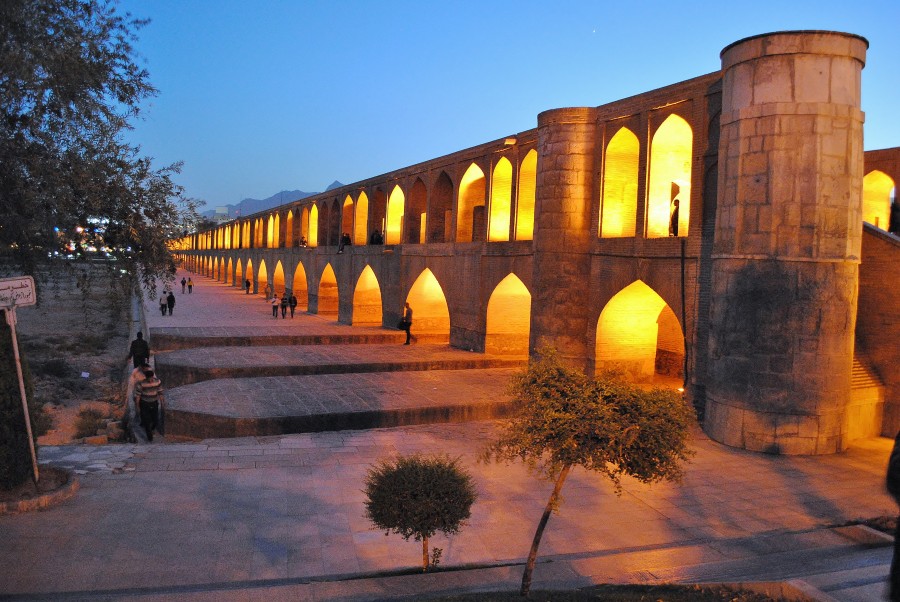
Allahverdy Khan Bridge in Esfahan, Iran.
A good example is the Allahverdy Khan Bridge, also called Si-o-Seh Pol , which literally translates as 33-arch bridge. It is exactly 298m long and was built between 1599 and 1602. Today it is used as a bridge and a few years ago when there was still water in the trough also as a dam. Its spectacular massive structure consists of 100 identical arches, which means that the bridge is essentially a continuation of the same element.
The second bridge, which is one of the most beautiful is the Khaju bridge , built by the Shah Abbas II in 1650. It has a very large, wide gate, and like the Si-o-Seh Pol bridge it also serves as a dam, though in this case double. It consists of two floors and is decorated with murals and mosaic tiles and is also a continuation of one and the same arch. Besides, it looks more effecient to have stairs at the entrance to the water and 3 pairs of wide towers. Walking down the lower floor you can see the gates, which shut down regulate the flow of water (or would regolade if the water was still there). Khaju Bridge is 110 m long.
The nearest bridge from Khaju Bridge is the Chubi Bridge, with 21 arches and measuring 150m. It was built by the Shah Abbas II in 1665 to provide additional irrigation of the gardens in the surrounding palaces. The bridge is the most modest of all but is close by and it’s a nice walk.
Another bridge is the oldest bridge in Esfahan called Shahrestan , which has a length of almost 108 meters and a width of over 5m. It was built in a different style from the previous because its shape is parabolic which means that the highest point is its center. It also has two levels of arcs; 13 at the bottom and 8 at the top and it is much smaller in its form than the previous two that I have described. According to historians, the Shahrestan bridge dates back to the 11th or 12th centuries, although its foundations are from the 3rd to the 7th centuries. Also, this bridge is located on an artificial lake near the river, 3-4 km from the Khaju Bridge. It is a pleasant walk, which I advise to take in at least one direction.
In many bridges there were also tea rooms, and when there was still water in Zayandeh, they had to be very atmospheric places. Today, in one of the bridges, there was only a souvenir shop and merchants and photographers on the dry banks of the river Zayandeh.

Persian souvenirs in Esfahan. This is what ancient Persia is, not the Islamic Republic of Iran.
The Jolfa Armenian quarter
Shah Abbas I brought the Christian Armenians in huge numbers from the city of Jolf, which is now on the Iranian side. The Shahs appreciated that the Armenians were good artists and had the talent to trade and therefore gave them some of the land outside the center of Esfahan. Their religion was respected although the Armenians were kept in one place far from the Muslim centers. (I admit that racial-cultural separation is a very good policy that would be useful in the current Europe.) Today in Esfahan there are about 7000 Armenians and their center is located around Vank cathedral, several other churches and cemetery.
I got a bus from the vicinity of Khaju Bridge but I think the walk would take about half an hour.
The place to be missed here is the Vank cathedral , built between 1606 and 1655. From outside this cathedral is not the most beautiful, especially because it has a Muslim dome, only that with a cross at the top. But inside there are wonderful frescoes depicting Jesus and the Last Supper and geometrically perfect shapes. Outside there is a tree square at the entrance and in the same area of the Vank museumwhere you can see hand-written Armenian books, paintings and ornamental objects from Armenia, as well as documents showing the Armenian genocide by the Turks.
There are also two other churches, the Bethlehem Church and the Church of Sts. Maria . The second one was still open so I went in to see some attractive frescoes. I only saw Bethlehem because I climbed the vegetable stall and then onto the wall. Unfortunately, it is often closed. The majority of churches in Iran look like mosques, but with the crosses on the Muslim domes and the Bethlehem church is the best example.
In the Jolfa district, young Iranians feel safer because they are in the company of Christians. Two young kittens hooked me up to talk to me and then offered a photo together. They are really better without the Muslims because they have found me safe. They told me they saw a religious police who did not come to them just because they were with me.
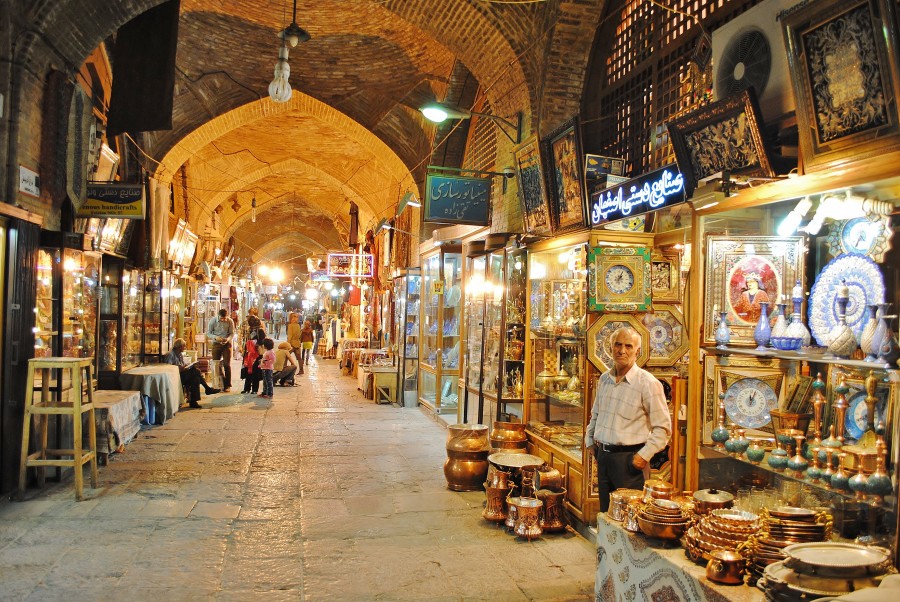
Traditional Persian bazaar in Esfahan.
● ● ●
Then I came back to the river again, then invited to a cheap but delicious Persian restaurant and returned to the hotel Amir Kabir. My adventure in Esfahan was over so I took my big backpack and took the bus to the station. Esfahan was indeed a very valuable place to visit, which should not be missed.
More interested can also include the Shaking Minarets and Pigeon Towers in their travel plans.
Transport from Esfahan to Yazd
No obstacles on board a good coach, although I bought a ticket at the last minute. The ride lasted 4h and for the ticket I paid 80,000 Rial.
Yazd
(Stay 1)
Desert Yazd is in my opinion one of the most beautiful cities in Iran and a unique architectural place.Situated 270km southeast of Esfahan, the old city of Yazd looks like it was made up of the desert. Yazd is also popular because of its beautiful souvenirs, hand-made Persian carpets and sweets. Yazd is also a city with a large community of zaroastrian – followers of the ancient religion of ancient Persia where there is also one interesting temple. In addition to the ancient places each has its story in Yazd there are also good tea rooms, beautiful Persian garden, numerous decorations on the ceilings and characteristic wind towers.But above all, the old thing is that the old Yazd is almost entirely made of sun-clay, which means that the material used to build the desert itself. The story of Yazd is about 3000 years old.
Due to its location, Yazd is also the dearest of Iran’s main cities and one of the hottest. Temperatures above 40 ° C are usually maintained between May and September.
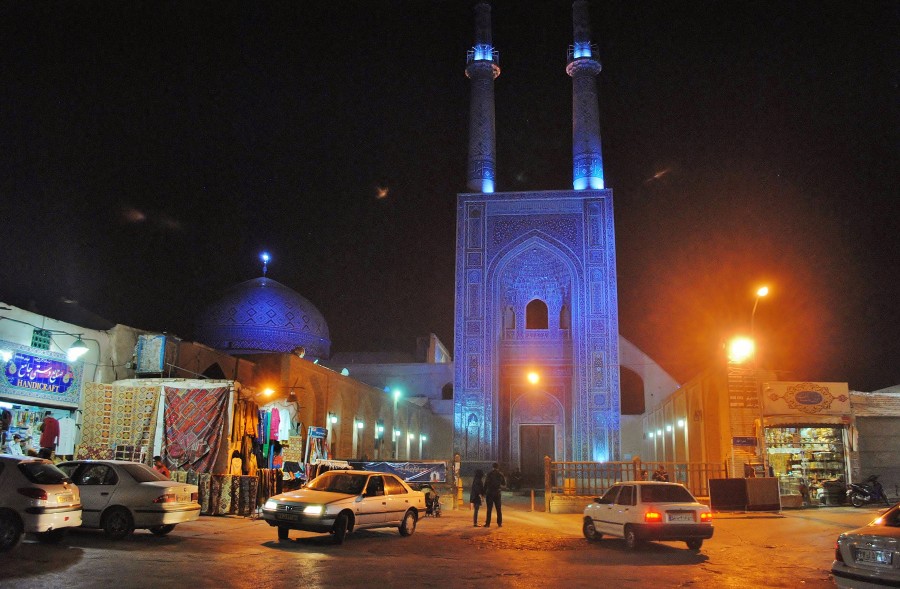
Khomeini Mosque in Yazd. Iran.
When I got off at the bus station there were no taxi drivers who would take me to the Old Town. Finally, I got into a taxi and for only 30,000 Rial I managed to reach the Jameh Mosque, which is the official place where the “antique adventure Yazd” of every traveler begins. I arrived at night so I first saw the Old Town at night which was impressive due to the shapes and shimmering blue light mosaics domes and minarets. I immediately went to the Silk Road Hotel, which is located in an ancient caravanserai with a courtyard and a water body in the middle. I was lucky because it was the last place in a dorm room for only 150,000 Rial with great breakfast. The breakfasts were actually feasts of good bread, natural yogurt and jams. I’d add that a taxi driver earlier took me to another antique hotel where the boss wanted to push the room for $ 20 but I knew how much I could pay.
On the first day I did not visit because I was already on the way and Esfahan cost me a lot of concentration.I made a day of rest from travel plans. I went to bed, did laundry, wrote a couple of postcards and used the internet. I was also on a good Persian meal, supplemented the diary and generally had an organizational day.
Yazd Old Town
The Old Town of Yazd is a maze of small streets and corridors that “emerged” from under the endless sands of Persia. The unique architecture of desert mosques and houses hides unforeseen alleys and streets where you should wander aimlessly and perhaps even get lost to discover this special place on your own. Due to the heat of the desert city, on each roof there are badgirs that look like chimneys, because in the desert climate every air breeze is very important. The Old Town is not big and it is also well marked, but I didn’t look at the signs and walked straight ahead, finding what I wanted anyway.
Walking through the clay walls of empty squares and alleys, I sometimes came across women wrapped in black sheets, sometimes a motorcyclist who did not know brakes, and other times a wooden, carved door behind which there were shops with painted tiles and carpets. Of the many places I saw in Yazd and nothing special that just makes my adventure original, I recommend that future travelers must also enter one of the many roofs. I also really liked the arches that connect the clay walls. In addition to the wonderful views of the desert city, it is worth touching the wind catchers, seeing them up close and avoiding the sheets dry from the sun, sitting on small domes.
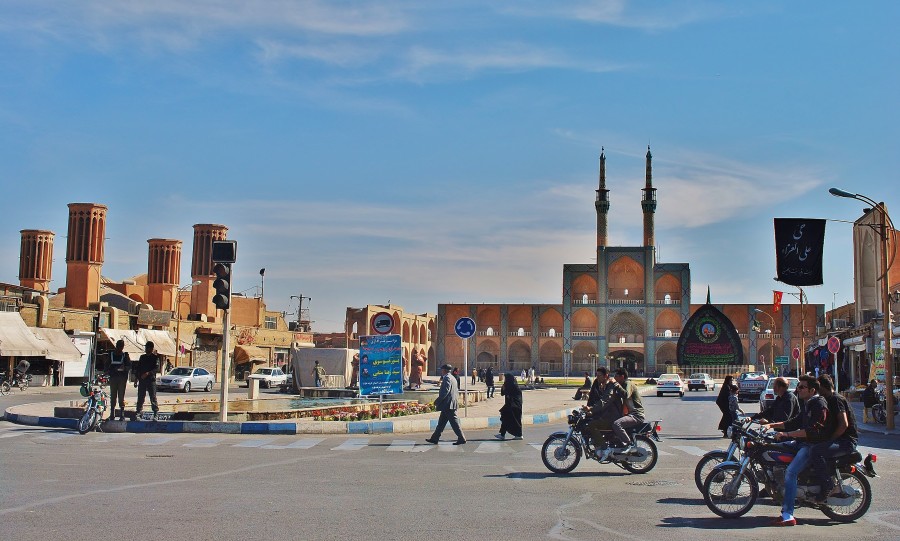
The desert city of Yazd and Amir Chaqhmaq and the ‘wind catchers’. Iran.
In my opinion, the city of Yazd in terms of building in clay in the color of the desert can only be surpassed by the ancient city of Khiva in Uzbekistan. Both Khiva itself and my journey through the Kyzyl-Kum desert are epic stories on the Silk Road.
The first object I saw after leaving the Silk Road was the Bogheh-ye Sayyed Roknaddin mausoleum. The property is currently under renovation so getting in to the center is unlikely. This mausoleum is about 700 years old and has a huge blue dome and mosaic decorations on some parts of the outer walls. Most visitors only need to see the huge dome during the day and at night, while the invaders advise to knock on the gate. My mazoleum was most loved after dark when it was lit up and complemented by the Jameh Mosque standing next to it.
Then I went to Masjed-e Jameh Street and spent some time in the gift shop and to replenish the water supplies. The main attraction was the Masjid Jameh mosque, which is a showcase of the Old Town. Jameh Mosque is not the largest of the Persian mosques, but it is the highest I have seen and its blue mosaic decorated with multi-colored murals takes the breath of anyone who likes art. The characteristic gate to the mosque ( iwan ) is rich in mosaics and at its top are two high minarets, which are 48 meters long and are decorated with 15th century inscriptions. Inside is a relatively small courtyard, though there are also carefully finished chambers decorated with blue tiles and arched doors inside the walls ( mihrab ). I also advise to pay attention to the ceilings and the back gate to the mosque, whose mosaics took me a little longer usually nothing. I also advise you to shop around as you can get to the top of the mosque for better views. I know this is possible.
Jameh Mosque is about 800 years old, although its various elements were rebuilt in the following centuries.
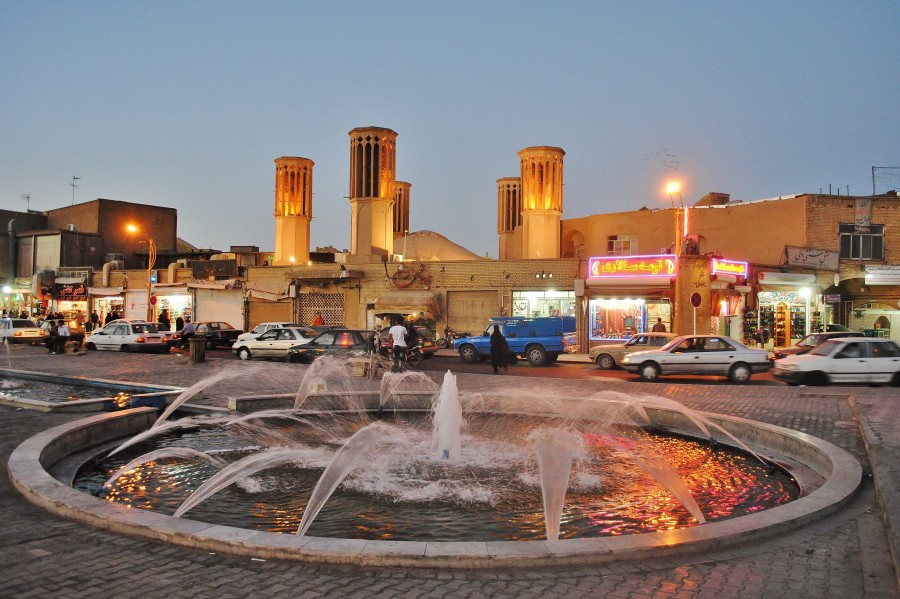
Yazd old town, and ‘wind catchers’. Iran.
My next walk in the narrow streets of the Old Town was an adventure in itself and it made me most happy.Among the clay houses and attractive roofs with chimneys that capture the wind, however, one should pay attention to a few objects. One of them is Khan-e Lari , a well-preserved 150 year old Qajar house. It has traditional roof-top towers, wooden doors and arches and windows with elaborate stained glass windows.It now houses a cultural center and a student center for architecture. In the middle is a courtyard with a water body and covered passages covered with arches.
There is also the 15th Century Prison of Alexandra,although I think that all the stories referring to Alexander the Great should be inserted between the fairy tales. The building is entirely built of clay bricks in the form of a mosque and is characterized by a typical dome surrounded by geometric patterns. Inside, there is a courtyard and Muslim architecture typical of Persia, not covered with blue tiles. Nearly there is also the Tomb of the 12 Imams in which there is no grave or Imam or anyone else. While here I advise to go under the dome and look up. This place in my opinion deserves a renovation.
Before Alexandra’s Prison there is a pleasant square planted with plants where there are also very interesting souvenir shops.
In the afternoon I walked the main street where there are many shops and where it is very interesting for people. It’s Imam Khomeini street and although in the early hours people hide behind the heat and the shops are closed then after an afternoon heat wave the whole street gets alive. I liked the candy store most though I spent most of my time in shoe stores. I had to buy shoes even though I could not walk to the shops with clothes and shoes. I have found that it is better to buy Iranian shoes because these are durable and are of high quality although they are two or three times more expensive than imported from China and Vietnam. I unfortunately bought Vietnamese shoes and my soles stuck on the first day and the second day they stank so I had to throw them out. Imam Khomeini was often used as a walkway, as Amir Chaqhmaq Square is a short walk away and there are even more attractions.
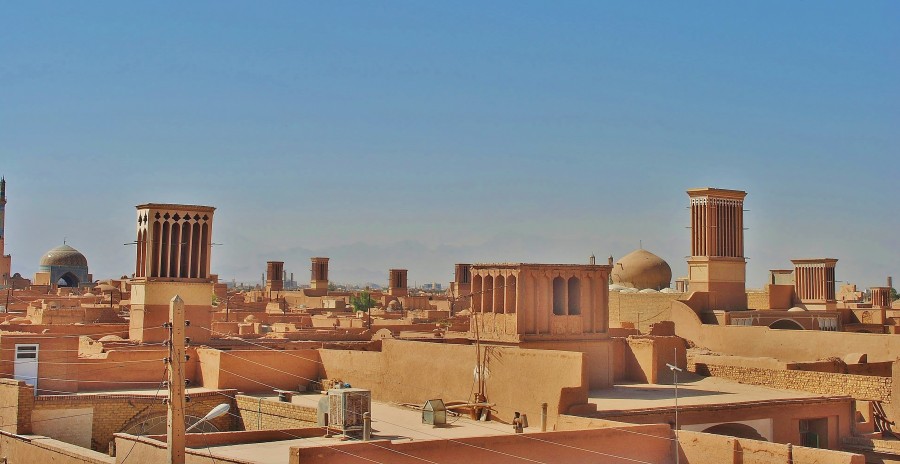
View on the desert roofs in the old town of Yazd, in Iran. Please note the towers called “wind catchers”.
I really liked the Amir Chaqhmaq Complex here and the square with a fountain and sculptures underneath it. This building is one of the most famous buildings in Yazd and also in Iran. Its structure consists of a three-story façade decorated with arched, symmetrical alcoves and two tall minarets at the top. The first two floors are the same width, while the third has only 3 alcoves and are the introduction to the minarets. The construction of Amir Chaqhmaq covers the width of the entire square, while in its lower parts there are kebab bars, which are opened when there is sufficient interest. It is also worth saying that this object is called tekyeh, which means the place where Shi’ite Muslims mourn the murder of Husayn bin Ali.
There are many such buildings in Iran, although the most were in the Qajar dynasty and Amir Chaqhmaq Complex is the largest. In front of the building there is also a nakhi, a wooden structure used for religious purposes. For me personally, even without any knowledge about it, the nakhi is a nice decoration that looks good in the photo, although it could also be used for practical purposes, perhaps in agriculture or animal husbandry. At the very beginning of the square there is a breath of freshness with a water reservoir with a fountain and a very interesting sculpture depicting three men taking water.
Next to you will also find the gym and club Saheb A Zaman Club Zurkhaneh , which is located in the former water reservoir supplying Yazd once. From the square on which stands Amir Chaqhmaq most of my eyes were thrown 5 badgirs , ie looking at the chimneys air towers. On the other side of the square is also the Amir Chaqhmaq mosque but I do not want to once again describe the blue dome and the mosaic on the walls. It is important to know, however, that if the kebabs did harm us then the toilet is right in front of the mosque!
Then I crossed the street, pushing for the strength of the cars, and I was already at the bazaar , where you can see Persian surprises from almost every field. The bazaar in Yazd is thousands of years old and he is one of the better ones in Iran. There are silk materials, blue vases, jewelry and other things that make women have a lot of money to spend here. I also found a shop with interesting paintings and carpets depicting life situations. I also recommend to see the studios where handmade craftsmen make copper pots, and I assure you that they can not be overlooked, as it is enough to follow the noise.
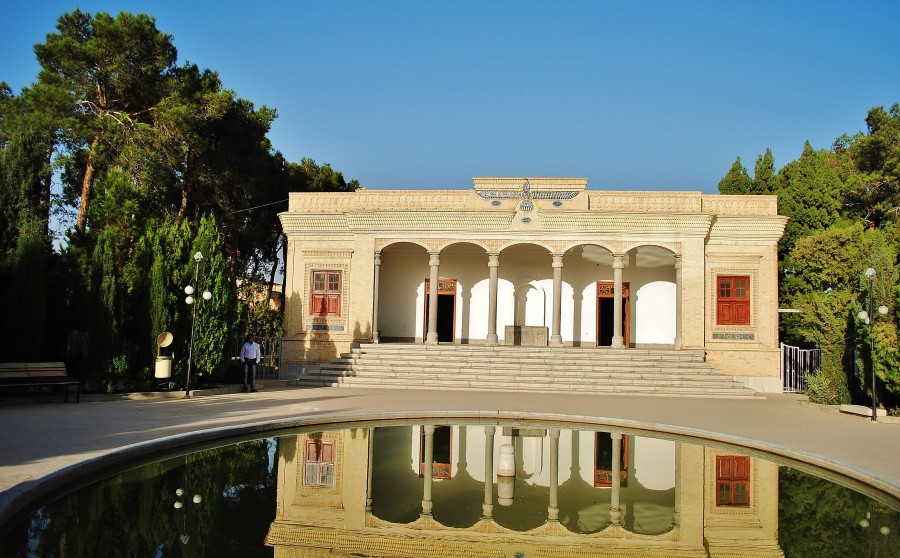
Ateshkadeh – the temple of fire of zaroastracism, the original religion of Persians. Yazd, Iran.
Then I left Amir Chaqhmaq Square and went straight up Imam Khomeini Street and turned onto Beheshti Square towards Kashani Street. Along the way I passed, among others Markar Square , which is a form of oasis in the desert Yazd. It is easy to recognize it because there is a clock tower, trees and a lot of vegetation and also the emblem of Iran. Two streets were already my goal, Ateshkadeh – the fireworks of forensic science. Before that I saw one very impressive in Azerbaijan, in the suburbs of Baku. However, Yazd is the cradle of extermination and is a place of pilgrimage to the faithful, which means that the fire of their faith is still burning.
Although as I read the temple this is often closed, I was lucky. At the central point is an oval pool, followed by a white, peach, one-storey building with white pillars, and the Fravahar symbol – an ancient symbol of zarochasti, which was later reasserted by the Pahlavi dynasty as a symbol of Iran. The eternal flame, which is said to have burned since 470 and seen through the glass, is the most important element of every Javanese temple. Besides, there is also a small green area and a bas-relief on the wall, which I have often seen in Iran. It shows a man fighting a lion with a sword in his head and another in his stomach and if not mistaken, this thread comes from the ancient Persepolis.
This temple was an interesting experience, but I also admit that many visitors were more interested in why Poles travel alone to Iran, “because I could go to America or France.” I would have told them that I had seen so many niggas in my life and so many pedals that I did not want to go there. I said, however, that I prefer history and adventure in a very interesting country whose culture and beautiful achievements are worthy of recognition, provided they stay in Iran. I also said that I have a good opinion about the Iranians because that is the truth. We shook hands and then farewell to the very interesting and atmospheric temple of Ateshkadeh.
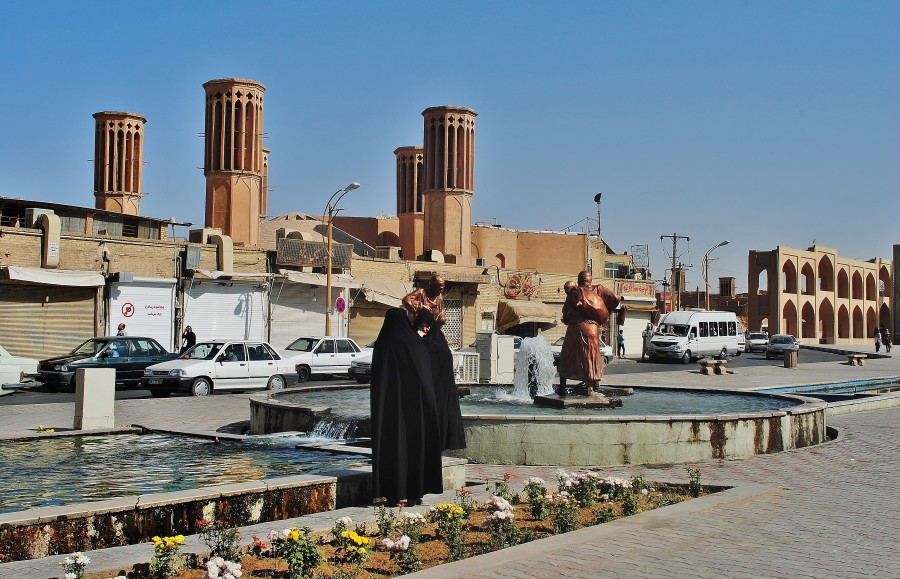
Yazd old town, and ‘wind catchers’. Iran.
Then I went back to the hotel, but I stood in the Amir Chaqhmaq square for a very good Persian meal, I was in the cafe next door and I also went to the shoe shop to tell the seller that if America considered Iran an “axis of evil” it was probably only because of the stinking people Vietnamese shoes that he sells. I was finished with these shoes. This one, however, had such audacity that he showed me Iranian shoes and said that if I buy it, he would lose 1 pound on them.
On the way to a sexual revolution in the Muslim world
Being in front of the Masjid Jameh mosque, I also met a couple from Ireland, whose goal was to cover the route from Ireland to Australia. However, I advised him to wrap his blonde well when they are going through Pakistan. I did so because in Pakistan I was also with a blonde. When I was in the hotel, I laid my hands on the fallen leaf near the water reservoir and planned the next day. I also met a Dutch girl with a nice face and shapely bum but after a short conversation I had enough of her and she had enough of me. I don’t think I passed the liberalism exam and I didn’t have a sincere smile.
On the other hand, I was fed up with sitting and went outside, but passing the Masjid Jameh mosque I heard a whistle and a loud “wait.” After a while, a young Muslim woman in black rags came up to me and started talking to me. After a while, she felt so at ease with me that she began to confide in me with her sexual fantasies. So I took her to an empty bar to drink and on the way she told me about how she dislikes Iran and Iranian men. She said that she would like to have a White lover from Europe and asked if I was in Yazd for a long time or if I was just a tourist. In such a situation, what could I say. Of course I want to stay in Yazd for the rest of my life and would be obliged if she invited me home. She replied that she would do what I wanted for me, but I would have to promise that I would stay in Iran and not even look at other women. She also said that she would have to get to know me better first, which would take some time, for which I changed my version and said that I am a tourist. However, she did not give up. She asked if I would return to Iran if I could bring her a vibrator and she would pay me for sure. I replied that she didn’t have to if I put it on her personally, which she smiled back at. I admit that she was disappointed because she felt lonely and wanted to have a normal relationship with someone who is not a Muslim.
On the way back to her car I said that I am also very religious because I am a Catholic but she started laughing in my face and saying that sex is the only religion in Europe. Of course, I tried to defend Catholic values by denying it, although due to the circumstances I did not elaborate on this topic. When we got to the mosque, where we met, her aunt was waiting for her, also in black rags, and she felt like it too. Incredible things are happening in the Islamic, I would like to emphasize, the Islamic Republic of Iran, although in Dubai Arab asses were also winking at me. Back then I didn’t know that I would have a similar adventure in Shiraz.
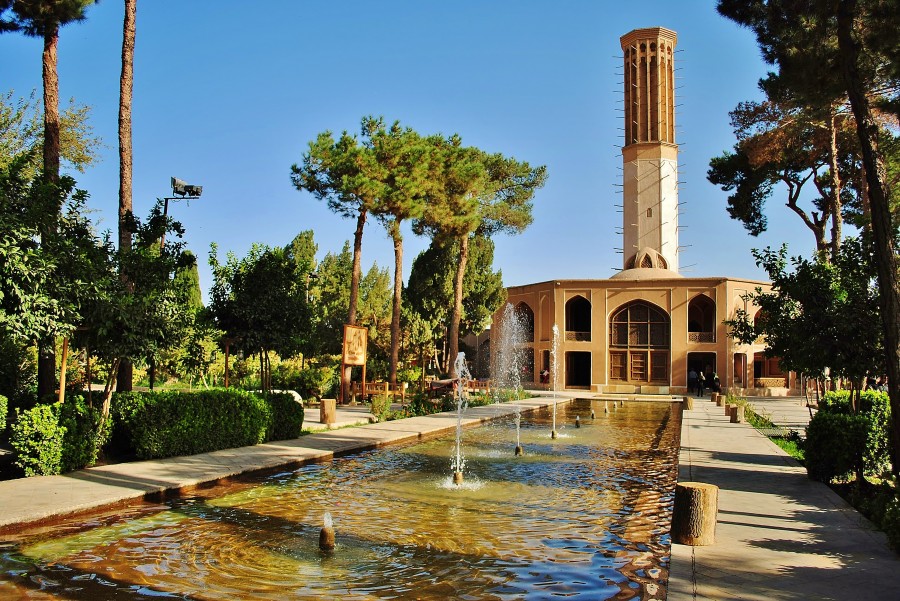
Dolat-Abad Garden with green marble fountains. A very peaceful and relaxing place in the desert city of Yazd. Iran.
Based on my experiences, I believe that the Muslim world is simply thirsty for love and desperate for a sexual revolution. I think I would start from Saudi Arabia and then through Yemen I would deal with Pakistan.
Trip from Yazd to Meybod, Chak Chak and Kharanaq
Being in Yazd I had a very interesting trip outside the city. True, the hotel organizes tours but I had three people to share a taxi for only 250,000 Rial per person for the whole day. To the company I had a couple of Spaniards who hated me because in my eyes I was an Englishman and from what I know English tourists in Spain seriously test the patience of the Spaniards. To say that I’m a Pole did not help. There was also a boy from Germany, who was the most charismatic company because at least I came across his good day and took pictures of me. Either way, everyone paid their share and that was the most important thing. The driver of the yellow Peugeot 405 drove us through the Persian desert and as each taxi driver combined to bring us somewhere not so “happy” Spaniards lined him in English but with a Polish impetus not to make jokes. So it was a lovely trip.
Meybod
First we went to Meybod , which is located 52km from Yazd. The town is one of the world’s cultural heritage, as there are pre-Muslim clay houses dating back to about 1800 years. The whole Meybod is very small and all the sights are around so the taxi driver left us in one place and gave us time to explore.
One of the monuments is Narein Castle, which dates from the times of the Sasanids. Despite its age, it is still a massive, multi-storey building that stands on the Galeen hill overlooking the city and offers views from the roof. The ruin of the castle is located on a fenced area and in the middle comes a guide. The whole is built of clay bricks, which, like Old Town Yazd, makes this object was built from the desert.
At the entrance to the city I also saw the Pigeon Tower, a low, round structure that used to be home to 4000 pigeons. This object, also in the color of the desert was renovated and in the middle it has perches on the walls. In the old days, what fell out of their tails was used as a fertilizer.
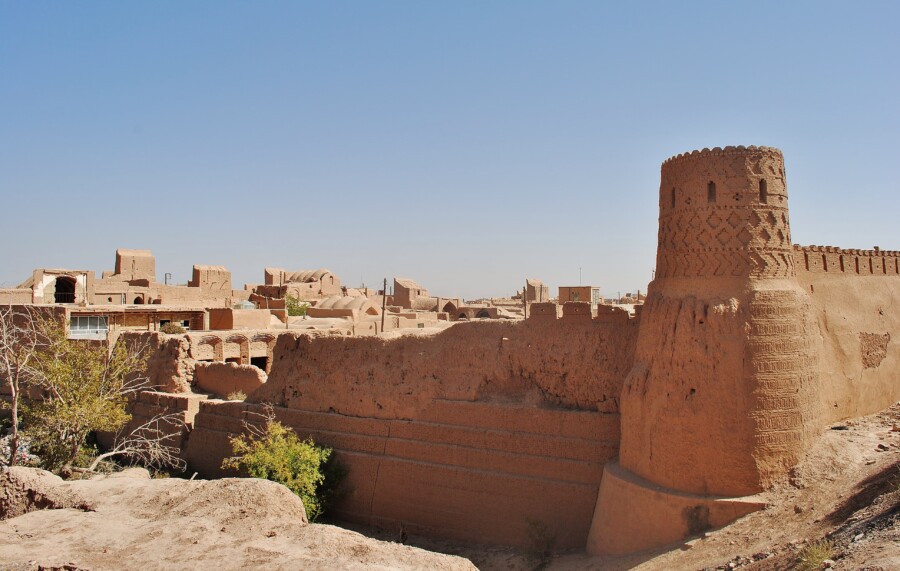
Narein Castle in Meybod, Iran.
Another interesting feature is the 300-year-old postmodern clay house, although the more appropriate description here is the inn. The building has high walls, a huge mosque-style entrance and two round towers from the front. Inside is a courtyard where the well and horse models are closed. There are also stairs leading to the observation trail running around.
I think the most enigmatic place for tourists is in Meybod Ice House, which I think was a brilliant way to deal with the desert climate before the invention of refrigerators and freezers. Some of them were underground cellars and others had a conical shape from the outside and were deep inside. During winter winters and ice were collected and put into ice houses in special insulators and remained frozen until the following winter. But in the summer when temperatures were highest, ice was used to cool drinks, make ice-cream desserts, and serve as a way to store food. In Europe and America there was also this custom, although the form was different. The icehouse in Meybod is built of clay and was created during the Safavid reign. (Another ice house that you must definitely see is in Kerman).
The last place in Meybod that I saw was a caravanserai or courtyard surrounded by walls and laboratories where people made carpets, slippers, shawls and clay pots. In the middle was a very attractive well with crystal clear water to which you could descend the stairs. There is a brick corridor and it is advisable to pay attention to the ceiling.
Chak Chak
Lying in the desert Chak Chak is a row of square, unattractive buildings set on a mountain wall. Among them there is also the Zoroastrian temple, which is the most interesting but it’s not the most beautiful place. Inside there is a rock with falling water and several flames. The architecture at Chak Chak is less attractive to the visitor than the slums in Brazil, where the houses are also stacked on top of each other. The funny thing about all this is that, according to the information on the door of the temple, “women who go through their period are asked not to go inside.”
The best of all are the views and the ride to Chak Chak through the desert and the accompanying adventure. I also enjoyed climbing the mountain, observing the empty nature and finally the view from above. Salvation here is not the temple, but the toilets, which are located somewhere in the middle. Located 72 km from Yazd Chak Chak is on the list of every trip and although the adventure is worth coming, I think that the buildings themselves should be demolished and better built.
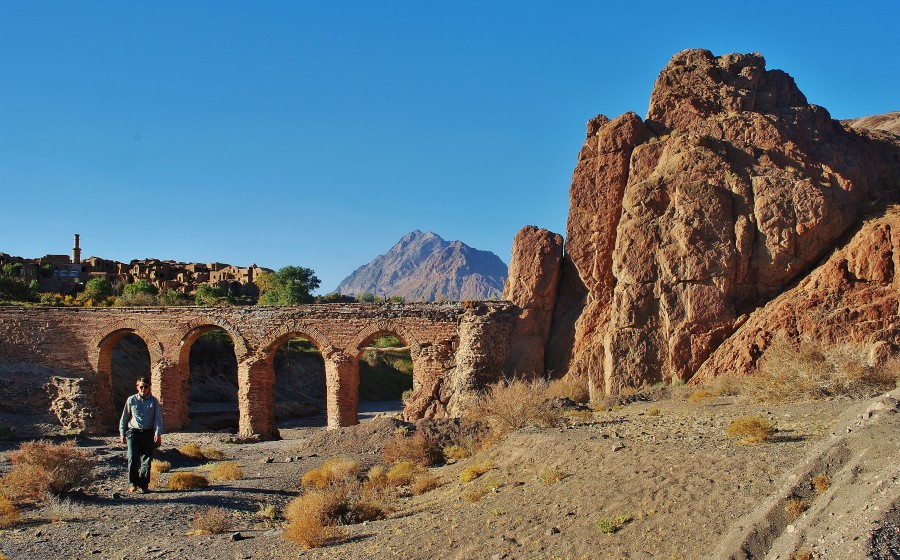
A stone bridge in the desert, Kharanaq, Iran.
Kharanaq
About 70km from Yazd lies a village made of clay and surrounded by fields, which has been inhabited for about 1000 years, although the ruins of the clay sludge are about 4000 years old.
Kharanaq is a beautiful, adventurous journey back thousands of years, though it is a pity that only the Iranian government can not spend money on mosques and to restore ancient ruins. The main attraction here is a clay town from thousands of years where you can still see the rooms, the streets, arched walls or minarets, but definitely need to renovate.
I was walking through the streets and the roofs where I had a good view of the whole and fortunately I did not fall. Most importantly, the ruins are not so tragic that you can not see the shape of the clay village and I recommend the view from the field behind the center of Kharanaq. Next to it is another courtyard, but here is also the most interesting was the roof because it had bulges on the model of traditional baths. Then I walked across the fields along the irrigation canals and the trees with the fruits of the grenades until I reached the stone bridge that was a beautiful part of my adventure, even though the best times were behind me. Behind the bridge and the small hill there is a low mosque built during the Qajar period and I think that there is maintenance work here.
Return to Yazd
(stay 2 and departure)
After returning from the tour I went only to a beautiful garden called Bagh-e Dolat Abad . In addition to greenery, this garden also includes a water canal running along the park, a small pavilion and a restaurant.Inside the pavilion are stained glass windows forming an arch shaped window and a ceiling cut into sophisticated geometric figures. In this garden is also the tallest badgir (air tower) in Iran with a height of 33m. The tower reflecting in the water is surrounded by greenery, giving a sense of calm, while the interior of the pavilion is a real work of art. Its splendid symmetrical designs on walls and ceilings and elaborate stained glass should also be found in a museum in Warsaw. There is also a small pool in the middle. On the outside they also stand where I lie and drink tea in the green. The garden was built around 1750 and was the home of state official Karima Khan Zanda.
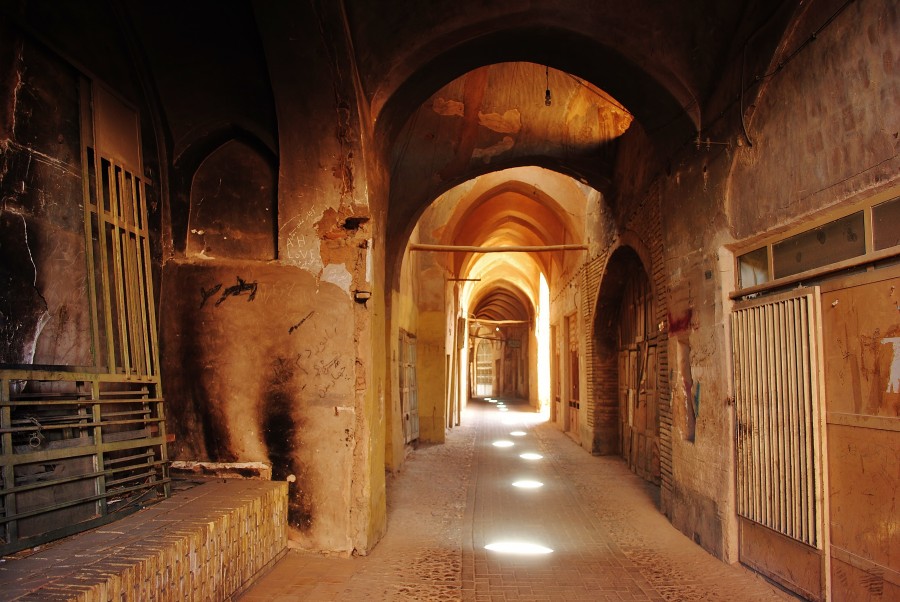
One of the many atmospheric tunnels in the desert city of Yazd. Iran is a very interesting experience.
On that day I was still having dinner at the shish-kebabs at Amir Chaqhmaq and during the meal I was very conservative young Iranians (black sheets) and asked me a whole series of questions about Europe and my opinions about Iran. They were interesting world and interesting what I have to say. I just asked whether they would not like to have a free life, that is, without prohibitions flowing from Muslim culture. The girls replied that they understand what I mean, but if they live in this culture from birth is not bad. There was a whole bunch of people and everybody watched us and I treated this meeting as an interview.
Shortly afterwards I took my backpack from the hotel, stopped the paid hitch in the street and got to the bus station. Then I did not know that I would be back here soon.
It is also a pity that I missed the Tower of Silence and the Yazd Water Museum . Maybe next time.
Transport from Yazd to Shiraz
Bus for 115,000 Rial and also included a snack. The ride lasted from 10 pm to 5 am. I was tired of traveling.
Shiraz
Shiraz is one of the main destinations of all travelers. As a city of 2,000 years of history, the city of many sights, beautiful gardens, ancient poets and Shiraz wine production is also deeply ingrained in Persian culture. Besides, Shiraz was the capital of Persia during the Zand dynasty (1747-79) when many beautiful buildings were built and renovated. Also because of the many facilities important for Islam, Shiraz is the destination of many pilgrimages, although I recommend more antique palaces and secular Persian gardens. To all of this Shiraz is also a base for the timeless Persepolis, once the capital of the Persian Empire (God bless Greece).
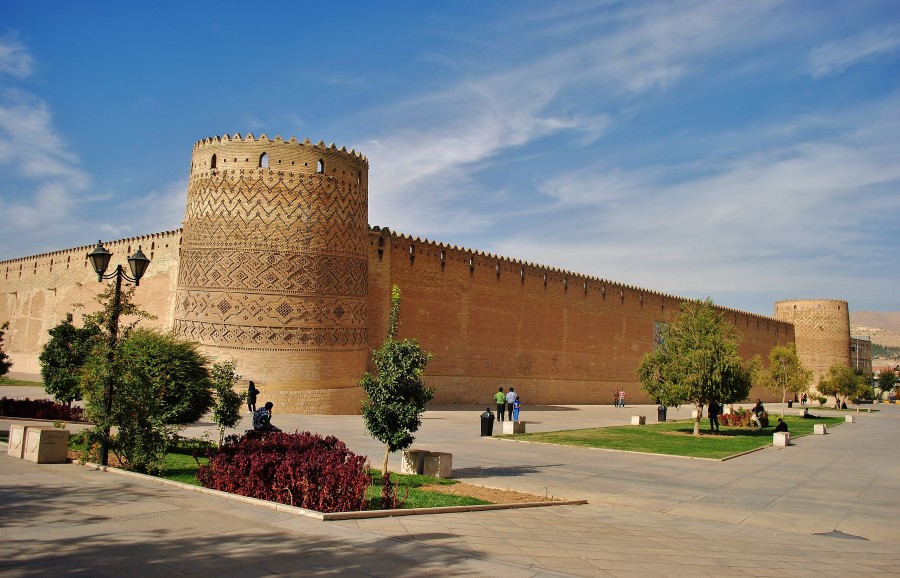
The object that dominates the Old Town of Shiraz is Arg-e Karim Khan, commonly known as the Ark.
When I arrived at the train station in Shiraz the taxi driver found me very quickly but fortunately took me hitchhiking from the street. It was 5:30 in the morning because the hotels were closed and the night walking around Shiraz could be risky. All the hotels were closed so I took advantage of the fact that it was open one sandwich bar and there I spent some time with the tea. Then I was able to wait in one of the hotel’s waiting rooms as I woke up the porter. I mean, of course, the lowest class hotels. In the morning I went to the Hotel Darya near Arg-e Karim Khan where for the basic room with shower I paid only 150.000 Rial. I slept a little and about noon I went out into town.
The object that dominates the Old Town of Shiraz is Arg-e Karim Khan, commonly known as the Ark. This ark is a citadel built during the time of the Zand dynasty, which once served as a prison, then as the governor’s seat and today it is in the hands of the Cultural Organization of Iran and there is an attractive garden. The citadel covers an area of 4000m² and is located in a square which is partially covered with greenery. The Kharim Khan Citadel is fenced by 12m high walls and features 4 brick, bas-reliefed towers of which each has a volume of 14m. The south-east tower is distinctive as it is tilted inward due to the channel beneath it. Ark was once a defensive target and hence its massive construction. The walls are 3m wide at the bottom and 2.8m high. In the middle is a courtyard with a water body and citrus trees. There are also pictures from the turn of the 19th and 20th centuries and the Zand Museum. I liked the nature in the middle of it, and the fact that I could touch the trees and lemons. The design itself is obviously impressive.
Nearby is Bagh-e Nazar and Pars Museum . It is a richly decorated pavilion surrounded by a garden where Karim Khan accepted guests. Unfortunately I was not allowed to take pictures in the middle but the ceilings were works of art. These were decorated and painted, symmetrically cut stalactites. Besides, there were paintings and a saber and Karim Khan’s grave. The garden itself was not as pretty as the one in the Arce but there were interesting sculptures there.
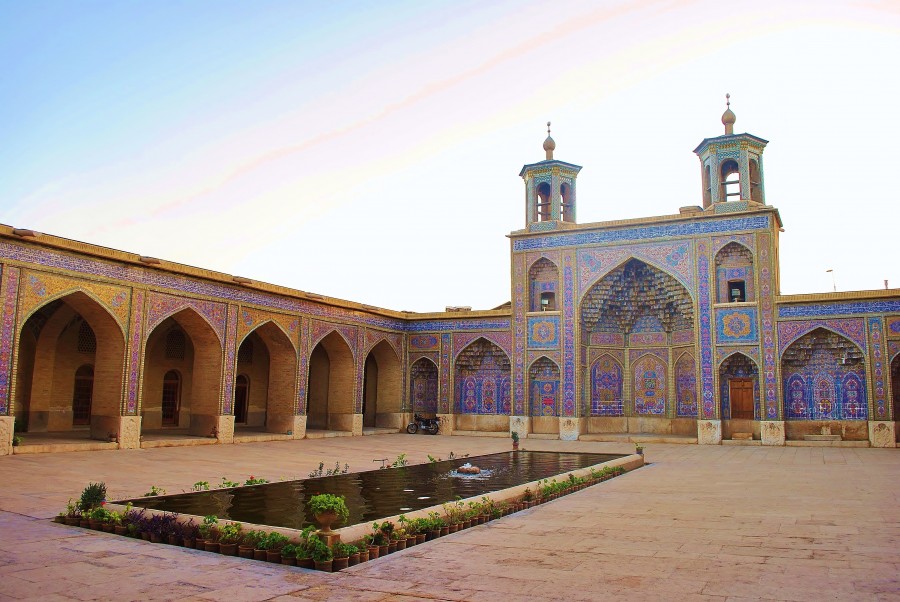
Masjed-e Vakil Mosque. Shiraz, Iran.
Then I went to Bazar-e Vakil . At first I want to say that in Shiraz there are several bazaars where everyone comes from another period. In my opinion, Vakil bazaar best reflects the atmosphere of ancient Persia and is located right next to other interesting objects. Karim Khan’s plan was to transform the Shiraz into a large commercial center, so the traditional bazaar was needed. Many of the attractive avenues and shops are home to decorated caskets, sculptures, figurines and Persian carpets with many sophisticated designs.One of many was, for example, the Last Supper, which I have seen many times before in Iran. Women can also find clothes and sophisticated spices to later cook their husbands. I came to this bazaar many times to enjoy the atmosphere and watch the souvenirs. The whole square in front of the bazaar is also very attractive and is especially pleasant in the late evening.
In the same place there is also the mosque of Masjed-e Vakil , whose construction was started on the order of Karim Khan. This mosque has two mosaics of gates ( iwan ) and an alcove courtyard with arched top. The property itself was attractive but given that a few days ago I was in Esfahan nothing could surprise me. For that reason, I had a lot of fun with the traditional steam bath that was next door. I am talking about Hammam-e Vakil , which is not a simple bath but a work of architectural art. There once housed a restaurant and a carpenter’s museum, but today there are men’s wax figures while scraping their backs, sitting in the warmth of steam, and other meals in ancient costumes. The attention should be paid to the water reservoirs in the center of each room and the pillars, which are becoming more and more massive and have drawn bows and bas-reliefs. Because of the architecture and interesting exhibitions in this bath I spent a lot more time than I planned, although I admit that I would prefer that the wax figures depict beautiful nude women and not once again the men who act on me just like a bench in the park.
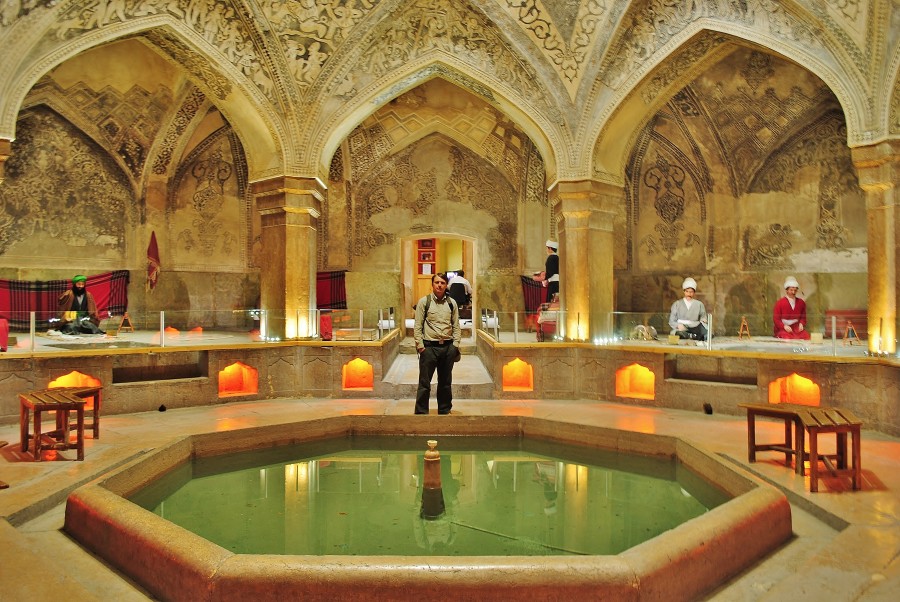
Hammam-e Vakil bathhouse in Shiraz, which is not only a bathhouse, but above all a work of Persian art. Iran.
That day my visit was over. Instead, I took a walk on the part of the non-tourist, which is where Persian life takes place. At dusk on the street sellers spread their goods on the sidewalk on large ceratas and there was something to choose from. This is what I like. Instead of a smelly monument of globalization in the form of supermarkets, people can go out and sell their stuff. I bought a shampoo and then went to shih kebabs where I walked after many times. This restaurant was run by a woman from Azerbaijan where I was recently, we also talked in Russian. On the main street near the illuminated citadel I have come many times as there are many interesting places. From the crossing above the street you can see the surroundings and downstairs there are bureaux, a shop with handmade hats and one of the side streets of a cheap restaurant with traditional Persian food. The rest is all cheap. My first day in Shiraz passed the pleasure of art and culinary delicacies.
The first day I went to the main street for a small snack and then back to the square in front of the Ark of the Shiraz. Then I headed to another part of Shiraz but it took me some time because I was looking at the old and tired of its existential architecture. Walking through the streets of Shiraz I got to 3 mosques in turn and although they were built with great vigor, like most mosques in Iran, after a month in this country mosques began to bore me. First I reached the mosque martyrs (Masjed-e Shohada) , which was built in the 13th century on 11.000m². Today there are not many decorations, but you can see another great dome. This mosque was not so spectacular.
On the other side of Ahmadi Square there is another huge object and it was Aramgah-e Shah-e Cheragh , another huge Muslim object. It is a mausoleum completed in the days of the Qajar dynasty, which was created on the grave of his imminent brother Imam Reza – and had brothers up to 17. Inside there is a huge courtyard where rugs are laid and where rests are crowded and a large area for walkers. The courtyard, of course, abounds in the standard of Persian architecture, once again, with arches, mosaics, huge blue domes and high minarets dripping with gold. But more interesting was the interior of the sarcophagus and the walls and ceilings decorated with glass and green mosaics. There were also verses from the Koran on the walls and the whole gave the ubiquitous effect of shimmering lenses. I admit that I was full of respect for the craftsmen who made the interiors of the mausoleum and not only because of their perfectionism but also their angelic patience.

Naranjestan-e Ghavam is a lovely park in Shiraz, Iran. The gardens include a fountain, date palms and lemon trees. The historical object is decorated with paintings, mirrors and Persian art made by Persian masters of patience.
I also saw that for the Iranians this place was really sacred and they were sincere in the Muslim rites, and the person who died in 835 still had spiritual significance for them. According to general principles, non-Muslims can not enter the chapel area, but these rules are kept secret because I have entered. I suppose I could bring a woman with me if I wrapped her in a black sheet. In one of the corners of the square there is another chapel with a dome, wooden pillars and a refined mirror. It is named Bogh’e-ye Sayyed Mir Mohammad . But this is another big object with two minarets ending in gold.
I sometimes wonder whether the Persian government will stop building mosques and mausoleums. I wonder how much they need to be happy and whether they will build something for some other reason than someone’s death.
The next mosque I had was Masjed-e Jameh-ye Atigh , especially since he was at the back of the previous mosque. Well, the mosque behind the mosque. However, it is the oldest in Shiraz since it was built in 894 and the most remarkable is the stone structure with four towers called Khodahkaneh . It was built around the 14th century to store the most valuable books of the Koran. Definitely for this one design is worth coming here. Then I went down the side street to the shortcut to Madresah-ye Khan but this Muslim school was closed so I saw only a stone gate decorated with mosaics. The main entrance is in a small, dirty alley where bazaars usually throw their trash. There is a good syrup and there is a graphite on the wall.
That day I was tired of mosques but I wanted to see one more because it was nearby. It was a small mosque called Nasir-Ol-Molk . It was built at the end of the 19th century and has a small courtyard, a gate ( iwan ) and a typical blue mosaic. However, you should come here to see the prayer room. In the center are carpets, arches, pillars and carved ceilings, although the most beautiful are the windows themselves. Of course they have the shape of huge arches, but their specificity lies in small pieces of colored glasses, which, especially at sunrise, illuminate the attractive interior. This is precisely through his art that he refers to ancient Persia, and in spite of his small size I rank him as the best.
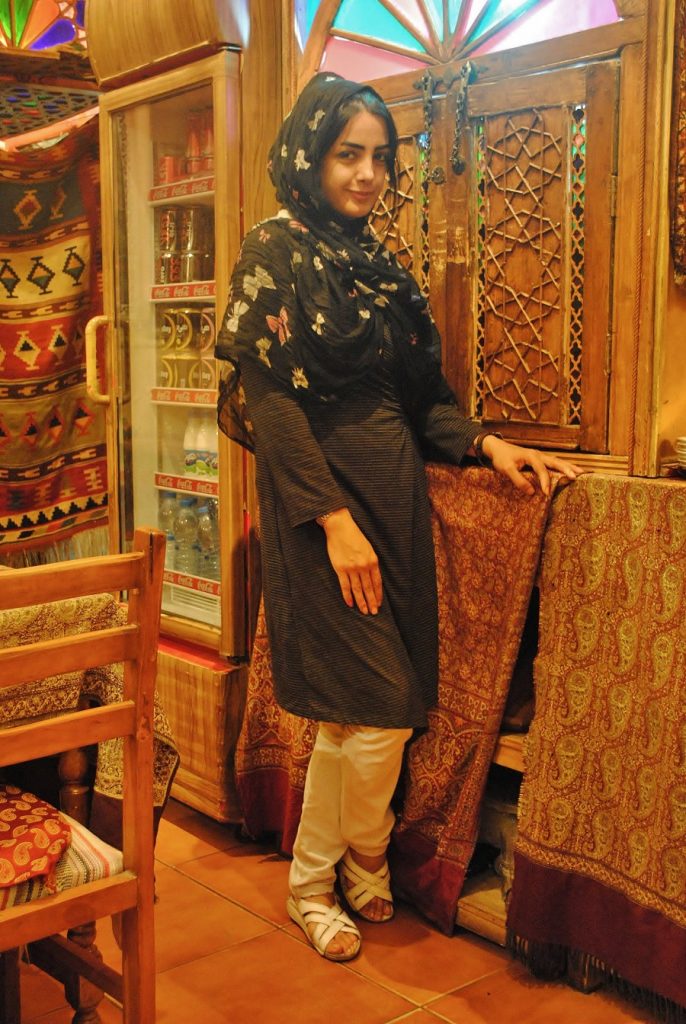
A nice Persian girl who I spent an evening with.
Then I went to an attractive garden where there is also a small palace and museum. It is Bagh-e Naranjestan , which in addition to nice plants and open air turned out to me also a nice surprise. The garden is surrounded by a narrow pool surrounded by plants, including tall trees and a very tall alley. With the end of the garden begins a small square on which is a rectangular area of water and then in the center stands the pavilion Naranjestan-e Ghavam built between 1879-1886. The lower parts of the object have reliefs depicting men, animals and symmetrical patterns carved in the walls by Persian masters of patience. In the center of the building there are pillars and an open room with mirrors and windows with one million designs. On both sides there are sets of large windows of many shapes and mosaic patterns on the walls. The first floor is decorated with paintings and beams, even European motifs, including churches in the mountains. At the bottom is a small museum where there are, among other things, coins from the times of Alexander the Great. I know that because it showed me a nice girl, Leila.
It was about five o’clock, so I went to another garden with a pavilion around the corner, Khan-e Zinat ol-Molk and then I waited in the street for Leila. She was nice, she wanted to talk and she was clearly looking for contact with someone outside her cultural circle to talk to. I was also the only ones that I had with the cashiers to enter the facilities and the concierge at the hotel. We both felt good about ourselves and she was nice and nice. She took me to Bazar-e Nou , which is a good place to buy souvenirs, and by the way, there is an isolated cafe where we could talk about how she had enough Iran and that she needed a change in her life. She told me that she spent her whole life in Shiraz and some personal matters. I took her so she did not cry and then hugged me tighter so she did not fall and so we spent some time talking to the kettle of tea. I also made some photos of her, which I sent her to Shiraz. She was in good spirits. We also went to an evening bazaar near the Ark, on skewers in a pub where they already knew me and generally it was a very nice evening out party. She also wanted me to stay in Shiraz and take a temporary marriage with her for the introduction of a separate play for two. Exactly honest relationships with people are very important to me because only their knowledge guarantees true understanding of the country. After this meeting and several other experiences in the Muslim world, it is clear to me that Islam is not a religion of happiness, not a religion of freedom, and certainly not a religion of peace. Many young people are banned and extremely critical of society. The streets of Shiraz were still alive after trade was taking place here late.
My next day in Shiraz passed quietly. I did not rush to visit as much. I got up late, went to breakfast and then to Vakil bazaar. Then I took a taxi and drove to the Shiraz suburbs to see the Darvazeh-e Quran .Otherwise, the Gate of the Koran is a huge gate symbolizing the entrance to Shiraz, which was built in 1949.This gate is of course built according to the Islamic architecture guidelines, ie with arches and blue mosaics and paintings in some parts of it. Besides, the Qur’an Gate is inside the canyon and willing to climb up the mountain from any side to better view of the gate and city. If anyone wants to see the Shiraz from high perspective, I advise you to climb Mt Baba Kuni where you can also drink tea. But I just came to some point to make better pictures. It is also worth mentioning that the canyon in which the gate is located is called Allah Akbar, as it is customary for people upstairs to look at the Shiraz and glorify Allah. But if anyone wants to praise Jesus or greet the Vatican, then there is no problem.
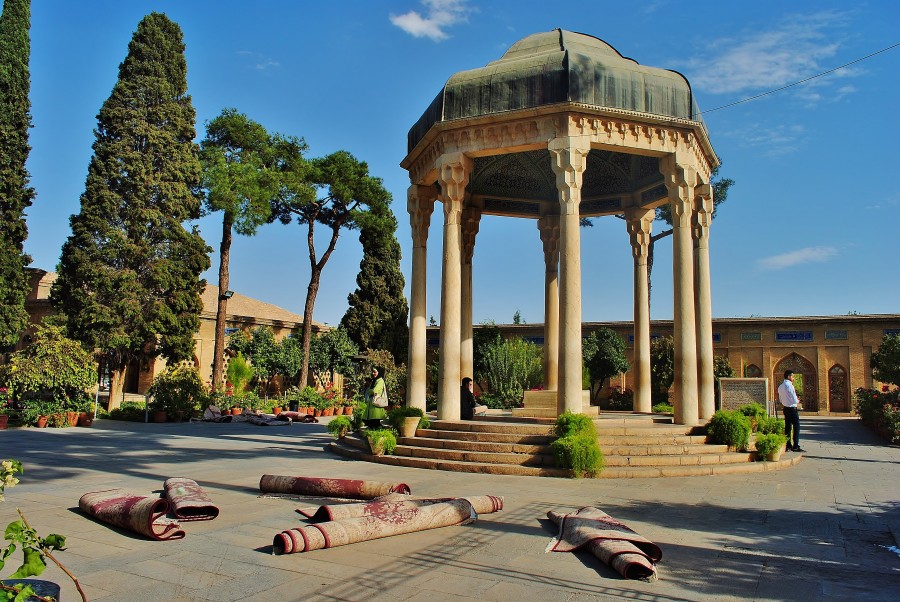
Aramgah-e Hafez in Shiraz. Iran.
About a kilometer from the Qur’an Gate is the Shiraz symbol. It is a chapel Aramgah-e Hafez built in honor of the Persian poet and folk hero, embedded in a moody garden. The Hafez’s grave is located beneath a stylish dome embedded on eight pillars and forms the center of the garden. It is decorated with verses from his poems, is illuminated after dark and unfolded here when reading the poetry of the Hafez. In the garden itself, which unfortunately is roughly lined with sidewalks there are still many plants, including pots arranged in rows. Although the garden is located in the city and is relatively small you can relax here from the traffic. Aramgah-e Hafez is also a very romantic place for young couples who are hugging themselves on the benches behind the trees and exchanging kisses and tenderness.
On the way back I stopped in one mosque before the bridge and then had a quiet evening in Shiraz. I went back to the historic bazaar and sat down on the square overlooking the Ark. I also bought a hat on the main street as I was heading south to the Gulf and had to protect myself from the sun.
On the last day I went to Persepolis and then back to Shiraz and from there I went by bus south.
Trip from Shiraz to: Persepolis, Naqsh-e Rostam and Naqsh-e Rajab
Persepolis is located 70km north-east of Shiraz and is an interesting half-day city tour. The shared taxi from Shiraz to Persepolis and the other two places cost about one million Rial but I paid 80,000 because I was alone. The driver first drove me to Persepolis, then to Naqsh-e Rajab, and then to the dead city of Naqsh-e Rostam, an ancient Nekropolis. My arrival to Persepolis was curious enough that it was not a city of ruins where a taxi approached the gate itself. The tourist must go their own way and reach the ruins ascending in the desert on an uphill hill. Going to the city before me, I only saw Persepolis and on both sides the wastes. I think it is so much better because you can feel better at the desert atm.
I would like to get to Persepolis by connecting local buses, hitchhiking and patience and then pitching a tent somewhere near. I also recall that walking in the Persian Persopolis from Persepolis to other objects is a suicide.
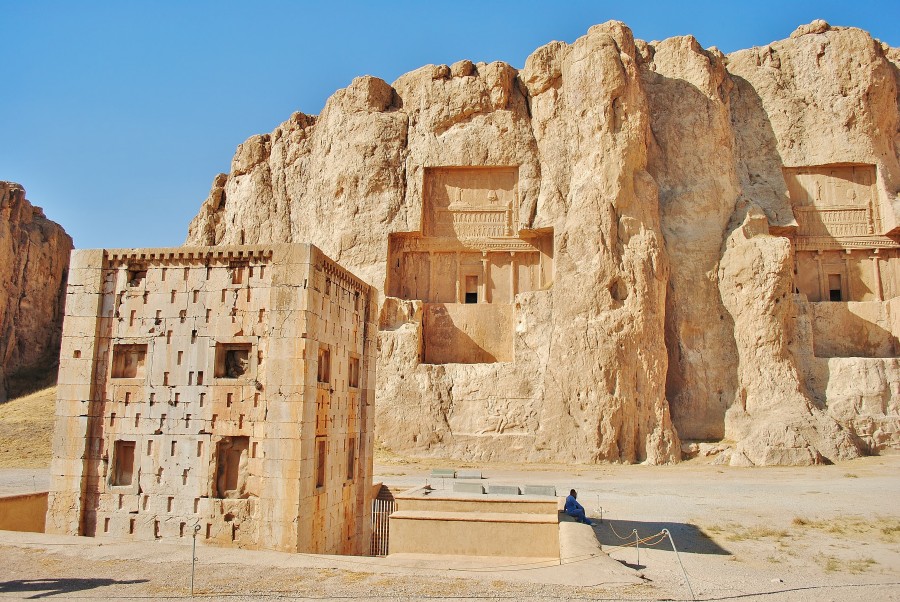
Naqsh-e Rostam is a historical and archaeological site, located 12 km from the ancient Persepolis in Iran. Naqsh-e Rostam is also an art-rich necropolis of the Persian Empire.
Persepolis
Persepolis was the capital of the Persian Empire, which in its greatest splendor extends from Greece to India. It was built by Darius I and his son Xerxes around 500 BC and this ancient city was once a majestic house for kings of kings for about 200 years. In those days Persia was so powerful and at the same time delicious and ignorant that in her maniacal glory none of the kings had even raised the fortifications around the city because in their opinion it was an unbeatable city and their empire was eternal. Everything, however, has its beginning and end. Persia, however, made a mistake burning the Acropolis in Greece because shortly after, in 333 BC Alexander the Great robbed, destroyed and set fire to the great, “eternal” city of Persepolis. But remember that Alexander did not rob the innocent, because in those days, the Persian Empire was the greatest enemy of Europe. According to historical data, the Persian Empire has plundered so much that only Persepolis Alexander needed 20,000 mules and 5,000 camels to carry all the valuables. Since then, Persian domination has been replaced by Greek and Persepolis has already left a ruin.
2500 years ago, the great queens of kings passed with gifts for the “king of kings”; today the ruins of Persepolis are a popular tourist destination among tourists from Europe and Iran. We Europeans look at Persepolis with delight and try to imagine the grandeur and grandeur of the Persian capital for historical reasons, but the Iranians are also coming here to remember the times when their country was the most powerful in the world.
The ruins of Persepolis consist of many huge objects built of dark gray marble. Most of them are standing on a huge square, giving a sense of emptiness after fierce battles, although there are also other ruins built into the rocks a little further away. Prior to the invasion of Alexandra there were pillars ending with a palace roof, but today there have been only a few, and many beautiful reliefs and monuments. Some of the facilities have never been completed and some of the palaces and auditoriums have only stone pillars and massive rectangular passages. Noteworthy are the well-preserved reliefs of Persian soldiers and the relief of a lion biting the back of the body. There are also reliefs depicting the searing immortal Persian immortals and the orphaned mythical lion with the head of an eagle.
As I walked up the stairs to the city level Persepolis appeared before me the Gate of All Nations , decorated with great sculptures of bulls with heads of bearded men. This great and impressive gate was built on the order of King Xerxes, and its name should be translated as a symbol of power over “all nations”, all the more so because at the summit of the empire the rulers of other nations were passing through this gate, accompanied by trumpeters. then Xerxes.
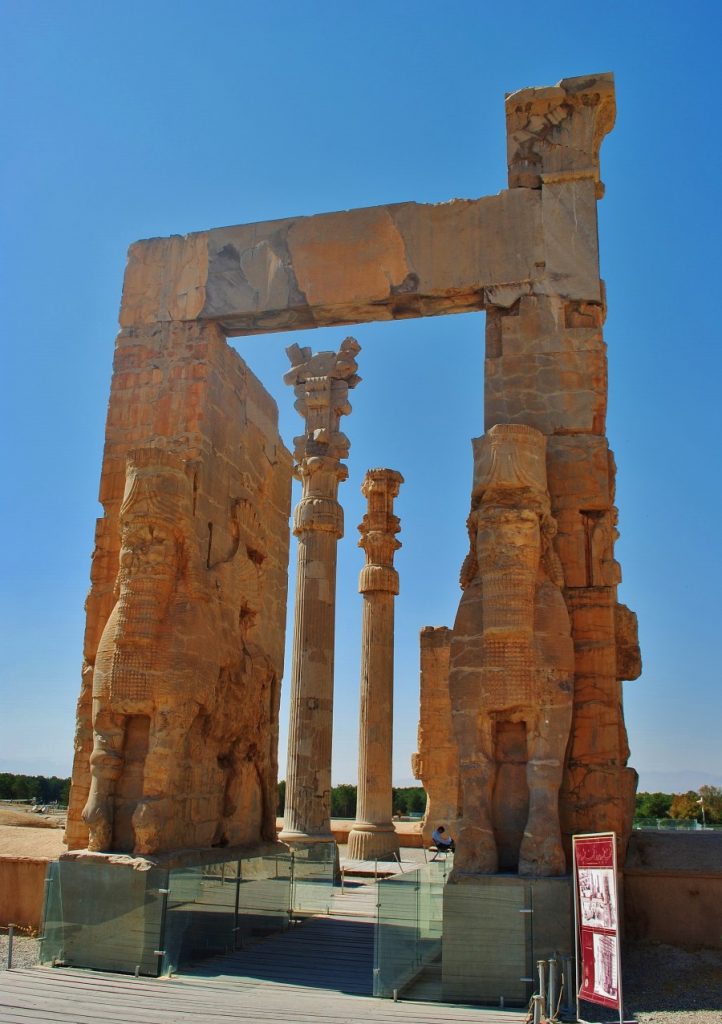
Entrance of the former capital of the Persian Empire – Persepolis. Please note the two lions with men’s faces and beards, which are characteristic of the Persian civilization. The Gate of All Nations was built by order of King Xerxes of Persia to show Persia’s domination over all nations.
An important remnant of Persepolis is the Palace of Apadana , where the king of kings received the initials.The construction of Apadana began in 515 BC and lasted for 30 years, because the incredible resources of human resources and resources were needed to complete. In the center of the palace was a large square hall, each side 60 meters away. The roof above the hall was supported by 72 columns each of which was 19m high and was completed with monuments of lions, bulls and eagles. Besides, there were other chambers, as well as many gold ornaments, which provided for Alexander’s loot. At the king’s command, bas-reliefs of the elite soldiers of the king of kings-immortal ones. Today, from the great glory, there is not much left, but today there are only 13 columns, and the bases of the columns and stone parts of the palace are all around.
There is also the Throne Hall , also known as the Hall of Imperial Army, begun by Xerxes and completed by his son Artexerxes I. In times of glory, the roof of this palace supported 100 columns and the entrances were decorated with monuments of great bulls. Today, watching some broken columns, you need to run your imagination to see the greatness of this object.
Another object, though smaller, is the Tachara Palace built under the rule of Dariusz I. Despite the fact that the roof is long gone, the palace is very photogenic because it has many impressive columns and soldiers’ crypts at the base of the object.
At the very end of my walk to Persepolis I went up the hill to have a good view of the whole area. I think it is a good complement to the tour to realize its size. The Persepolis was built on 125,000m², partly on flat ground and partially cut from the rocks, after which the cracks were filled with earth and rocks. On elevation, there are two tombs in the “Mount of Lourdes”, which were completely carved into the rocks. The former Persian Empire rulers are here: Artaxexes II and Artaxerxes III.
Naqsh-e Rajab
About 6km from Persepolis there are spectacular sculptures in the rocks of the early Sasanid times. These sculptures depict the kings of the Sasanids with their army and the highest priests and their sons. Each of the critters has a size of about 5 in 3m and even without knowledge of history they are very impressive and worth seeing. Besides, Naqsh-e Rajab is in the rocks and finding it is part of the adventure.
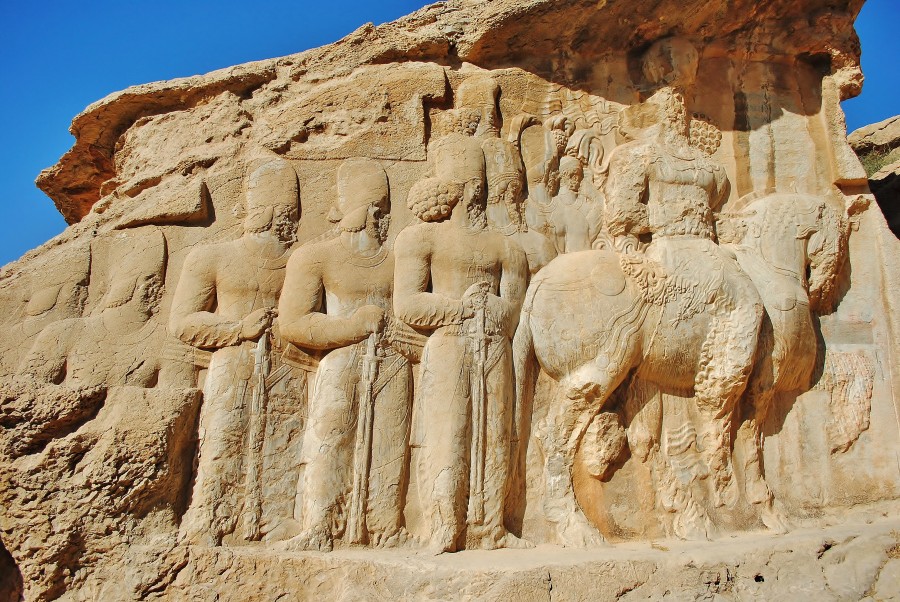
Naqsh-e Rajab; the remains of ancient Persia. Iran.
Naqsh-e Rostam
Naqsh-e Rostam is an ancient Nekropolis that lies about 7km from Persepolis and is the resting place of the ancient kings of the Persian Empire. In addition to the tombs cut in the rocks at a height of several meters, there are also interesting reliefs, the oldest of which was completed in 1000 BC.
In Naqsh-e Rostam there are 4 tombs carved in the shape of crosses. In the center of the cross are carved chambers where the sarcophagi of kings. According to historians, these were the tombs of Darius the Great, Xerxes I, Artaxerxes I, and Darius II. There is also the fifth tomb, which most probably belonged to Darius III, the last ruler of the Achamenid dynasty. On the other hand, when Alexander the Great conquered and emptied Persepolis to the clean it was very likely that his attention was not also Naqsh-e Rostam. Most likely, we will never know what else the Persian king’s tombs have covered, but we know that the tombs above Persepolis were patterned above those of Nekropolis.
All the reliefs carved in the rocks represent Persian rulers on horses in supernatural proportions. Most often they are shown during contact with the Romans in situations when the Persian rulers towered over them.One of the well-preserved and famous reliefs of the Sasanid period is, for example, “Triumph Shapura I” (about 250 years), which shows King Shapura on horseback and his Roman Emperor Valerian and Filip Arab’s subjects kneeling. Similar motifs depict all other larvae. Persian kings accept honors, fight enemies or enemies are worried under the hooves of their horses.
In my opinion, there is only one relief, the one that would show Alexander the Great with the heads of Persian rulers in his hand and the inscription underneath: “Do not mess with Europe.”
In Naqsh-e Rostam there is also a small rectangular tower called Kaba Zartosh with a small room in the center, inscriptions and stones arranged in the pattern of false windows. It was once thought that perhaps it was a temple of fire in honor of the dead rulers, but then the scientists left the opinion because of the lack of good ventilation. So perhaps it was an ancient calendar or even a small treasury. This tower dates from the 5th century BC You can not go inside.
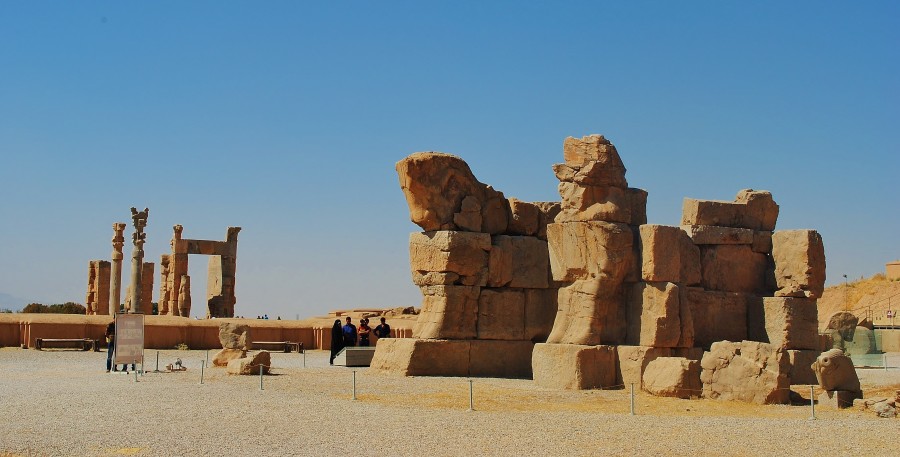
Persepolis- the ruins of the ancient capital of the Persian Empire. Travel Iran.
Naqsh-e Rostam is an original experience that the average tourist does not expect to be entering. When I came here I saw only the top with engraved graves and only after some time realized the cultural richness of this place. Persepolis Naqsh-e Rostam has an interesting, demanding concentration of crustaceans, each with its own story about one of the greatest empires of our world. Naqsh-e Rostam is a lonely mountain in the wilderness that has a history of fighting, great rulers, huge armies and endless rivalry for power. It is the city of the dead kings etched in the rocks, proof that they were blood and bones on which the mountains were nudged.
Road from Shiraz to Bandar Abbas
Night bus for 130,000 Rial. The ride lasted 10 hours and this time I slept so hard that the taxi driver came to the bus to wake me up.
Bandar Abbas
(Stay 1)
Briefly about the Iranian smuggling capital
Bandar Abbas is a smuggling hole over the Persian Gulf, which is less inspirational to tourists than laughter worthy of “peace religion.” Due to its location, due to the fact that through the Strait of Hormoz flows every barrel of oil, colloquially called Bandar is a unique place. Besides the Bandar Abbas oil is the capital of smuggling and illegal trade, starting with Persian carpets, through guns, drugs, cars, cosmetics, flat TVs, motorcycles, sunglasses, drinks and much more. The police are also pawn blind and deaf and the business is turning day and night. For this reason, Bandar Abbas has gathered a suspicious crowd around the world and of course “no one has anything to do with it.” Apart from the Persians there are also Arabs, Bandaros, eternally hungry Indians and Negroes from Africa.
In the eighteenth century, the British, the French, the Dutch, and earlier also the Portuguese, were also dirty and clean-looking in their white paws. For centuries this strategic and very “hot” place has become one of the major ports of Iran, a base for the Iranian navy and a source of maintenance for nearly 90,000 families and a suspected element. The deal is getting tougher on American sanctions against Iran, but experts have calculated that every year, Bandar Abbas enters the $ 5 billion worth of Iranian goods, with every billion Iranian jobs going to Iran. This situation is so widespread that according to the Iranian immigration office 80% of all mobile phones in Iran come from smuggling.
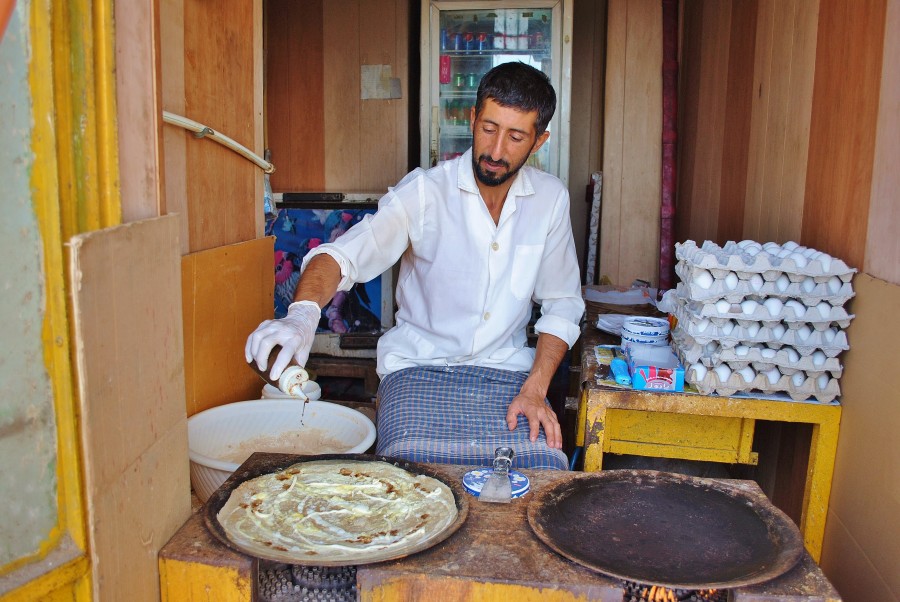
Pancake seller in Bandar Abbas. Persian Gulf port in Iran.
My impressions of Bandar Abbas
When I arrived at Bandar Abbas in the morning the driver was unable to wake me up because that helped the taxi driver who escorted me from the bus and then loaded my nasty backpack into the cab trunk.When I started to wake up, I saw that I was on the Persian Gulf and someone else shouted probably to me: “Bandar Abbas”. On one side I had a sea shore and on the other the dingy and dry buildings. Although it was almost November it was still hot so I got into a taxi and for 40,000 Rial the driver drove me to the port.Bandar Abbas was still sleepy because in such a hot climate life begins only after dark.
Before I went to the port I looked at the less impressive upper buildings and went to the traditional area. I ordered a dry pancake with chocolate and then walked through the empty street of rubbish and poor people who just got up, and I got to the tobacco smoking room where I was given tea. In the pub I just came to myself and really do not know what knocked me out so much. Maybe it was a climate because Shiraz was mild compared to Bandar Abbas and fortunately I did not find myself here in the summer when temperatures are unbearable and reach up to 50ºC. Men in the pub have long since not seen the White because they obviously asked questions about my origin … but that is always the case. Soon I went to the port where I once again saw the higher buildings of Bandar Abbas and the empty shore.
Bandar Abbas was not my destination but an interesting changeover to the islands in the Persian Gulf.
Transport from Bandar Abbas to Qeshm Island
I bought a ticket for 70,000 Rial one way on a nice boat, after a 2h cruise I reached Qeshm Island. On the way I passed big tankers and cargo ships. It was still hot, but the wind and sea breeze brought relief.
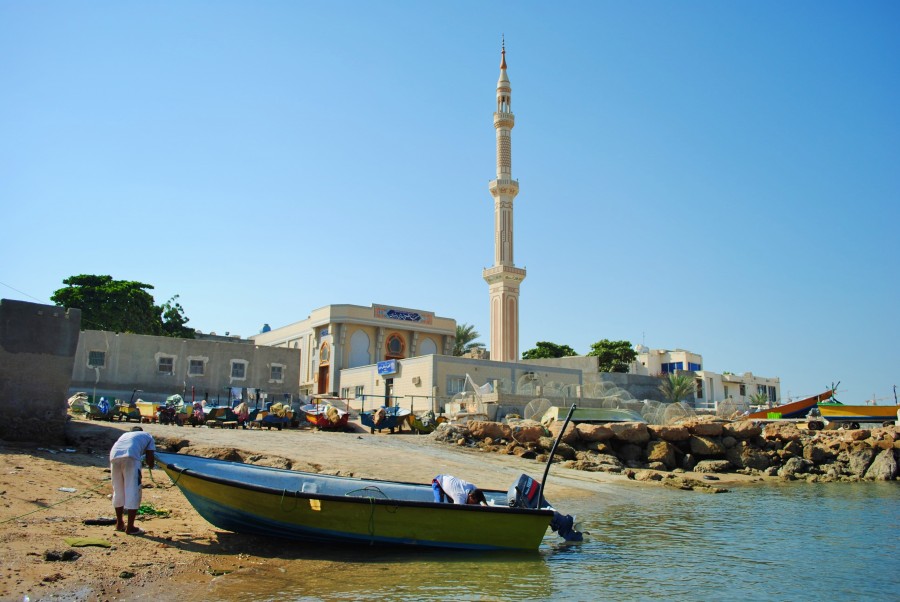
A mosque and a small port on Qeshm Island. Persian Gulf, Iran.
Qeshm Island
( That is my great adventure in the Persian Gulf)
Qeshm is the largest island in the Persian Gulf. It covers an area of 1335 km², including nice beaches, mangrove forest, canyons and caves and predominantly desert climate. Despite the fact that Qeshm is growing quite rapidly, this island still gives a very real look to the life of Bandar and their traditional fishing villages. Qeshm is a beautiful desert adventure in the distant, hot sands of the Gulf beyond the horror of globalization. In spite of smuggling and tankers moored between Bandar Abbas and Qeshm, hustling and the traditional way of life are still possible when traveling hitchhiking in the farthest corners of Iran.
My time on Qeshm will always be remembered very well because I have experienced adventures that I would never have expected. A herd of wild camels, my wilderness walk, a beautiful canyon, or a coastal wooden ship factory are just some of my adventures. Other desires, desperate searching for wells and acquainted with the history of a completely different part of Iran. Besides, Qeshm is a cheap island, and I mean, it’s a cheap version of the neighboring island of Kish, which is an island for the rich. It is worth mentioning that the south of Qeshm is a military base, although it did not stop me from going there too.
Those who would like to spend more money can also scuba dive off the shores of Qeshm.
When my boat moored at Eskele Sangi port in Qeshm Town I followed the map to the nearest hostel. I found myself at the intersection of a palm tree in the baking sun and quickly came to me that the hostel was gone. Other hotels were very expensive so I took a cab and made the hotel arrangements to be a taxi driver problem. We went a bit and finally someone took me even though I did not even know the name of the hotel because it was Persian. At last I could have some rest. I took a cold shower, then turned on the air conditioning and assumed the position of a sleeping camel. Finally I had a night out, 10h bus ride from Shiraz, then a semi-sober stay in Bandar Abbas, a boat trip and a problem with the hotel on Qeshm. I felt exhausted. Besides it was only before midday which meant that other people also hid from the sun.
Then I didn’t yet realize that it would be my first and last night on Qeshm in civilized conditions, because after seeing Qeshm Town I was about to venture out into the wilderness. After some solid hours of sleep I was cold from the air conditioning and looked out the window and thought I would go outside to warm myself up. After a few minutes it was clear to me that Qeshm Town is a very small, quiet town with two main streets after which there are actually some cars.
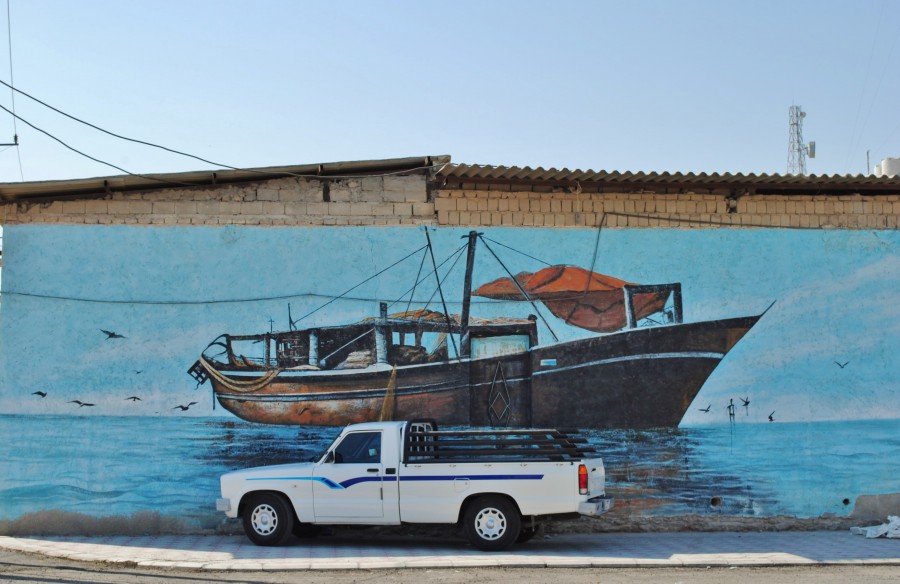
Street art on Qeshm Island. Persian Gulf; Iran.
First I made some photos of people and then went down to Bazaar-Bozorg , who bored me but through the middle of the road to the port. Then I went right and passing the hotel Darya where I left my backpack for storage I reached the main street. My attention was paid to graffiti on the walls of sea turtles, dolphins and women with masks on their faces. After a while they passed two specimens and I admit that their “charms” remained unmoved. These women in small numbers on Qeshm are wrapped in black sheets and have masks covering their eyes and noses on their faces; Probably because if I saw them in normal clothes I might go crazy on them, or rather not? Then I turned left and wandered between the small fishermen’s houses also covered with graffiti. I saw here very good drawings of a fishing boat at sea, a flamingo and a hand holding a shrimp. I would like to point out, however, that street art is not a junk art on the island of Qeshm, as is usually the case in properly European political countries. On Qeshm these are paintings referring to the Bandar culture and look good on the sunny, peaceful streets of the island.
After a while I reached the ruins of the Portuguese Fort with a few cannons and tall palm trees around.Admittedly, the entrance is paid but it is not necessary because even without entering the fort, you can see its ruined walls. Behind any approach the guard let me in at a discount and it was not worth it. Inside the walls there is only a hole covered with rubble and entrance to the basement. Now I know that this object is enough to work around but on the other hand I think that after the restoration of this object it would be beautiful. Shortly afterwards I went to the sea where the seaside restaurant was located and where fishermen were chasing the cuttlefish. The sea was very warm and the weather was great so I took a bath in a small bay. Officially, it was not possible to bathe, though because there was a mosque next door, but the local boys were jumping from the stones to the water so I also took advantage. It was very, very nice and I spent more time in the hot bath than I planned.
I also had a conversation with two men who, to my surprise, spoke English very well. They complained about life in Iran and the Muslim regime, which is destroying traditional Persian culture. I do not know if they told me what I wanted to hear and I do not know how they behaved in Europe, but I told them that we have the same problem because of immigration from Third World countries, Europe is also racially-cultured. I think they were shocked by my response but we still said goodbye. Then walking through the Portuguese Fort I stopped among small houses in a local shop to buy a drink. Here the owner of the store was so nice that he took me on his moped to Valiasr street where there is a shopping center and museum nearby. This is where the Qeshm Town nightlife comes in and it is here that families come to social gatherings when they are not sunbathing.
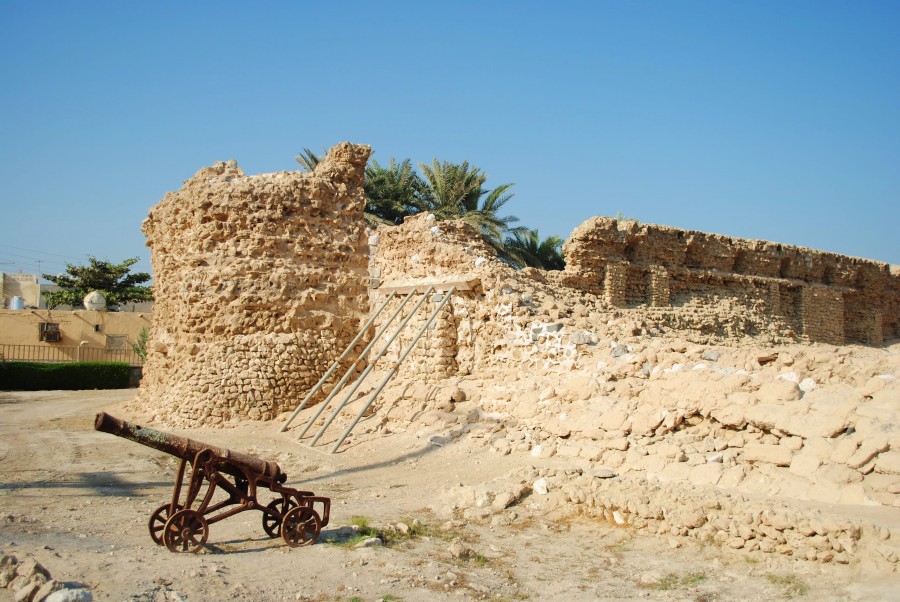
Ruins of the Portuguese Fort. Qeshm Island, Iran.
Unfortunately, it was not until 3 pm that the whole street was empty. I walked down the street through palm trees and grafiti until I reached the hotel where I took a quick shower and slept for another hour. After 4 o’clock I walked down the slowly waking bazaar and once again got to the port. Then I turned left and walked along the sea.
After about 10 minutes on the left I saw a mosque and on the right a small fishing port. I went inside and saw boats and fishermen dissolving the nets, but I think I was the one watching here. By the way, further road leads to a nice beach where you can unofficially pitch a tent for the night. Already after dark I came back to Valiasr where I first went to the long awaited Qeshm Geopark Museum , which turned out to be very interesting. In this “death museum” there are stuffed fish, mammals and turtles of enormous size. For example, there was a small goat with two heads, pelicans, reptiles and also very endangered leopard turtles. I spent the rest of the evening at Valiasr to try local snacks and take a look at the peaceful life of the islanders after dark. On that day I went to bed very comfortably in the hotel and I admit that the longer I travel the more I appreciate simple things.
The next day I took a shower to spare, packed only the most needed stuff and left a big backpack at the Darya Hotel. Then I did not realize it yet, but an interesting and tiring adventure awaited me. As usual, I was not counting on transportation and I was not going to pay for a taxi because it was not my style. On this day I moved on the north coast, because on this side of the island is the most to see and also the easiest transportation. I went along the road that the wind covered the sand and counted on the hitch. Shortly after, the owner of the beautiful hut stopped to pick me up at Dargahan where I got off at the crossroads.On that day the sun was warming as if to burn me alive, and the clouds of sand covered the road and swirled in the air. So I stood by the road sign with my hand up, hiding behind my big hat. Finally, another ranch, which I drove across the desert, came to see the coast.
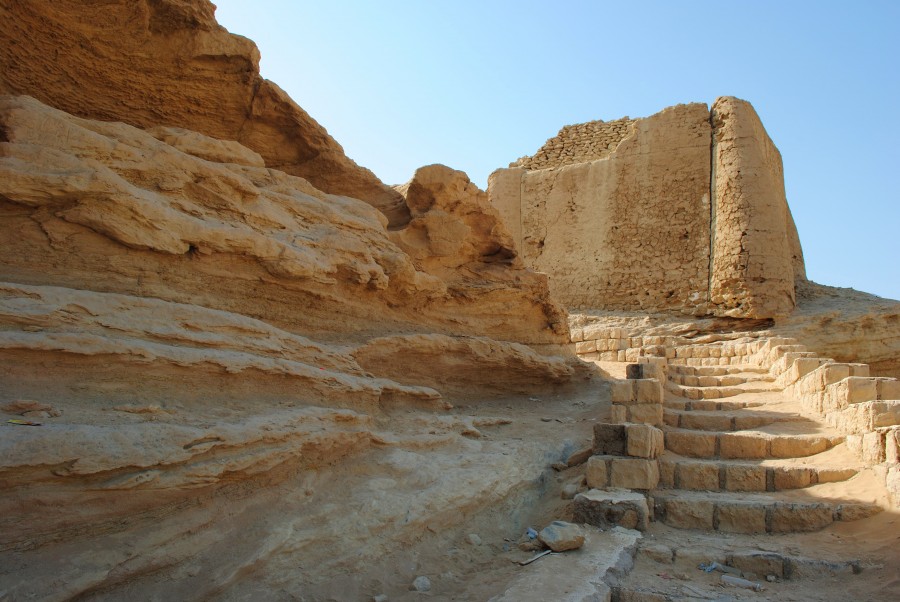
Stone stairs to Fort Naderi. Qeshm Island. Iran.
I thanked for the transport and got off on the beach near Peiposht village where local builders built traditional wooden transport and fishing boats for the Bandar. These boats are sometimes big constructions requiring a great deal of work. They are high and at the back have rooms for people and often also covered terrace. It is also worth mentioning that this yard was not part of the industry. She matched the surroundings and climate of Qeshm Island. When I was here I saw many pieces of boats standing on the beach and scaffolding on the sides. On the last day of my trip, I stopped here again to take photos closer to the sunset.
Shortly afterwards I left for the road and another car drove across the desert to the town of Laft , which in my opinion has a very special significance. Laft is 52 km from Qeshm Town and it is one of the best places to see the traditional culture and architecture of the Persian Gulf and the people in the construction of transport vessels. Laft and its architecture is a good place for a photographer, because while standing on the sandy mountain that runs through the middle of the village, we can watch the windmills ( badgir ), minarets, palm trees and in the distance the blue sea and wooden ships. The whole town is built in the color of the desert and among low-rise buildings one should pay attention first to the Fort Naderi built by the Portuguese and the old well and the conical white house which serves as a water storage. I also came across a large fish sculpture, though what caught me most in Laft is the hot panorama of the desert combined with ancient architecture and the shimmering blue of the sea. When I walked down the stairs on the other side, I also saw traditional buildings, towers, further minarets and a playground for children. I came down from a sandy cliff adorned with dry bushes and then strolled through the empty streets where the women in black sheets spat from time to time or the men carrying the tools.
Both Fort Naderi and a few other objects stood on the irregular, rock-cut rock formations and companionship of the trees, which in this way even more beautifully reflected the realism of the city, and not in an invasive way, but as if Laft had become part of the desert. At the very end I strolled down the seafront and watched people working on their boats and they also watched me. I was a man from another world afraid of their sun. Here, life was on the main road. Men have been driving trucks and mopeds, and from what I’ve seen, a large part of the local community has been involved in the construction or repair of boats, both in terms of work and the social element. Among the boats moored between shore and shoal and among colorful wrecks standing on a muddy shore, men spent all day. I also saw some goats running slowly down the street but I did not see women.

Panorama of Laft town on the Qeshm island. Persian Gulf, Iran.
Laft is constantly developing, as evidenced by excavations and new houses, but I do not think that this ruined town has come out in a very fast pace because in such a climate people simply do not want to work.At the very end a kid drove up on a moped and ripped me a little hat but someone else took me to the main route. Again in loneliness, at the crossroads of desert roads and with a bottle of water and a tent I was waiting for transport.
Soon I got out of the small settlement of Tabl where there was a turn to the mangrove forests . There was a small port surrounded by water on each side and mangroves with birds living there. The site is officially called Harra Sea Forest and covers an area of 9,000 hectares of inland waters, which is a salvation for the dry climate of the island and also serves as a reproductive center for migratory birds. There are also small souvenir shops with shells and of course the boats waiting for customers. On the water there is a jetty and easy exit to the water where I swam the next day. On that day, however, I bought a ticket and with some others we sailed for a half hour cruise. Most of the time we were swimming among the clumps of the forest, but once we also got out on the dried ground to look at the vegetation.
Our captain was an old wrinkled Arab in white pajamas and a turban with a few more teeth. The cruise was, of course, pleasant and not very hot, because the sun was already low and accompanied by pleasant wind.I thought I would spend the night in a tent, but fortunately I was able to lay down on a platform near the shore. At least I had a place to sleep but it was not a quiet evening because the motorcyclists were coming and talking loudly. But they were good because I could see nature in the light of the red moon.
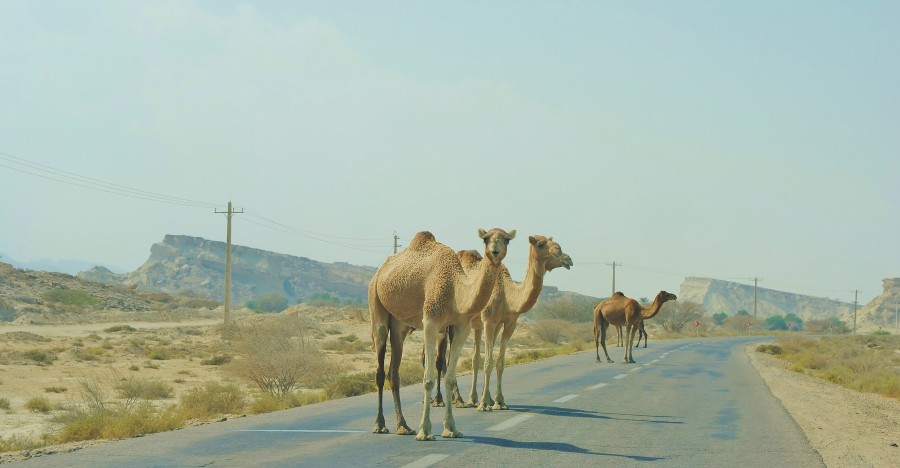
Wild but friendly camels on Qeshm Island. Iran.
The next day I woke up with a headache as if someone had me in the sleep with a gazrush, but I think it was through the heat. So I went to the end of the headland and then bathed in warm water, and after a short, lonely sailing of my own body in the position of launching submarine I managed to come to myself. It was really nice, especially since I was in the nature and from time to time I saw flying birds. Then I dressed, took my smelly stuff and went to Tabl. Here was still empty but knocked on to one host and for only Rs 100,000 I bought a nice breakfast. Tabl is a small village at the crossroads that exists on the map thanks to the mangrove forest and the shortcut to the south shore of the island.
Hiding my face behind the hat and glasses, I did not know it yet, but it was the very day of my Qeshm expedition, which was about to take off and on. As I stepped out of the town, out of the sands, a beautiful rusty rug emerged with the richness of rust and a layer of dust on the dashboard that could be removed, replaced with rust and Arabian sandwiches. During the ride we came across a herd of wild camels but were captivating above all the huge and impressive rock formations of sandstone. In some part of the road, which I remember well, the driver blew me out so I could go across the desert to the canyon. I had only one, less than a bottle of water, which was a big gambling but I knew that in one of the canyons there was a well with fresh water and I was hoping to find it before emptying my bottle. At the moment I was more interested in adventure than water, which was on my side very unprofessional given my travel experience. I walked alone through the hot desert watching the sandstone formations and sometimes encountering camel footprints in the dried, cracked land. Some of the formation looked like the mountains twisted from the wind in one direction and others looked like mid-sized sandy rocks with peaks like aircraft carriers.
After some time, when the sun was burning me a friendly attitude and when I had not much water, I reached the wall formed into rows of small canyons. I walked up to them and then climbed over their walls and checked to see that there were no venomous snakes in the small cracks. But seriously, I was delighted with the desert architecture. Rows of passes and irregularly scattered stones and stairs composed of successive sandstones gave a beautiful element of adventure. The bad news was that I was out of water and it was still hot and I still did not find the canyon in which it was a well and which offered a shadow. So I went back to the main road and then on the treaded path for cars I reached the Char Kukh canyon, which in my opinion is a phenomenon of nature. It is a very narrow and relatively tall canyon where the walls look like sanded capsule sleeping bags of many shapes. As I moved further, it was nonsense but always phenomenally beautiful and the rocks were more and more unpredictable. You can also get into the canyon and I’ve taken this test to some degree, but it involves a lot of effort, jumping and squeezing through the cracks and changing the color of the clothes to the color of the desert. When I got there I was obviously delighted with the beauty but first I rushed to the well. I also filled the bottle and then sat in the shade above the well, holding my feet in the water. Relief is not enough to describe the joy of the traveler, who went through the pits found water.
The Char Kukh Canyon, its entire setting and even the road to it and skimpy though beautiful vegetation I liked on Qeshm Island the most. I spent many hours on this adventure and then came back here. Besides, every time I see a canyon I imagine the thousands of years of geology of the region, because once in this desert must have been a violent river, which with such force flowed through the mountain that it first eroded the canyon and then dried.
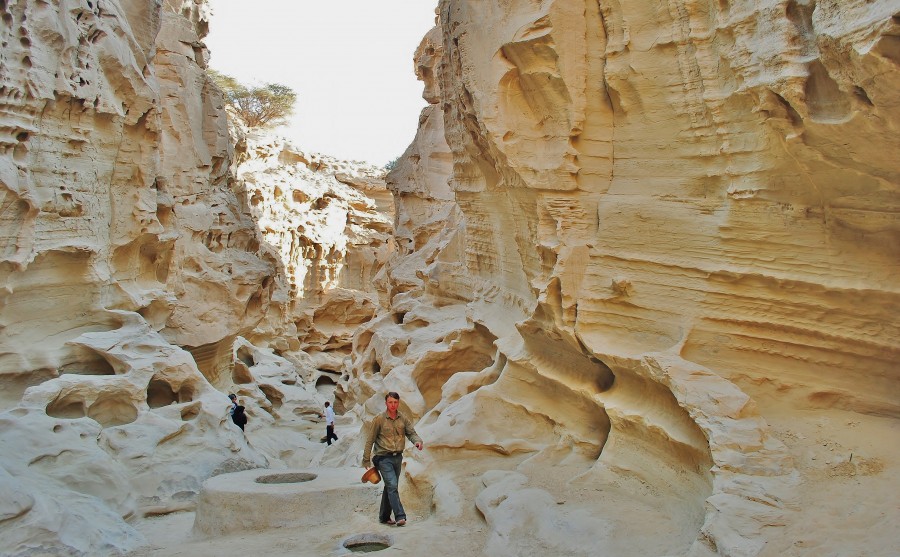
The phenomenon of nature. Char Kukh Canyon on Qeshm Island. Iran.
That day was late so I got to the main road and caught another hitch, which I returned to Tabl . In the evening it is a small town consisting of several houses and shops and cut through the road comes to life. I felt that after a day in the desert I did not want to go on. I wanted to stay among the people where I could eat kebabs, buy some fruit and drown in the luxury of many drinks. On the occasion I also bought the glue to glue my parsimonious, grandfather to the maximum Vietnamese shoes bought in Yazd and I was also at the hairdresser for only 50,000 Rial. This hairdresser actually cut my hair, but it was best suited for goats and shaving Arabs. It was the worst hairdresser I ever had, but at least I had more order on my head. For the locals I was a kind of detachment from day to day because the White in their distant village at the end of the world is like a flying elf with a bell on the neck. All evening I almost stopped to shop, I was sitting in the pub with my drinks and I wondered where the tent was. So I went back to the mangrove forest because there was a large desert field in front of it, which was a convenient place to break the tent.
With the light of my moped and my own torch, I managed to set up my very tired tent, which was already with me in Kazakhstan, Azerbaijan and many other countries. Then I settled down on the desert ground, watched pictures of the last day, and fell asleep in my portable free hotel. Many people who talk to me consider me a millionaire because I have been in so many countries but no one is aware of the discomforts and sacrifices that are needed to complete my expeditions. That’s why most people prefer to stay home.
The next day I folded my tent and went to the water near the mangroves. I left my clothes on the stones and, holding the rope of one of the boats, entered the hot water. Once again, this bath was very pleasant and gave me the energy to take another unforgettable day.
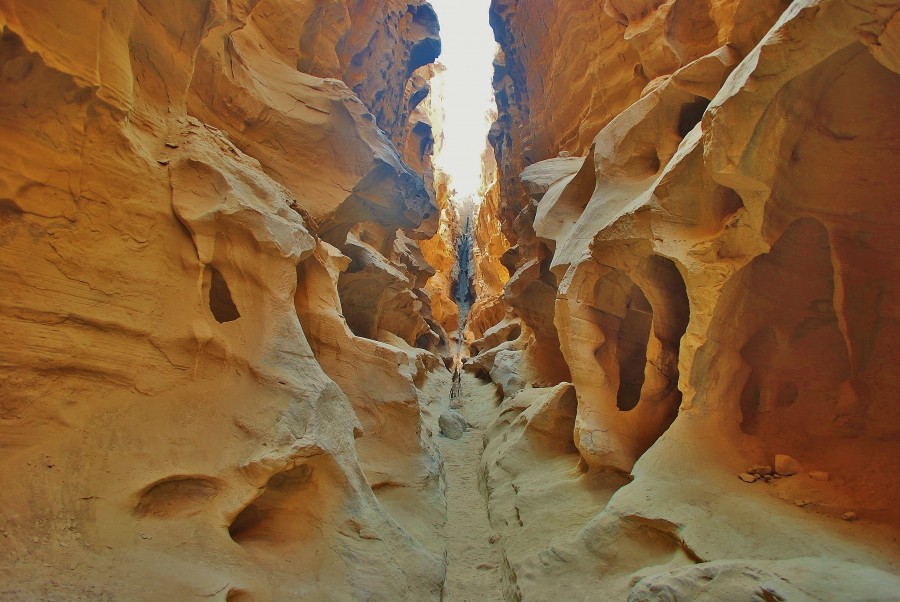
Char Kukh canyon on Qeshm Island. Iran.
When I returned to Tabl I first went to the same host as before to buy breakfast and then stepped on a rarely traveled road to the south shore of the island. I waited a long time and lost hope but knew that it would be. But when the car arrived, the driver picked me up through the center of the island to Salakh on the south bank. Hence, in principle, the transport was impossible because theoretically nothing went wrong and my next destination was about 16km away. The Salak men looked at me even more strangely than those of Tabl and finally I had a conversation with the army. The Qeshm Coast is a military base and you can not even break a tent here, so every visit, especially to someone who looks like an American spy, makes the police nervous. Getting out of here was not easy but someone finally took me a kilometer to get rid of me and it was hard. On one side I saw a sea and a long sandy shore with a few plants and after another a mountainous, solitary desert. I had a supply of water with him and I was glad that I was doing this adventure but after about an hour I wanted someone to come. But none of them went there, nor in one direction. I did not believe my eyes when the car rose from the dust of a deserted desert road. After a few minutes a new, elegant off-road vehicle stopped and my driver, though reluctant to say he would take me to Karge, would have to worry further. We drove through the hilly road which only gave me more attractions and once we also went on the beach as the road was in worse condition. I think the driver liked me because he decided he would take me another 8km outside of Karge.
With the passing of miles, the sandy scenery became red and maroon, and soon we reached the Namakdan cave. Namakdan Cave is another phenomenon of nature because at depth of over 6km it is the deepest salt cave in the world. Before I entered the cave I went through the red hills which is also unique. If someone would like to do some photos here in the most glamorous places he could say he was on Mars. As for the cave itself, there are two main entrances. One is very low and you can see in it icicles hanging from the ceiling and a small salt pond. This is the entrance for professionals in overalls and helmets and there you have to crawl.Beside, however, there is a wide and spacious entrance for people without equipment but it can be 100-200m deep. Here nature also formed spectacular salt walls, great salt boulders and uneven transitions.Both the red mountain Namakdan and the cave are beautiful and getting here was worth it. When I was here I met the Iranian tourists who came to Qeshm by car and they took me with me. That means they solved my biggest problem at that time because I was wondering how to get out of there. The women squeezed in the back seat and I sat down next to the driver. I saw a part of the island that I did not plan to see, because the Iranians were going to Qeshm Town, but first they wanted to see the Char Kukh canyon.
So we drove through Kani and Darkuh , which looked like an abandoned, battered, forgotten city, and then stopped at the beautiful Char Kukh canyon where I was breaking through the narrow slits. This time I was not alone here, so my companions took better pictures of me. I always wanted to come back here. Then they set me down in Dargahan. Dargahan is a great shopping center where the islanders come to shop. But I invited myself to a Persian dinner during which the whole pub was very interested me and finally we made a souvenir photo. It was cheerful and it was different than usual in Qeshm because I was in civilization.
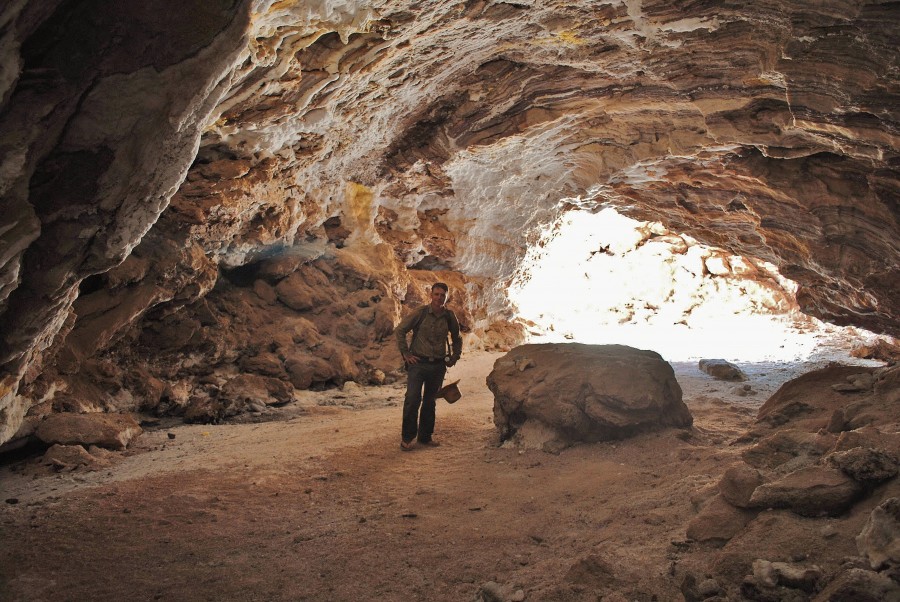
Namakdan Cave is another natural phenomenon because at a depth of over 6 km it is the deepest salt cave in the world. Qeshm Island; Iran.
Then I got on to the next hitch and returned to Qeshm Town. It was so late that I went to the Portuguese Fort to break up the tent, but it finally came out that I was still begging for a sea snack of seafood.Unfortunately, I chose a bad place for camping, because in the morning I was awakened by tractors and other machines from a nearby construction site. So early in the morning I made a tent and then went to the port to get back to another hitch. This time I got off near the roundabout where the entrance to Qeshm Town started. The charm of this place is that next to it was a very nice bed where I finally found peace. I lay down on the sand listening to the sea and then I was still bathing and I stumbled for a while. I think it was my time of thanksgiving after a hard expedition.
Then I just got on another hitch and got off the harbor to have a breakfast of natural yogurt, jam and some fruit in a nice pub. It was a breakfast of many rumors about my adventures, or about what I managed to do alone here. Shortly afterwards I put on a hat and went to the Hotel Darya to pick up my luggage. I repacked, changed, got a drink from the company and after official thanks went to the port.
My wonderful, unforgettable trip on Qeshm Island was over.
Cruise from Qeshm to Bandar Abbas and from Bandar Abbas to Hormoz Island
There is no direct transport from Qeshm to Hormoz therefore traveling from island to island is only possible by Bandar or other mainland destinations. Of course, it is possible to be banned from smuggling but I do not recommend this option.
Qeshm – Bandar Abbas, 2h, 70.000 Rial.
Bandar Abbas – Hormoz, 0.5h, 40.000 rial.
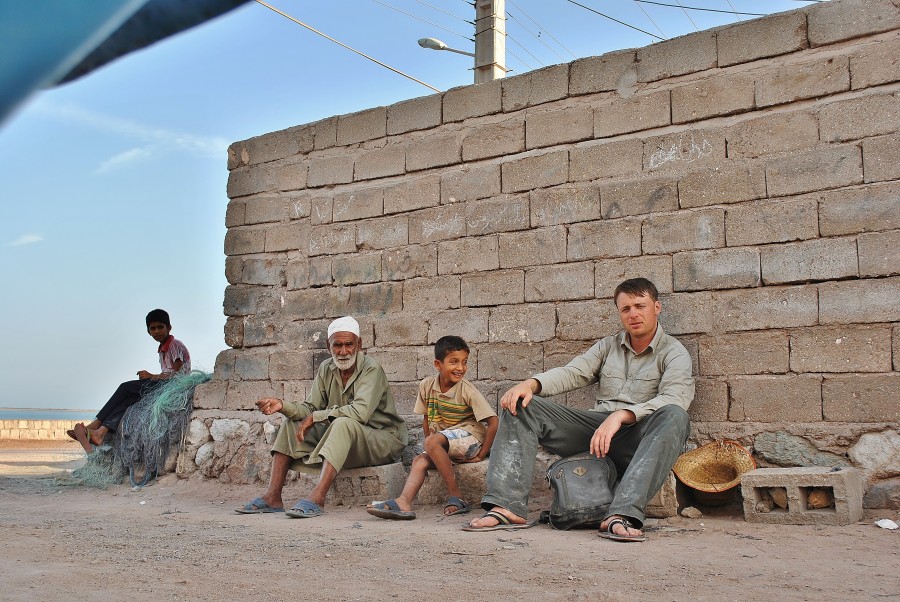
Z miejscowymi na wyspie Hormoz. Zatoka Perska. Iran.
Hormoz Island
Hormoz is a small island in the Persian Gulf that is named after the Strait of Hormones. This island only covers 42km², is exceptionally hot and there is no fresh water here. However, close to 8km from the mainland, a pipeline supplying water was constructed. Hormoz Island is a dry land that extends from the ground where the highest point is 186m asl and where the surface consists of sedimentary rocks and volcanic materials. The people living here are fed from Bandar Abbas because of the very hot dry climate characterized by the lack of precipitation that both the soil and water are salty.
The only thing that does not need to be imported into Hormoz is fish. As soon as the boat moored in a small port, I went out to the street running through the sea, and apart from the heat, there was a gaping silence. There was an empty, gray road from the burning sun. On one side I saw neglected barracks with a few palms and across the shore and boys who probably bored with fish. At the end of the horizon I also saw the ruins of a large Portuguese Castle , which, despite many years of neglect, is still considered one of the most exalted colonial buildings.
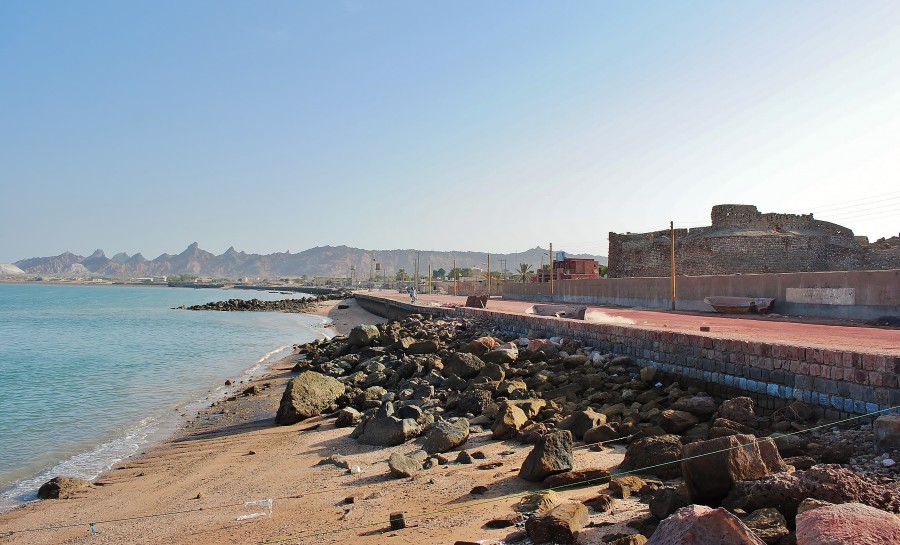
The landscape of of Hormoz island, and the Portuguese castle in the distance. Persian Gulf; Iran.
It was completed in 1515 and its thick walls, numerous passages and cellars, despite its years and poor condition, made a great impression on me. I entered its main square and then climbed to the top from where I had a good vantage point over the town of Hormoz, the protruding minaret and the mountains in the distance. Then I went down and, walking on the red soil, I reached the town of Hormoz where I was in the center of attention of people, but most of all making faces of children. It was a wordless meeting based on gestures and observations during which the children broke away from everyday boredom. Then, walking along the shore and hiding in a hat, I watched fishermen untie their nets and watched the waves crashing against the boulders on the beach. I was collecting shells, I saw a boat filled with small fish and once I came across the head of a hammerhead shark lying on a rock.
I spent the end of the day on the dilapidated pier, which is also the main mooring place for the fishing boats. I was also wondering if all these catches are organized out of boredom or if the fishermen go with them to Bandar Abbas to sell them at the market or exchange them for other goods. I think that this business would be the main livelihood for the islanders, because whole little fish boats are too much to feed only the 2,500 Hormoz population. Walking to the port after dark, I could see that life goes on here. From the descriptions of people who were here before me, I read that there were no restaurants or shops here, but at the end of 2013, when I was here, I found many food stores and also small bars with lousy burgers and pizza.
I was in a hurry for the last boat that left Bandar at 6pm and luckily someone picked me up on his moped. I thought it was very nice of all these people, but I also take into account that they also often take me out of curiosity to make contact or at least look at who looks like the heroes of American movies. Living in such a wilderness, I would also take everyone. The boat was two hours late which meant I might have missed the last bus leaving Bandar Abbbas. What’s up, I thought. There is always a place to put up a tent.
With a mind of beautiful memories and with the pockets stuffed with shells, I returned to Bandar Abbas.
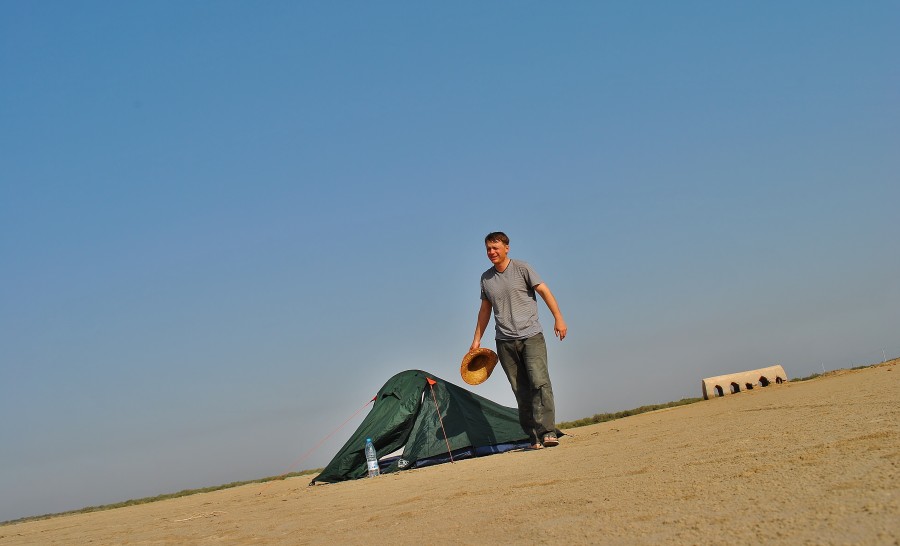
Qeshm Island. A hard life and dedication in the desert ‘paradise’.
Return to Bandar Abbas
(Stay 2)
When I got off at the port in Bandar Abbas it was late. First of all, I was happy to bring my expedition to the Gulf of Persia to the end, but I also wondered if there would be a bus at the station. I walked through the illuminated bazaars of Bandar Abbas and then grabbed a hitch and went to the station. The bus departed at 10 pm, so I spent the last half hour at the bar. One of the shopkeepers set the tables outside and poured tea. There was an elderly Iranian who had been living in America for a long time and told me how Iran had changed since his youth because he often came here. I was wondering where I would be at the age of 60 and whether I would be happy with the years I had lived.
Transport from Bandar Abbas to Kerman
120,000 rial in 7.5h. Driving without problems.
Kerman
Kerman has some noteworthy attractions, such as the old bazaar or the very interesting Museum of Defense and a couple of good restaurants with traditional Persian food. With a population of about half a million Kerman is not tiring and you can walk to see the most important places in one or two days better.Famous for all Iran are also carpets from Kerman, which have their own distinctive patterns.
Kerman also has a minority of Baluchs (2% of the population of Iran), a nation moving between Iran and Pakistan and living in tents in the desert. This desert city located in the south-east of Iran is not only another good travel experience but also a base for the Indian subcontinent and many other destinations. While here I had many fascinating trips, such as the Kaluts rock formations and three interesting towns on the border with Pakistan. Kerman was my base for a while.
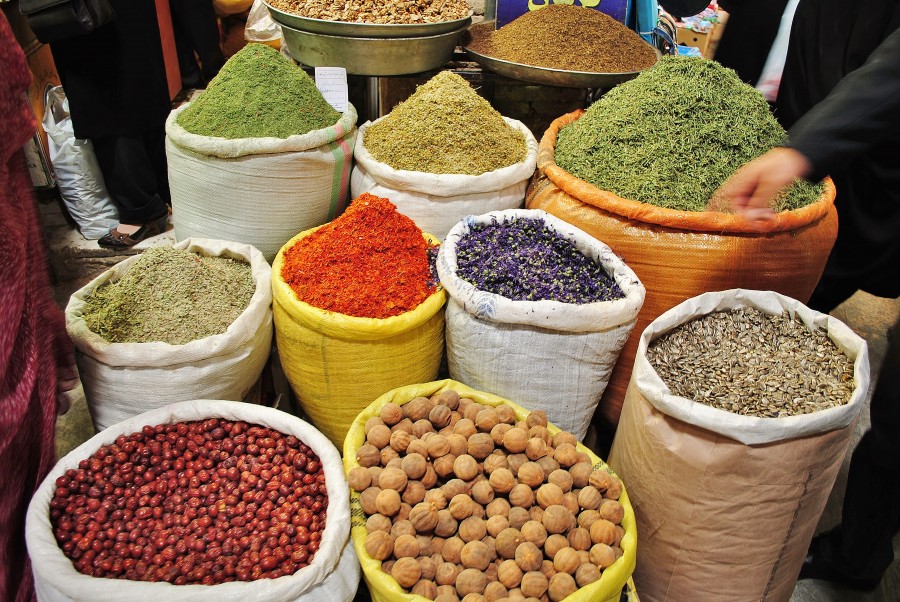
Persian spice stall in Kerman, Iran.
When I left the bus the taxi driver picked me up at Azadi Square and then parked a bit further at the poor Miludi hostel, which is so basic that he is not even in all the guides. At the hostel Miludi I had a small room with a bunk and an outdoor bathroom for only Rs 150,000 per night. What a great price. Hostel Miludi was a place where people from good spheres did not turn around because they were so sick of imagination. As for me, it was not a problem.
I spent two days in Kerman, although one day would be enough. But I did not hurry. I had time for tea, for quiet sightseeing and uninterrupted observation. At first I spent a few minutes at the crossing above Plac Azadi . There is a large area surrounded by water and greenery and with a globe at the central point. In the morning Azadi Square was empty and taxis were unemployed but in the evening there is always a cork.Then I walked straight to Shohada Square, which was a few miles from me. I walked the road with nothing special in mind.
On the right side I passed the cinema and then the Museum of Modern Art , which was unfortunately closed. Building around was not exciting, especially given that I had been traveling to Iran for over a month. When I reached Valiasr Square I turned left and after 5 minutes walking to the right I saw the Kerman National Library . It was built in 1929 in the late Qajar style which means, among other things, elements of Muslim architecture with fine mosaics and pillars supporting the roof. Before the library was an exotic plant and a monument to the mother reading a child’s book and in the middle I saw students with noses in books and of course a poster depicting Khomeini. The library is unnoticeable because of the desert-colored gate decorated with blue patterns. But behind the library is another green area and behind it a real attraction for lovers of secular Persian architecture.
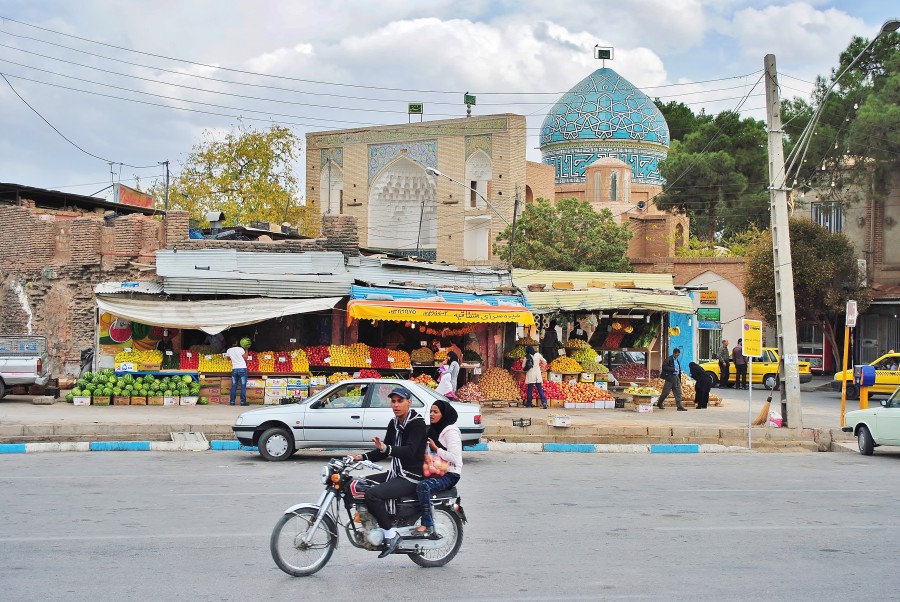
Street in Kerman. In the background, the Mushtaq Ali Shah mosque. Iran.
This property is the Moayedi Ice House built during the Safavid dynasty. Just as before, when I described the ice house in Meybod near Yazd, the same is of conical shape and a large wall built in the traditional way – sawdust and clay. The Ice House is surrounded by a garden inside which water gathers, then freezes and slides down to the Moayedi. This property also served as a refrigerator, which in the desert climate was salvation because before the electricity bill people stored there food, drinks and made ice cream desserts.Unfortunately when I was here the object was closed and from what the shopkeeper working next door is always like.
Nearby is the Museum of Holy Defense , which is very spectacular, emotional and in a very illuminated view of the Iraqi-Iranian war. The museum includes pictures of the Iranian army, including the current leader of the Iranian spiritual leader, Ali Khamen, as well as photographs of torn corpses, images of the battlefield and even the sinking ship. In addition to the many caliber weapons, there are paintings depicting an Iranian mother clutching a dead son’s head and a mother saying goodbye to her sons going to death. Outside, there are tanks, rockets, cannons and artillery weapons of many kinds. There are also trenches fenced with barbed wire and artificial lake showing crossing from one shore to another. Before the main part of the museum is a water area, garden with lush vegetation and between the painted flowers faces of Iranian soldiers killed in this cruel war. The museum is sure to reach the visitor.
That day was the last place I visited. That evening I invited myself to a Persian dinner on Azadi Square and went to the internet shortly thereafter. On the way to my very cheap very low class hotel I also bought fruit and persian sweets and had a quiet evening.
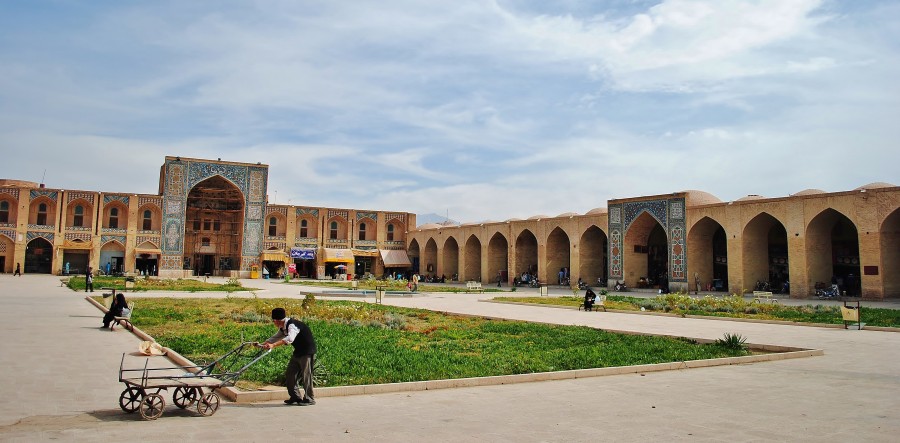
Meydan-e Gandj-e Ali Khan Square, Kerman, Iran.
The next day I started my walk around the city from Azadi Square. This time I did not turn left at Valiasr Square, but went straight ahead and stopped at the Grand Bazaar (Bazar-e Sartasari), within which there are many other objects. I started with Tohid Square , where there is a water area and a high monument, which forms the entrance to the bazaar-e Vakil . The square is surrounded by traditional arches and an open corridor with rows of shops. As usual in Iran, I advise you to pay attention to the brick ceilings and the way the pillars are finished.
After spending my time on the water I turned right into one of the side streets to sit in the local tea room. There were a lot of middle-aged and older men smoking cigarette tubes and drinking tea so I sat down at them. I was offered scrambled eggs with tomato sauce which is a tradition in Iran and tradition is also that it is just through this sauce you should immediately find out where the toilet.Returning to the Grand Bazaar itself, it was built in the 17th century and is divided into 20 smaller bazaars, as well as several squares, and has its own baths and mosques. There is also an older part of the bazaar, whose back are made of clay and sawdust. Persian tradition is that the bazaars are cities in the city, meaning that they have everything they need in the city, as they spend most of their lives there.
Vakil bazaar is relatively small because it occupies about 600m and passes into Mosafari bazaar and just behind it is Jameh Mosque. One of the bazaars is also Bazar-e Ganj Ali Khan and a richly decorated mosque and square of the same name , with a courtyard typical of the architecture of the Safavid era. Once again there are arches and open corridors with rows of shops and a fountain in the middle.
Nearby is the noteworthy Hamam-e Ganj Khan , which was converted into a museum. There are impressive frescoes and models of scraping men. (A similar object was in Shiraz). Generally speaking, these bazaars can buy everything from herbs and teas to seeds, supplies and gold. I bought only silk scarves for a woman waiting for me in England. After more than a month spent in Iran, things are alike, but even the wonderfully finished, conical ceilings are no longer in the mood for this place, shoppers praising their goods or even the street shoe repairing shoe. At that moment I realized that Persia gave me a lot of joy and I really liked my adventure with this country.
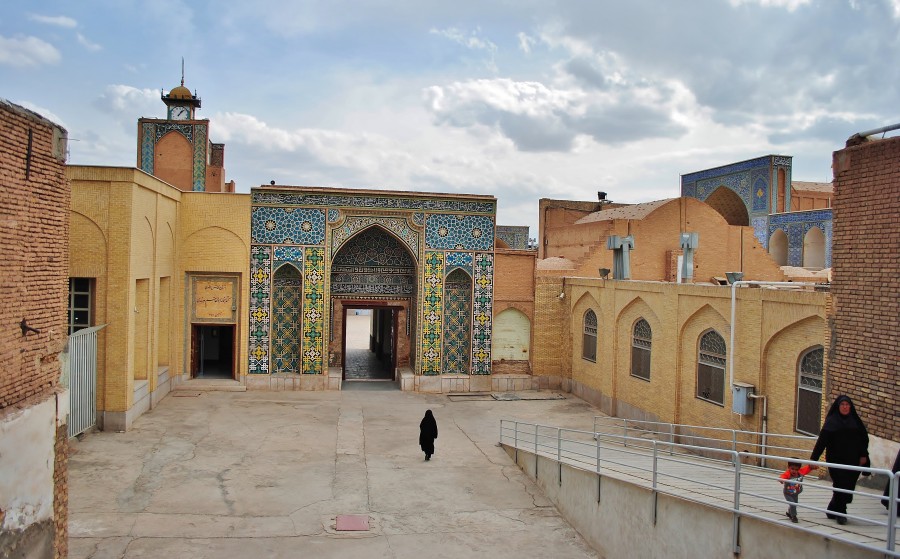
Jameh Mosque in Kerman. Iran.
It was a great pleasure to have a visit to the tea room, which also serves food. I mean Hammam-e Vakil Chaykhaneh, where I drank tea while sitting and listening to Persian music. This bath is decorated with stylish arches and elegant mosaic ceilings. Definitely one of the most distinctive and emotional places in Kerman that I highly recommend. I also advise you to try delicious side dishes.
I spent the rest of the day at Shohada Square, a place that turned out to be very good for me in terms of contact with people. I was on the vegetable market, at the shoemaker, and made contact with the elders in one of the clay streets. Often these people who could not speak English wanted to at least shake my hand and say “hello”. Being in this area, I saw a few other places worth mentioning, but I will not describe each one as they are all similar.
The Moshtaq Moshtaq Ali Shah mausoleum, whose blue domes are decorated with mosaic patterns, can be seen from afar. It is an architecture from the late Qajar dynasty, which repeats itself in Iran around the clock. In the center, there are decorated ceilings for viewing the domes from the bottom and curved arched windows.
Next to it is the Paleontological Museum , which I unfortunately did not enter because it was closed but instead I spent time in Park-e Sangi , over the water and climbed to the top of the clay mountain after the views of Kerman from a higher perspective. On that day I saw two more mosques close to each other and I admit that I was glad that I was only two. When I came to Iran and saw the classics of Persian architecture it was interesting to me but being in Kerman I was already tired and could not wait to tour the city.
The first mosque was the Jameh Mosque, which translates as a Friday mosque. It is for this reason that in every Muslim country (and now unfortunately in Europe) there is a mosque of that name.

In the Hammam-e Vakil Chaykhaneh bathhouse, where I drank tea while sitting on a chaikhana and listened to Persian music. This bathhouse is decorated with stylish arches and elegant mosaic ceilings. Kerman, Iran.
This mosque has a traditional courtyard and four mosaics decorated with large gates ( iwan ) but interestingly instead of the minaret has a clock tower. The blue tiles date back to 1349, but were later refurbished several times. Another object of this type was the Imam Mosque , which is a bit further away.This mosque will advance to the former though it is still older since it dates from the early Muslim period.The large courtyard with fountains also features characteristic gates and mosaic patterns, although my attention was most drawn to the poster labeled “We’ll knock out America” and the symbol of the rifle next door.In Iran, the hatred of America is cultural, and this tradition continues from generation to generation, but on the other hand, Iran has many reasons to hate America. I would also like to point out the back of this mosque, one of the towers supporting its walls and further to the clay ruins of an ancient building. In the rear of the Imam mosque there are also small chimneys that resemble the roofs of the hammam.
When I finished the tour I returned to Shohada Square where I sat in the ice cream parlor and answered inquiries of curious men. As always, they wanted to know where I was and why I came to Iran. Then I went back to the bazaar and watched the poor people who were selling their goods from the sun loungers or the ceraties on the floor. It was also interesting to place this place. On the one hand I saw the back entrance to the Jameh Mosque and the other labyrinth of the traditional bazaar. Soon after, one more tea and a stop in the quiet square of Vakil tried to take my impressions of Kerman. As I approached, I returned to my cheap hotel.
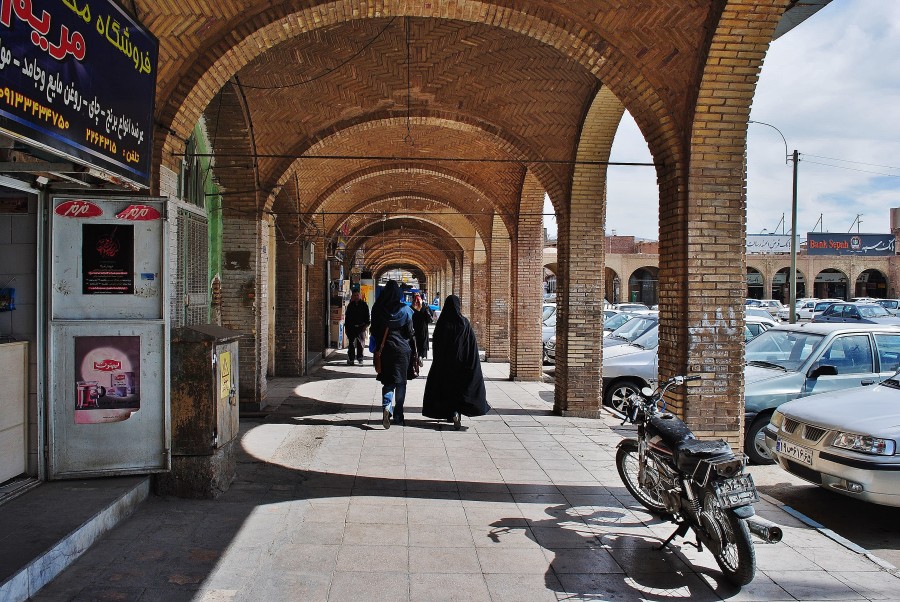
Walk through the traditional Persian bazaar in Kerman, Iran.
My great adventure trip from Kerman
In this chapter:
-Shahdad and expedition to Kaluts,
-Mahan,
-Rayen,
– I am and earthquake,
-drug smuggling from Pakistan .
In the morning I left my luggage at a cheap Miludi hostel, took only the most needed things including a tent and went to Shohada Square. From there I got into a shared taxi going to Shahdad (about 100km from Kerman), which is a starting pit for the Kaluts sand formations. I shared a taxi with three other passengers and I paid Rial 100,000 for my seat. My driver looked like he had not slept well and we were all afraid that he was driving behind the wheel. When we left the main road leading to Kerman we turned left and at that moment beautiful mountain views started. Our yellow Peugeot 405, which is a traditional taxi in Iran, picked me up through the mountains but most importantly through the emptiness that I usually look for in my lonely expeditions. Once we passed the tanker with gasoline but besides, there was only our taxi and open desert spaces where the horizon ended in the mountains.
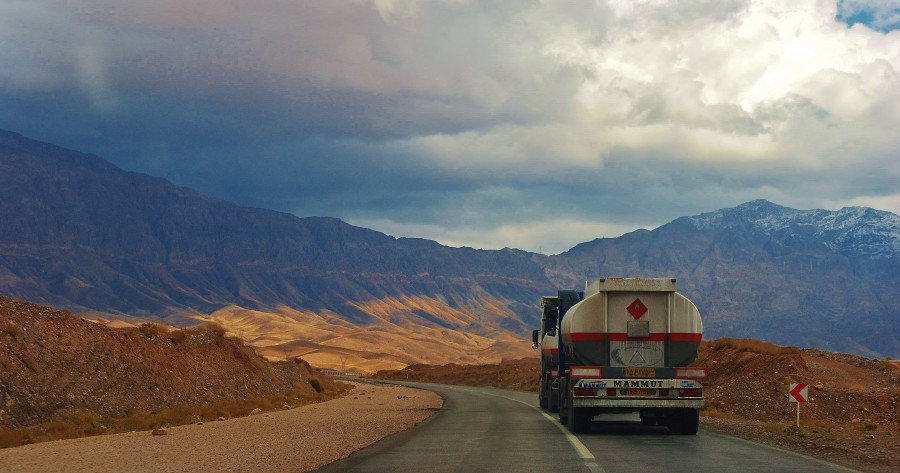
Hitchhiking through Iran.
After about 1.5 hours we reached the small desert town of Shahdad , which is the base for the open desert.The moment I arrived I was rushed by a tour operator who did not want to take me to Kaluts for a lot of money, but he still wanted me to go home. It was a poor but honest man who wanted to earn and who seemed to have money. I just asked for a shuttle to Kaluts but he said there was no transport or hitchhiking and that of course recommends your little homely hotel. The dry, hot Shahdad town does not deserve to stay here longer than necessary, but unfortunately I had to because the police took me. Coming through the alley of the Shahdad palm trees and at the same time breaking all the traffic laws, the police stopped me at the station where they asked me questions. They wrote my passport details and then asked questions that I could have expected. My book on Iran, my notes and where I was, where I wanted to go and when I returned. I also thought for a moment that they were looking for an American spy but after a while they gave me a bottle of water and let them go.
I was so lucky that a kid picked me up from his police station to the mausoleum of Imamzadeh-ye Mohammed Ebd-e Zeid . Although I have seen many places of this type for a while to see the blue domes, the mosaics, the desert courtyard and the trees that add charm. The building was open, meaning that it was not surrounded by a wall and led directly to the desert. All I had in mind was the joy of saying goodbye to the police and how I got to Kaluts. On the other hand, I have already traveled the Pamirska Route, mongolian steppes or even Tibet, so getting to Kaluts was a relatively small challenge. When I left the mausoleum, I marched an empty, deserted road and wondered how I would get about 38km of desert road. For a short while I saw a palm tree and a man who carried branches on his moped and who was staring at a white traveler as if he had seen the species for the first time in his life. Then I found myself on the road and I admit that I was lucky. At first I was driven by a family living in Shahdad and I had two more lorries driving.
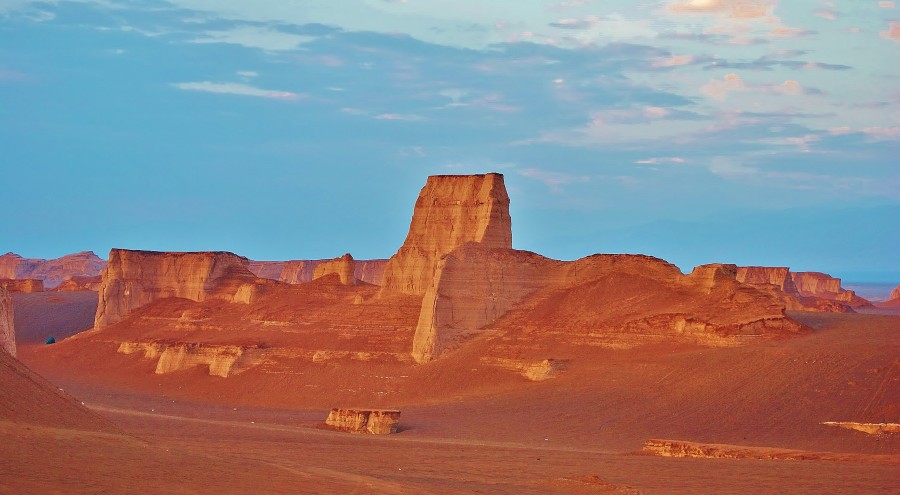
Kaluts, or sandcastles. To think that I traveled the entire Iranian desert to see sandstone rock formations in the desert.
When I saw “sand castles” in front of me, I was happy to finally make it. The truck driver blew me out before Kaluts started because I wanted to get there slowly, on my own feet. Kaluts is a phenomenon of nature that dominates the horizon through five and ten storey sand formations carved in the form of various shapes.
During my travels, I have seen many rock formations, but what they represent is that Kaluts exists only in Iran and no one is quite sure how such huge “sand castles” were formed. In my opinion, somewhere in this place was flowing river, which carved rocks, and when it dried the wind formed blocks of sand. Another theory is the strong soil erosion combined with the rain of comets crashing here at great speed, but the fact is that everyone can create their own theory. Anyway, I was very excited about my visit to this beautiful wilderness and that was why I went through a great distance between the huge sand walls. On the same evening I also climbed several of them to get a better view, especially since at sunset the Kaluts and the desert took on other colors. That evening I pitched a tent on one of the great sandy mountains and counted on a quiet night. But even though the Lutheran desert is one of the hottest in the world just that night, it rained and it was so strong that it broke my tent. But there is no lighthouse in the desert, so with the help of a flashlight I was looking for my things in this vast wilderness. Then I spread the tent again and eventually I fell asleep. In summer, it is best to sleep in the open air, which is commonly referred to as the “million-star hotel” as you can see the beautiful starry sky in the desert. When I was in Kaluts it was exactly the same; moon and stars illuminate the tips of the sand castles.
In the morning I went to the other side of the road covered with sand as there were also very high and massive Kaluts but much easier to climb.From the very top, at sunrise the view of the other side was obviously impressive. The desert horizon was enriched with sand mountains, and one of my tents continued to stand. After exhausting my morning walk, I rolled up my wasteful possessions and went across the desert along the road. After some time in the clouds of flying sand I saw a truck in the distance, which stopped for my great happiness. The night was cold so I was a little bit cold but the drivers had hot tea. The lorry drove me around 100km and at my request I was blown up on the main road to Kerman, although I was not there yet.
When I was on the highway, I knew there would be no transport here. Quite quickly stopped the passenger car and took me to a small town Mahan . Lying 35km from Kerman, Mahan is a small, peaceful and quiet town that is a destination for hikers in Kerman.

Kaluts in Lut desert. I slept here in a ‘million star hotel’ absolutely for free. I just layed down in the desert and fell asleep watching the stars.
When I was here sadly fell on me a rain rain so I did not feel to calm me, and even on the contrary, but once I started to dry it was really calm. Besides there are two interesting objects to see. I do not think it is astonishing that the first object is a centrally located mausoleum, because Iran is a country of mosques and mausoleums. This object is called Aramgah-e Shah Ne’Matolllah Vali , whose high blue dome aptly suggest that it must be this object. I admit, though, that I myself was surprised to find that the place I liked was not boring me after a while, and it was probably because of the nice water body and tall trees.
At the central point there are several rows of small pools with potted plants on the edges, while the traditional gate ( iwan ) is decorated with mosaics and sculptures of symmetrical shapes. Above is a blue dome and two minarets. Inside the mausoleum there is also a tomb and many architectural ornaments such as painted ceilings or painted and carved windows. On both sides of the courtyard there are souvenir shops and a bookshop. When I left the mausoleum I also went to his back which I highly recommend because this perspective gives greater realism of this immense 15th century building. The back looks like the whole object was made of clay but has blue parts (dome and minarets).
The next facility is located 5km outside the city center and on the other side of the main road …… and fortunately it is not another mausoleum. This time it’s a very nice garden called Bagh-e Shahzde, which I got to by hitchhiking again. This garden, built in 1873, is a unique gift for the surrounding desert landscape. It has been built on many levels, which means that small bodies of water with fountains in each of them are situated on the principle of stairs, while the water flows in the form of waterfalls to the lower bodies of water. At the very top is the palace of one of the last princes of the Qajar dynasty, which today has been transformed into a restaurant that does not always work. There are planted flowers and tall trees around. This place is of course a very pleasant place, but it is also worth mentioning that for people living in a sub-desert climate where the temperature in summer reaches up to 50 ° C, the Bagh-e Shahzde garden and its water bodies combined with greenery are a real relief. There is also a bathhouse in the park, but I’m not sure if it works. After leaving the park, I tried the sweet pomegranates that were sold by local gardeners and then I remembered Georgia and Armenia, because the Caucasus is the region of pomegranates.
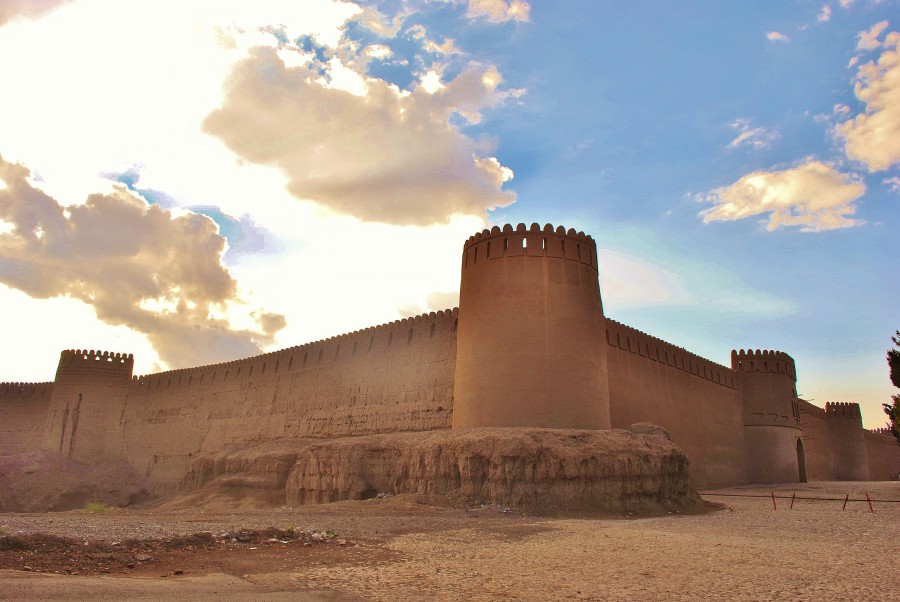
Arg-e Rayen Citadel in the small town of Rayen, Iran. This citadel, although impressive, has never been as popular as the one in Bam. Sadly, the citadel of Rayen only became popular after the 2003 earthquake destroyed the citadel of Bam.
When I finished visiting Mahan I had traditionally been on the road and waiting for another hitch. This time I was planning to get to the small town of Rayen, which is 111km from Kerman and according to my calculations 76km from Mahan. The Mahan is located on the main road, but to get to Rayen you have to first turn to Rayen (88km from Kerman) and then turn right and drive another 23km by road. But I was so fortunate that one of the hitchhikers from Mahan came straight to Rayen. The older man took me and he was kind enough to leave 50,000 Rial for me. Rayen is a very small town with a population of about 10,000 people, cool in winter and offering views of Mt Hezar (4420m above sea level).
My troubles in Rayen were not easy, but I started with my driver blowing me off at the famous 1000-year-old Arg-e Rayen . The Rayen Citadel has attracted interest among tourists and it can be said that it resurrected when in December 2003 the earthquake destroyed the citadel in Bam. The Rayen Citadel is an ancient city in the city. It is a building that judges architecture around 1000 years, but scientists believe that its foundations may even come from pre-Muslim times, from the Sasanid period. The cetadella protection is a high wall with 15 towers, which has a width of 3m at the base and 1m at the top. When I crossed the main gate I first saw the studios where craftsmen made handmade carpets and knives with simple machines. Beige walls appeared before me, and a row of arches forming an impressive tunnel and on the sides of the clay vases.
Then I walked down the narrow street on both sides with the ruins of “ordinary people” houses (according to the inscription). These were the rows of sprawling houses where the bricks were pierced by clay plaster or where only the foundations and elements of the old houses were left. More in the same place is the market, which is also one sad ruin; And to think that even 150 years ago this citadel was inhabited. For most tourists it is only ruin without emotion, but if you look at it in depth 150 years means that the grandparents of the present 80s lived here with their families and their homes and the market with all the workshops and stalls were not ruined but lively. At the very end of the citadel is the best preserved part, which thanks to the restaurant looks like new. It is a guberbator complex consisting of four houses, which is also a symbol of the prosperity of the host of the citadel and his family. Each of the houses was also labeled, and after the restaurant’s work the authors succeeded in bringing out not only the beauty of 1000 years old architecture in new form but also by skillfully mixing the clay with sawdust to get bright and dark beige colors.
Completely renovated houses consisting of many walkways, pillars and winding stairs are one of the attractions, but for those who have been to Iran for a long time, for me, for example, a lot of fun was the restored roof of the citadel. It gives a good insight into the higher parts of the governor’s houses and intricately made arches, but also the rest. You can see exactly the higher parts of the walls and above all the ruins and towers. From the roof you can see what was once a city protected by the walls and today it is only a tourist attraction, which thanks to the efforts of people go straight. Being here I made only one mistake. Well, I came when the sun was a little low, which made some of my pictures have a dark but still clear mood. I could still come here the next day but it took me too Rayen, whose large part is also made of clay and sawdust. You can see it well standing on a plateau near the walls of the citadel. On one side you can see the sloping slopes of Mt Hezar and the other clay houses of Rayen and the mountains in the distance.
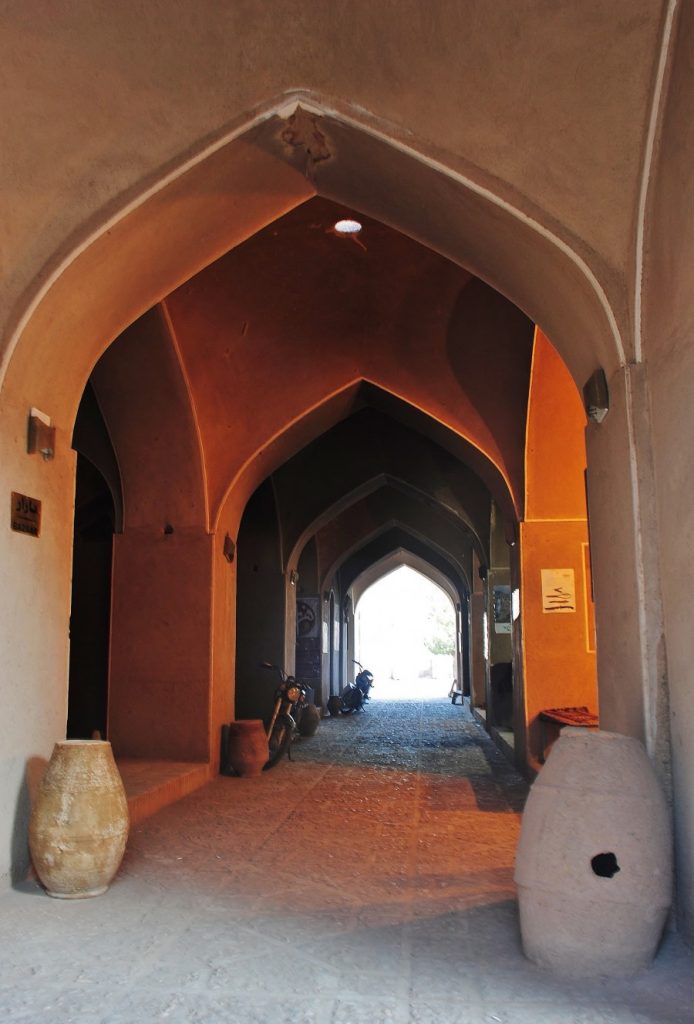
Tunnel in Rayen with arches characteristic of Persian architecture. A place of this type is always the center of trade.
When I left the citadel, I was going to look for a hotel, but my problem turned out to be a struggle for survival. In Rayen there is only one hotel and that day was closed. And it was dark and cold because Rayen was quite high and when I came here it was already November. Several local drivers tried to help me find a hostel but unfortunately none of it. Once I took a woman with children but after about 10 minutes of circulation I thanked and got off. Finally tired and increasingly determined to find accommodation I sat in a pizzeria in the center of Rayen. It was darker and colder than last time, and I needed any shelter. While waiting for the pizza, I went outside to a small roundabout because of the procession of people who, with religious music, was whizzing around with metal chains.
This religious ritual took place quite long and took place near the mosque. The people, however, encircled a substantial Muslim dome, also converted into a clock tower. I admit that this kind of religious rite I have not had the opportunity to see, even though I have traveled many Muslim countries. After a long wait, they finally gave me the pizza I was half excited about, but I swallowed it with hunger. Meanwhile, the owner of the bar gave me signs that I would not sleep on the street. Setting up a tent under these conditions would be a nightmare, but luckily the locals found the headmaster, who was in front of the pizzeria. For only Rs 200,000 I got a bed in a large room and experienced another great luxury. It was a hot shower that brought the weary traveler an undue relief.When I warmed up with warm water I bought something else and I sat down at the stove in another pub and ordered a tea kettle. Everything ended well.
The next day I left Rayen for the road and walked by smiling on the side road. My attention was also to the mountaineer’s monument.
When I was on the side road for some time I looked at the hilly mountains in the distance but after a while I was counting on some transport. At first I was picked up by a boy on a moped and then I got into the car for about 20 km. When I was on the main road I “hunted” for one of the many trucks and finally took me an American truck. I was on an Iranian road leading to Pakistan, which means I was in a place where smuggling drugs and sporadic kidnappings belonged to the “charms” of this region. My road trip on a massive truck went well and while traveling with my backpack, my trip was even more interesting. After about 1.5h the driver drove me out in the suburbs of Bam at the military base where there was also a roundabout with a tower like the old citadel.
According to my calculations from the main route where there is a turn at Rayen is 101km to Bam.
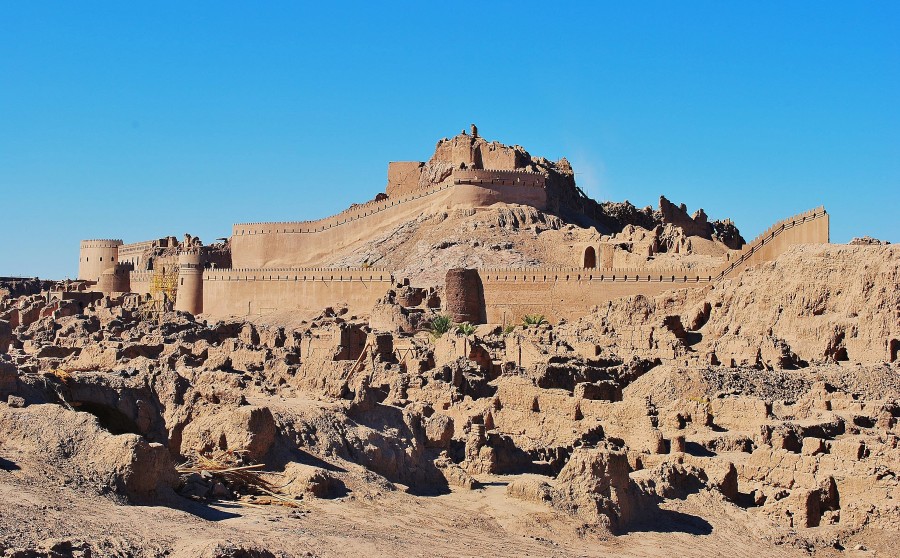
Bam Citadel, already partially rebuilt after the 2003 earthquake. It was a great loss to the world cultural heritage.
To Bam I came only to see the ruins of a huge citadel, which was destroyed by the earthquake on December 27, 2003. Ten years before my expedition to Iran, Bam was known in the world for its 2000 year old citadel consisting of high clay walls, 38 towers and a fairy tale castle inside the ancient city of the Sasanid era. For 2500 years Bam was an important cultural and commercial center between Persia and Indian Subcontinent and between the Persian Gulf and Europe. This was Marco Polo, and now I, though unfortunately I was late because what used to be a magnificent proof of the rich history of the region and became a diamond of Iranian tourism is now in ruins. For about 10 years, the architects of Europe and Iran are working on the reconstruction of the citadel, who are working together to restore the glory of this place and even professionals have no idea how much it will take to rebuild. For now, only the main wall has been rebuilt, several houses at the beginning and walls of the castle inside.
The earthquake that hit Bam with 6.8 on Richter scale killed 31,000 people and ruined houses, shops and schools. People have been pointing at the rubble that once was home, and the bodies of families and friends were extracted from the ruin. Step by step, Bam people began to rebuild their lives and move from tents to brick houses, but the shock and mental disaster of the Bam people is still not rebuilt. A huge citadel, which was built around 600 BCE and which towered on the city brought local pride was destroyed. This huge ancient building of 180,000m² and having 67 huge towers and a wealth of other objects gave a sense of life and because of tourism, it connected the desert area of Persia with the world.
Without a citadel Bam is only a city full of date palms on the way to Pakistan. When I was here, despite the destruction for 10 years and so was much rebuilt, or at least enough to be felt like a citadel looked like sometime. As of today, the architects have again given the citadel its shape, but there is still a lot of damage and some parts are closed for security reasons. Unfortunately, it is already in the lives that always benefit from the tragedy and in this case destruction Bam gave “re-life” of a small and interesting citadel in Rayen. In Bam, as in Rayen, the builders are rebuilding in such a way that by skillfully mixing the clay and sawdust they extract different beige shades that give the citadel the color of the desert. It is also important that every brick and all the materials are manufactured in an ancient way, so that the citadel still has “2500” years.
On both sides I got part way through the alleyways of day palms and by connecting a couple of paid hitchhikers.
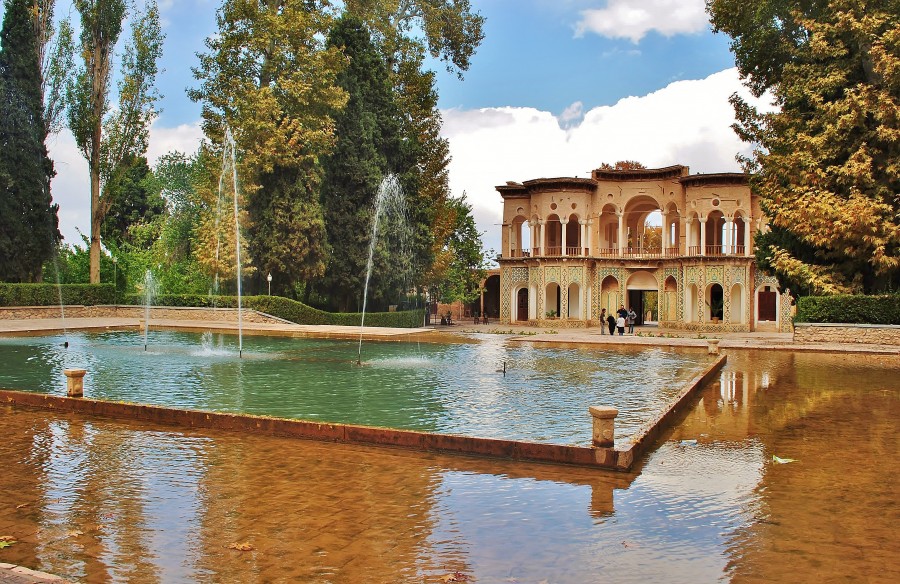
Water cascade in the historic Shahzadeh Gardens in Mahan. Gardens in the desert are one of Iran’s tourist attractions.
For my part, I wish Bam and his people good luck because the rehabilitation project is worth the effort. I saw the ruins of the citadel itself and the layout of some elements and the tower was very impressed. Let’s wait another 10 years. My arrival to Bam was worth it and that is why I urge travelers to do their best.
The road back to Bam was successful too. First I got a taxi to the roundabout, to the main road to Kerman but thought it was pointless to go immediately. To the right was a military base with a large cannon aimed at the sky and a monument to the hand holding the fruit. The palm trees, green on the roundabout and also the rifle behind the grid took me a moment but after a while I felt hungry. When I walked the main route towards Kerman after about 300m on the left there is a good restaurant with ridiculous prices. I got a roast chicken with rice and cola for about Rs 100,000. I felt great.
Then I went the same way towards Kerman and unfortunately got hit by a nameless taxi driver who told me I would not stop any truck and that he would take me to Kerman for good money or to Bam to the bus station. But it was against the adventure that I decided to risk it. Finally, a small Iranian production car stopped, which drove me directly to Kerman.
On the way, interestingly, the police made a raid on drug smugglers . They had dogs, rifles, and set off all trucks and random passenger cars, for routine checks. Unfortunately, they were right because the border hole of Zahedan affects Iran many tons of drugs every year. This route leads from Afghanistan, which I call “narcotics” and then leads through Pakistan to Iran. This road is the only reason why the raids are frequent.Drug traffickers also have other sides such as murder or kidnapping, including European tourists.
As a curiosity I will say that US soldiers guard the cannabis fields in Afghanistan in order to financially support their “democracy.” The war in Afghanistan is not aimed at winning but its continuation because of the free military base in the region, which is burning just by the Americans, and all this occupation of this part of Asia is financed by drug trafficking. So much about America, which dares to ridicule Russia’s exuberant sermons on peace and democracy. Hypocrisy without borders!
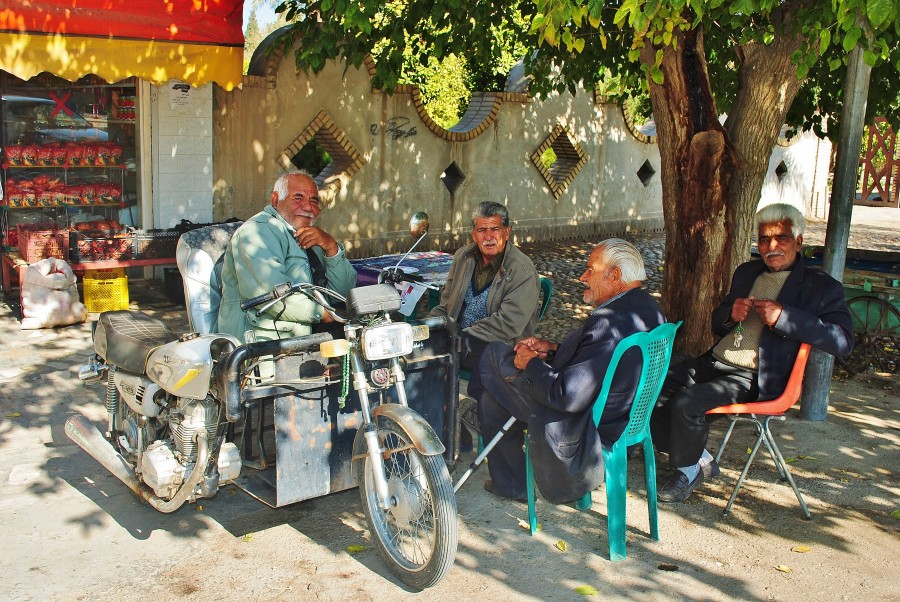
Tabas seniors club. Iran.
Transport from Kerman to Yazd
I was going to get to Tabas, which is not on the route of the most visited places and therefore there was no direct connection to Kerman. So I had to go to Yazd again. I left at midnight and arrived at Yazd at 6am.Tickets cost Rs 95,000.
Return to Yazd
(Stay 3)
I did not plan to come again to Yazd, but since I was here I wanted to be worth the time. When I got to the station about 6am I was not going to hang out until 4 pm. I got into a taxi and for only 40,000 Rial I went to the Old Town. I got off at the Jameh Mosque and then left the backpack in the same hostel as before. I had a few hours to re-take that special place, so I once again visited the avenues of the Old Town. I strolled through the clay walls and went up to some roofs to see the windmills ( badgir ). I also went to the bazaar to see the souvenirs again and listen to the noise from the workshops of copper pots.
About 2 hours before departure, I went to the Amir Chaqhmaq Complex . I sat down in the fountain square and in some way tried to summarize the few days that I recently spent at Yazd. On the day it was not too hot, the wind was blowing and it was nice to just sit and watch the surroundings. At the end I also went to the pub inside the complex where the waiter gave me the kebab and the whole pub again watched me.
About three o’clock I arrived back to the station.
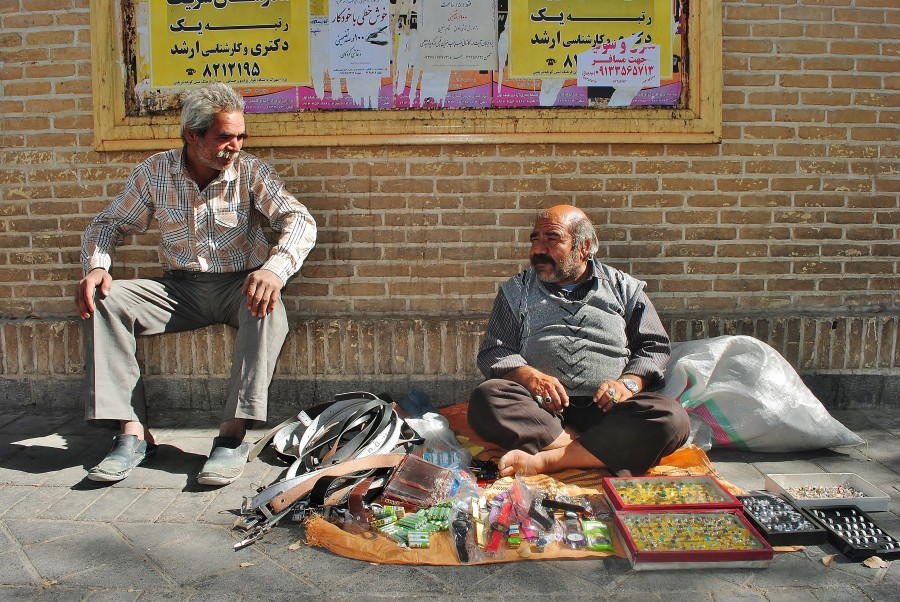
Street vendors in the desert city of Yazd, Iran.
Road from Yazd to Tabas
By train at 8h for 100,000 Rial
Tabas
Tabas is not on the main tourist route and therefore not much of us visit this city. The desert city of about 65,000, however, has a number of valuable sites and is not necessarily a convenient but convenient way to travel north. I came here primarily to arrange a trip to the desert oasis Ezmrighan about which as it turned out even not many locals have heard. On the occasion I also had a very pleasant day at Tabas and I am glad I decided to visit this place.
When I came to Tabas I had a huge problem with the hotel. The bus station was expensive and the other bus was busy. In the end, however, I managed to sleep in the prayer room in one of the roadside hotels.
I arrived late at Tabas and the first thing that struck me was the huge new mosque in the middle of the square near the bus station. This was a huge surprise for me because I did not expect such a beautiful object or rather a temple complex in the middle of the desert. Keep in mind that Tabas is the only city of significant size within a hundred kilometers and therefore Imamzadeh Hossein Nebn Musa mosque attracts Tabas faithful from surrounding villages. It is an object with many mosaic entrances, courtyards and small chapels. There are fountains, palms, great gates ( iwan ), small chapels and high minarets after dark illuminated in green. Both in the day and in the evening it is a very pleasant and built with a huge space, which additionally has many palm trees in its area. This mosque undoubtedly belongs to the art of Persian architecture, but despite all the beauty of art, it occurred to me that the Iranians could not build anything other than the next mosque. Given that Tabas is in the desert, I think a pool with slides and a bar with cool drinks would be more practical and would make more fun when outdoors is 50C.
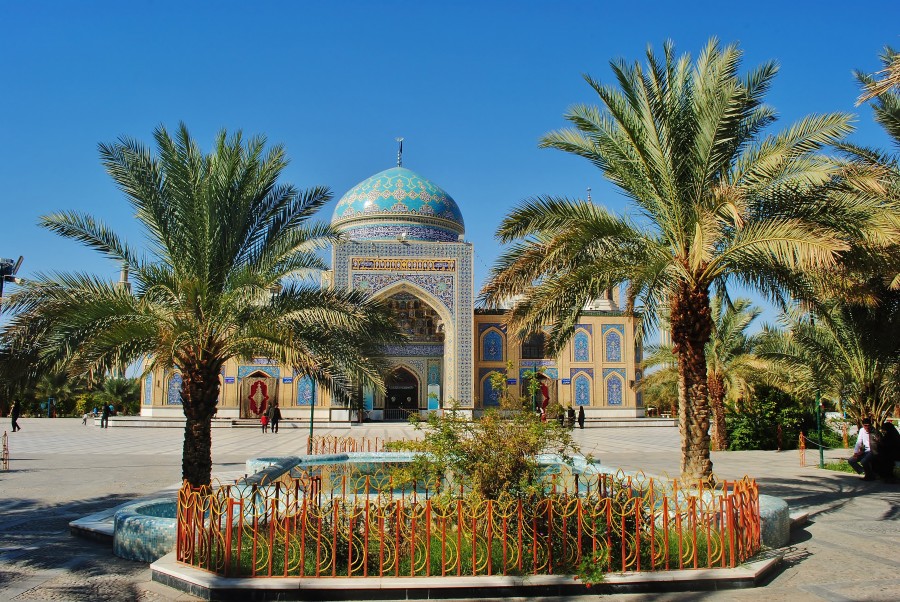
Imamzadeh Hossein Nebn Musa Mosque in the desert city of Tabas. This mosque is also a tourist attraction for Iranians from villages near Tabas.
I also spent a couple of hours in Bagh-e Golshan , which in Persian weather is the salvation for the people of Tabas. It is a park with a wealth of palm trees and citrus trees and with a stream of water flowing through the center. In addition, there are slowly walking pelicans. This park gave me the opportunity to escape from the heat as apart from the secluded atmosphere the trees give a shade. Park Golshan put Tabas in the first place. I add that at the roundabout in front of the park there is a large pelican monument and when I was here was also a street tea. When I got out of here I got on a moped and so I was transported to a small ruin of a 11th-century citadel called Arg-e Tabas . However, these citadel can not be compared to those I have seen in Bam or in Rayen. In Tabas they are only clay walls with a few smaller ruins in the middle of the courtyard. When I was here I was interested in children who always look with curiosity to a newcomer from Europe.
In the evening, I strolled down the street for daytime palm trees and after a short time sat down in a cheap pub where I waited for a traditional Persian meal. While waiting for my shish kebab with grilled tomatoes, I went out to enjoy the warm night and to eat the dates straight from the palm.
Trip from Tabas to Ezmirghan oasis
Ezmirghan is an oasis in the desert that few Persians have even heard of, but among tough travelers this small but beautiful area in the desert has already been photographed many times. Ezmirghan is a place surrounded by a desert where goat herders live, cultivating fields and caring for animals. Among the tall palm trees and the river crossing Ezmirghan there are beautiful vegetation, interesting rock formations and crystal clear water where the bottom can be seen several meters deep. Ezmirghan is a place where lush and exotic greenery and crops of grains, tomatoes and cucumbers are surrounded by sunburned dead earth and a nearby earthen mountain. In Ezmirghan you can see very well that nothing else than water is the greatest treasure on earth.
For the first hour, I walked through the fields and watched the green paradise that could undoubtedly be the setting for many movies. I came to Ezmirghan one way with a taxi driver and on the way back to Tabas I took a group of young Persians who told me how much they hated Islam and Arabs who, in their opinion, are not human. Having been in Iran for almost 1.5 months, I heard many times the dissatisfaction of young people with Islam, but then I did not want to go this way. One of the men had a kettle and a lighter, so we got some water and boiled tea. Afterwards they drove me in their Peugeot 405 with the engine of an Iranian car to Tabas and that was also very nice. In one moment, from a beautiful oasis teeming with life, I was in an empty steppe, burnt by the sun.
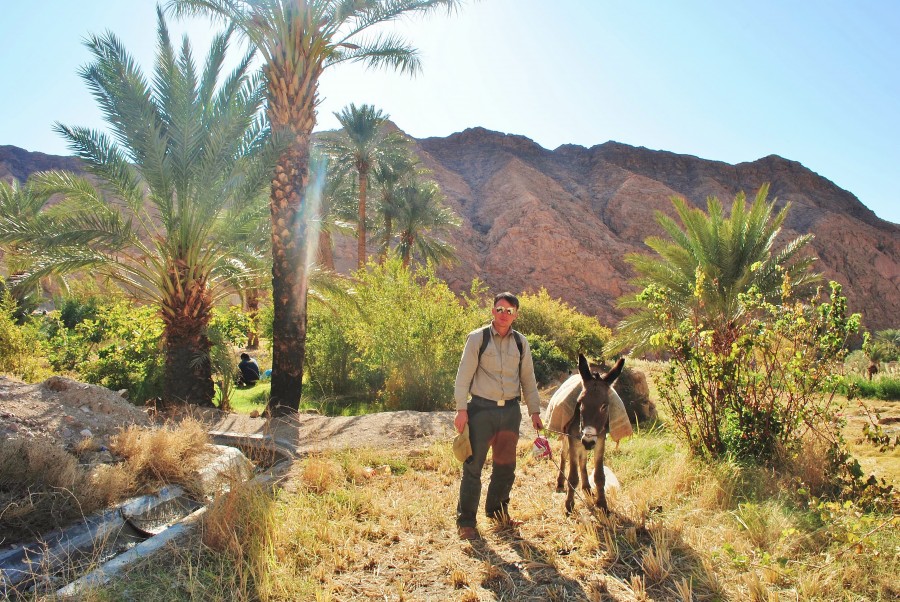
At the oasis of Ezmirghan, on a day trip from Tabas. Ezmirghan is a beautiful, rather unknown corner of Iran.
To Ezmirghan is worth to come so I recommend to stay at Tabas and then arrange transportation through the desert and get here. From Tabas to Ezmirghan I was about half an hour and every person in a shared taxi should at most pay Rs 100,000 per person.
Transport from Tabas to Mashhad
I took the bus at night and it lasted 9h. I left at 8pm and arrived at the Mashhad station at 5am. Ticket cost me a magic sum of 115,000 Rial.
Mashhad
(City in the city – Haram, difficult conversation with the guide about Islam and re-entry to Haram with the Persian who was tired of Islam)
The city of Mashhad lying in the east of Iran is known for two things. Firstly there is a huge and constantly growing Haram temple complex and secondly it is a base for Turkmenistan and for those who do not enjoy life in Afghanistan. Mashhad is Iran’s second largest city, whose population has grown rapidly during the Iraqi-Iran war, since it is the easternmost city of the line of fire. Over the years it turned out that although many people came only to wait for the war, yet many remained.
Today Mashhad is a tourist center for many Iranians, including young couples who come to Haram to bless their marriages. At first glance it is clear that a large part of the income of the city comes from tourism. The main street in front of the Haram complex is full of photographic salons where Muslims can computerize their likenesses in various forms against the background of the most famous Haram objects. I asked them if they could do the same for me but before the Vatican, which unfortunately did not cause ovation.
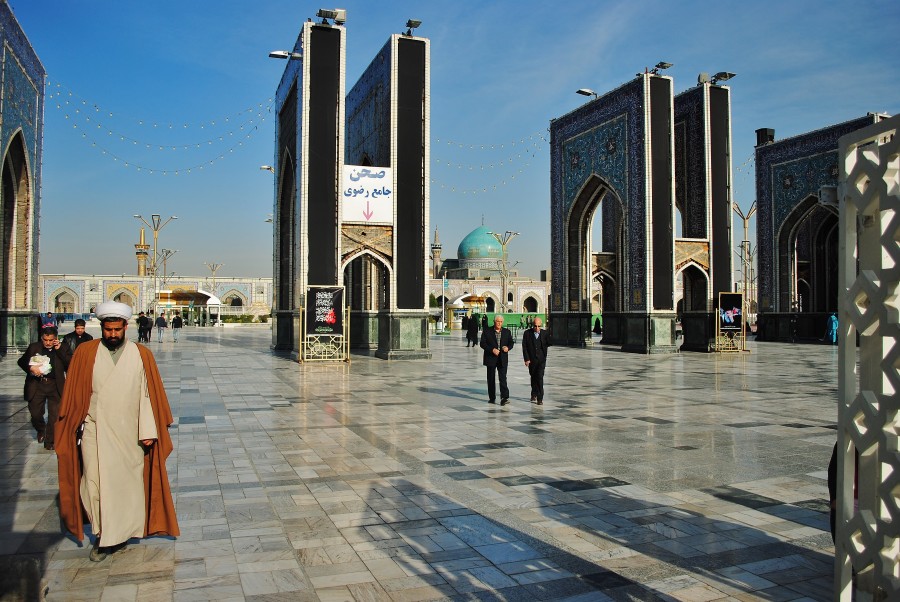
Haram Temple Complex in Mashhad City, Iran.
When I left the bus station I went free to Haram, which is about 2.5km away. On the way I stopped to watch the city and its people and from the first moment I knew it would be an interesting experience. Haram is a combination of huge courtyards covered with Persian carpets with large, dome-shaped domes, magnificent minarets, exquisite mosaics and statues and arches. When I appeared in front of the entrance I was told to wait and after a while the guide who took me around the property took me away. Some mosques and mausoleums are only for Muslims, and I was just introduced to a guide who followed this principle. As for the mosques, blue domes and high mosaic minarets, of course they were very spectacular but they were also elements that kept repeating during my journey. Probably why I was most interested in very interesting museums, such as the Calligraphy Museum exhibiting antique crowns, museums where there were seashells and fish and Carpets Museum .
In the same building was the old sarcophagus of Imam Reza, and as far as I knew they were 6 because people in the rush of faith lay on him at the same time destroying it. There was also a collection of postage stamps in the museum building, one of them depicting the takeover of the American embassy in Tehran.Hate to America is felt in many places in Iran and it is culturally conditioned. Even when I was waiting in front of the Haram gate, the guard asked me if I was not from America because if that was the case, he would give me a knife. Fortunately, the Pole is harmless here.
I also had an embarrassing conversation about the Prophet Mohammed and his relationship with the 6 year old girl he married when she was 9 years old. I assure you that this conversation was uncomfortable for me because of the place I was in, but it was also uncomfortable for a student of Islamic philosophy who wanted to defend Islam. He said it was a matter of dreaming of the greatest Islamic theologians, but in their opinion, if the prophet had done so, it would have had a good purpose. We also talked about whether or not it was okay for women to cover themselves with black sheets, and in that matter was unyielding, even though there was nothing in the Koran to cover the whole body in this way. But he could not answer what was good. My guide also took me to the Foreign Pilgrim’s Office where I got a free book about Haram and a set of photos and where everyone was extremely nice. It seems that they wanted me to remember Haram as a place to rest. Unfortunately I could not enter the mausoleum where Imam Reza’s sarcophagus was located, but then I did not know that I would still be able to enter there. With this very conservative guide, however, it was impossible. At last I gave him a hand and thanked him for showing me.
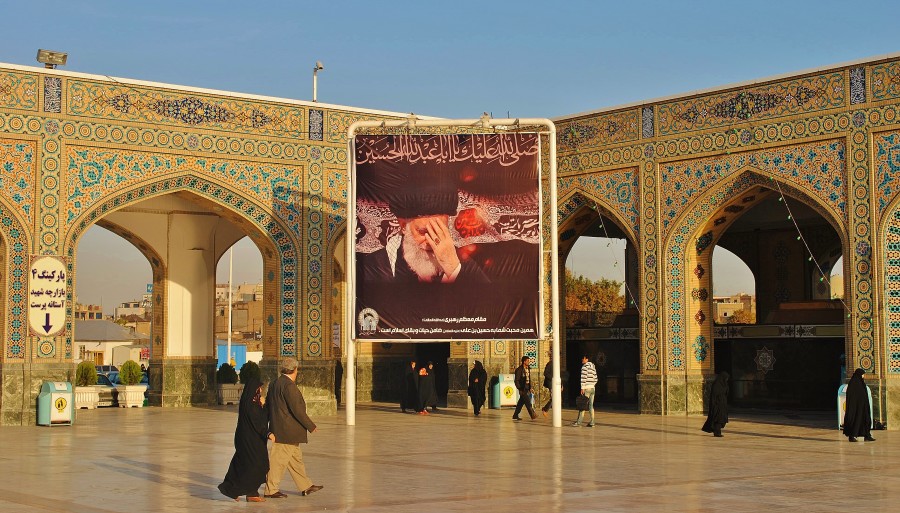
Ali Khamenei – he is so good that he cried. Haram temple complex in Mashhad, Iran. In my opinion, what’s the point for more mosques? Iran already has plenty of them. Couldn’t they spend that $2 billion on health care or plant a second Richmond Park like the one in London? Iran has been competing with Saudi Arabia for years to become the center of Islam.
Haram is very well organized. At the entrance I had to leave my backpack and then as a “foreign pilgrim” I entered the facility with a guide. Haram photography is forbidden, but you can take pictures with your phone.
When I went out of Haram I was lucky because at the recently restored mosque 72 martyrs from the 15th century met a cheerful restorer of monuments who needed contact with a tourist and who turned out to hate Islam. He said he could bring me again to Haram and even to the mausoleum where Imam Reza’s sarcophagus is located. Meeting him was a very interesting experience not only because of seeing Haram and Imam Reza without official gravity but also because of what young people like him think of Islam. We went to the locker room to leave my backpack there and then once again entered Haram territory.
Turning from one courtyard to another, among the people sitting on the carpet and looking again at the blue domes, we entered quietly into the seventeenth-century Holy Temple , which, in the non-Muslim theory, is forbidden. It is a temple with a golden dome, which is the center of Haram, because inside, there is a sarcophagus with the tomb of Imam Reza in the interior of the well-decorated room. This sarcophagus was mentioned in 2001 and the chamber itself is a work of mosaic art, mainly in green and gold colors. My relaxed Iranian guide said that those who come here are idiots for whom Islam is important only, and having lived in Mashhad since birth is not good for Islam. When I said the whole area was very spectacular and worth getting to know the tourist he just waved. Anyway, I saw something I did not see. Conversely, the people inside the mausoleum were in a state where the religious takeover was bordered by fanaticism.They pushed themselves and the sarcophagus to finally rub his hands and then their faces. In their opinion it was “rubbing” the holiness of the sarcophagus on itself. I have not seen such Iranians. Meanwhile, my new Iranian friend was so against the religion that he laughed at them. I asked him what he thought of Christianity and he said he was better than Islam but if he had the choice he would choose Protestantism because Catholicism is a bit crazy. Then he patted my shoulder and apologized. Our time together has not ended yet.
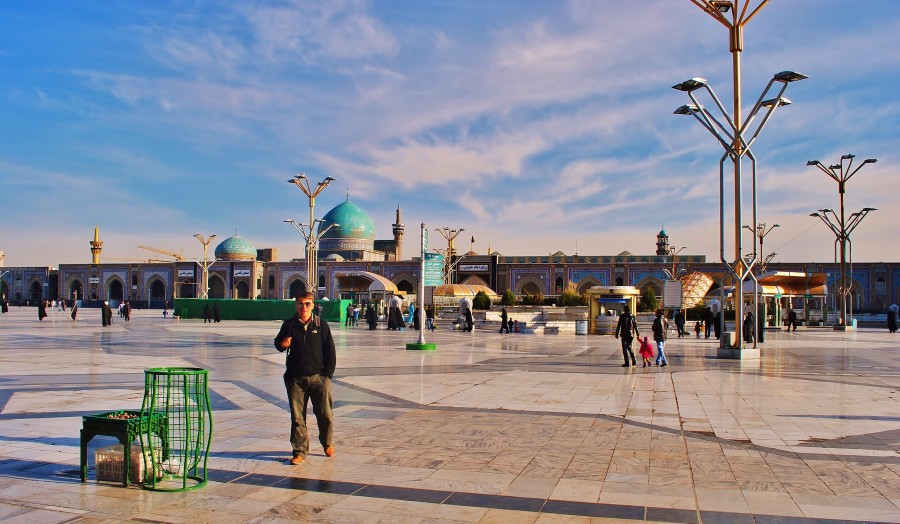
Haram Temple Complex in Mashhad City, Iran. The could build a hospital there, a horse racing place, or a water park. It would make sense in this hot country.
Then I picked up my luggage from the Haram dressing room and walked down the Mashhad streets because I wanted to see more than just a city in the city. I quickly realized that Mashhad is a crowded, polluted bazaar because it looks like a city. I expected to see something else but after a short walk we reached the Nader Shah mausoleum with a characteristic horse chess statue. This place is not stunning though.
There is a small park, which makes it breathtaking in comparison to the streets, but there is also a monument and a museum that look like a vulgar mass from the time of Khrushchev. Nader Shah is also considered a tyrant in the Middle East, while in Iran he is a local hero. In any case, this object is another mausoleum, a place in honor of the dead martyrs in the city. Besides, in Mashhad, besides Haram, there are two other mausoleums, but mentally I had no strength to continue mortifying and I was unable to accept even more blue domes that day. I was sick.
For this reason, we boarded the bus and drove to Kuh-e Sangi , a rocky hill surrounded by ponds, from which Mashhad can be seen. When we were at the top my guide showed me the trees downstairs and said his regime one day drove them out and would of course insert Haram while in the city itself would not be breathing. I understood that while Mashhad is promoted at the center of Islam, there are people who have enough. On the way back I saw a man walking with his little daughter, perhaps 5 years old, and dressed her up in a black sheet. She was happy because she probably wanted to look like a mom, while several people on the bus looked at her and her father for a few idiots.Mashhad and the whole of Iran are very divided. After a while I said goodbye to my guide and he died in the crowd. I think he was happy to talk to me because I was his link with the world he wanted to belong to but he and many others will be in Iran and will be unhappy. But he could not understand that Europe was neither paradise nor has problems with Islam, with liberalism, with false democracy and many other things.
As it usually is in Muslim countries, the Haram temple complex has not originated from a happy cause.Haram was created in honor of the murdered Shia Imam Reza, who was killed in the hellish circumstances in 818, which today brings great financial benefits to the Muslim regime of Iran and at the same time effectively competes with Saudi Arabia for being an important theological center.
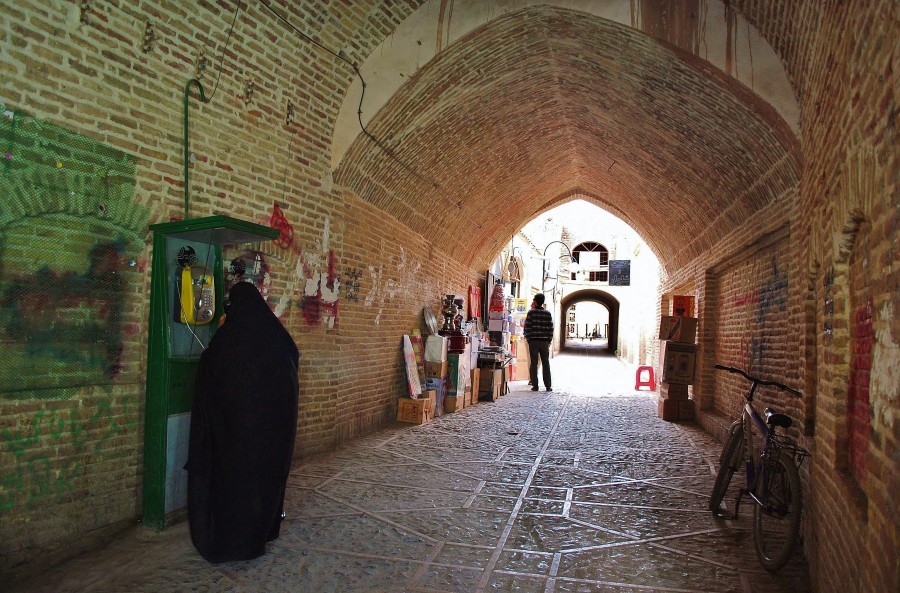
A Muslim woman in her stylish outfit. Iran.
The faithful who visit this place act as if Imam Reza was murdered yesterday and as if they knew him well. They put a lot of money into his sarcophagus, which pump up the local economy, and at the exit (I saw it with my own eyes) they touch the doorframes and then themselves, blessing themselves in this way. In general, the atmosphere here is “thoughtful and starred” to use the correct term, while the striking objects and carpets made in Mashhad in the Haram courtyards take a long time. However, the very people without whom Haram could not exist are important. For them, this never-ending temple complex is of great importance and is a huge part of their national identity. Haram began as a small chapel of Imam Reza, which began to attract more and more pilgrims and thus gave life to the city of Mashhad (city of martyrdom).
Over the next centuries, Haram was expanded in small steps, but the breakthrough came in the 20th century. In 1928, non-religious buildings were demolished to expand Haram within 180m from Imam Reza’s grave, and then in 1979 enlarged to 360m around his grave. In this way, a city within the city was created and there are already plans to enlarge it again. At times like this, I wonder if it would be better to invest this money in education, in nature conservation, in the health system, or in infrastructure, rather than another super mosque. Well … this is Iran. Returning to the station, I stopped at photo salons offering souvenir photos with the Haram background, and I also stopped at a traditional Persian restaurant.
The question that is worth asking yourself is whether it is worth coming to Mashhad, considering that a similar place, Qom, is only a few hours from Tehran. I think that persistent travelers will definitely come here at least once, it is enough. Let us also pray that, due to the political correctness and the open-door policy, we would not have Haram in European capitals, although I think that if we were to collect all the mosques in Europe, we would have Haram and Qom and many other such centers. To sum up, for a Christian, Haram was an interesting experience that enriches his travel experience.
Road from Mashad to Teheran
From Mashhad I left at 10 pm and it was undoubtedly the heaviest transport during this expedition.
I consider that I have been on the road for 3 months and have had many nights in a cold tent on hard ground and on bus seats. I felt that with my return to Tehran I did something great because I made my plan for the Caucasus and Persia. But I also felt that my travel time had already ended. When I got to Tehran, at least for a while I had the impression that I had enough.

Traditional Persian food. I recommend.
For a ticket I paid 180,000 Rial and the trip took 12h. The night was already cold because it was November and the drive became more and more tiring. The worst was the traffic just before Tehran.
Return to Tehran
(Stay 4 – my last)
I arrived in Tehran early in the morning. I got to the subway and drove straight to the cheap Mashhad hostel near Imam Khomeini. Although I had to leave the same day and so I bought a stay for the whole day. I had to sleep, bathe, find the luggage that I left here and repack. I spent the rest of the day on a traditional bazaar where I made my last shopping. I bought a few parcels of dates, several types of floral teas, a suitcase and a couple of home accessories. It was a good time for me to say goodbye to Iran. For the first time I also went to the other side, also to the shopping district where I bought a belt and two pairs of Iranian shoes. To get there, take the Imam Khomeini to the German embassy and the Turkish embassy next to you. Then turn right and there is a great selection of any goods.
When it came time to go first I took the subway to the south station and from there I took a taxi for 200,000 Rial to the airport because it was so cheap. Being at the airport I had a nice meeting with a girl from the store who invited me for tea and was interested in talking to me. She had big eyes, full lips and round shapes. Persian cat, as I call it.
Soon I flew to Istanbul (Constantinople).

Ice House in Kashan. It’s a good food freezing solution without electricity, and it fits well in the desert landscape of Iran.
The summary of Iran
Iran or Persia, if you prefer, turned out to be a unique experience in my travel career. I spent a month and a half there and was in all parts of Iran, which made me get to know all its sides better. Iran is a country of desert, spectacular mosques with blue domes, and a country of art, gardens and interesting rock formations. Iran is also a country of world-famous Persian carpets, dates, the country of ancient Persepolis and such UNESCO riches as Esfahan, Shhiraz and Yazd, which looks as if it was made from the desert. Due to the hate propaganda, the Israeli prime minister would add that it is also a country of nuclear power plants and the Muslim regime, but for me it was an irrelevant matter because I left politics outside Iran. Persia has a history of many thousand people and people who are nice and open to tourists, which makes the image of a Muslim terrorist created by the media a rather sporadic departure from reality.
It is also difficult for me to choose what I liked the most because some elements, such as mosques, were similar to each other. The gardens, the Kaluts rock formations in the desert near Kerman and the old town of Yazd deserve a separate attention. I also had a lot of fun on Qeshm Island in the Persian Gulf. As we can see, Iran is very diverse because, for example, the temperate part (on the Caspian Sea) is completely different than the sun-scorched desert of the Persian Gulf and different from the Alborz mountains. I think that future travelers should definitely see the traditional tourist trail and a few off-road places and should always treat Iran as an interesting adventure, because that’s what it is all about. Sleeping in a tent, hitchhiking and tasting Persian food also give you many opportunities to meet people. I consider the presence at the bazaar as obligatory because there is real life going on …… and if we buy a carpet, so much the better.
I consider my trip around Iran very successful and educational.
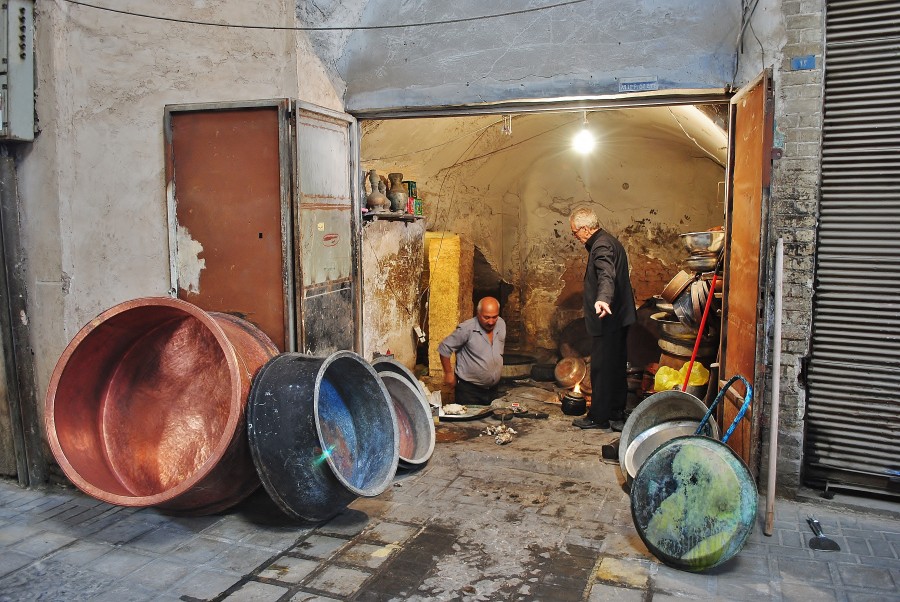
Workshop with copper pots. It is one of the traditions of Iran, and I recommend that you buy at least one. Please don’t worry if it doesn’t look smooth. It cannot be, because it is hand-hammered by a blacksmith.
Other notes about Iran
• Why didn’t I go to see Choq Zanbil? Because this 3,000-year-old ruin of a pyramid standing in the desert near the border with Iraq is extremely off the road. In addition, it is an object that, according to the opinion of most travelers, is not worth going to it through the desert and may turn out to be a disappointment in relation to the expenditure of resources to get there. This is why I decided to see the citadel of Bam and Rayen, the Kaluts rock formations and small towns near Yazd instead. If someone wants to invest their time and go to Choqa Zanbil, the best place to go is the night bus from Shiraz to Ahvaz and then to Shushtar. There is also another object called Shush next to it. Usually, before I decide to go to places separate from my route, I do a detailed research and decided to avoid this monument.
• Another place where I didn’t go is Orumiyeh Lake, which according to Polish tourists guarantees beautiful views and it is easily accessible from Tabriz.
- Alamut Valley
- Ali Khamenei
- Ali Sadr water cave
- American embassy in Iran
- ancient Persia
- Ayatollah Khomeini
- Bandar Abbas
- Castles of Assasins
- desert in Iran
- Esfahan
- flying carpet
- Haram Muslim center
- Hormoz zone
- Iran food
- Islamic Republic of Iran
- Kaluts-sand castles
- Kandovan
- Khomeini mosque
- Mashhad
- merchants' houses in Kashan
- Naqsh-e Rajab
- Naqsh-e Rostam
- Persepolis
- Persian bazaars
- Persian Empire
- Persian gardens
- Persian Gulf
- Qeshm island
- Qish Island
- Qom
- Shi'ite Islam in Iran
- Shiraz
- supreme leader of Iran
- Tabriz
- Tehran
- Yazd



































